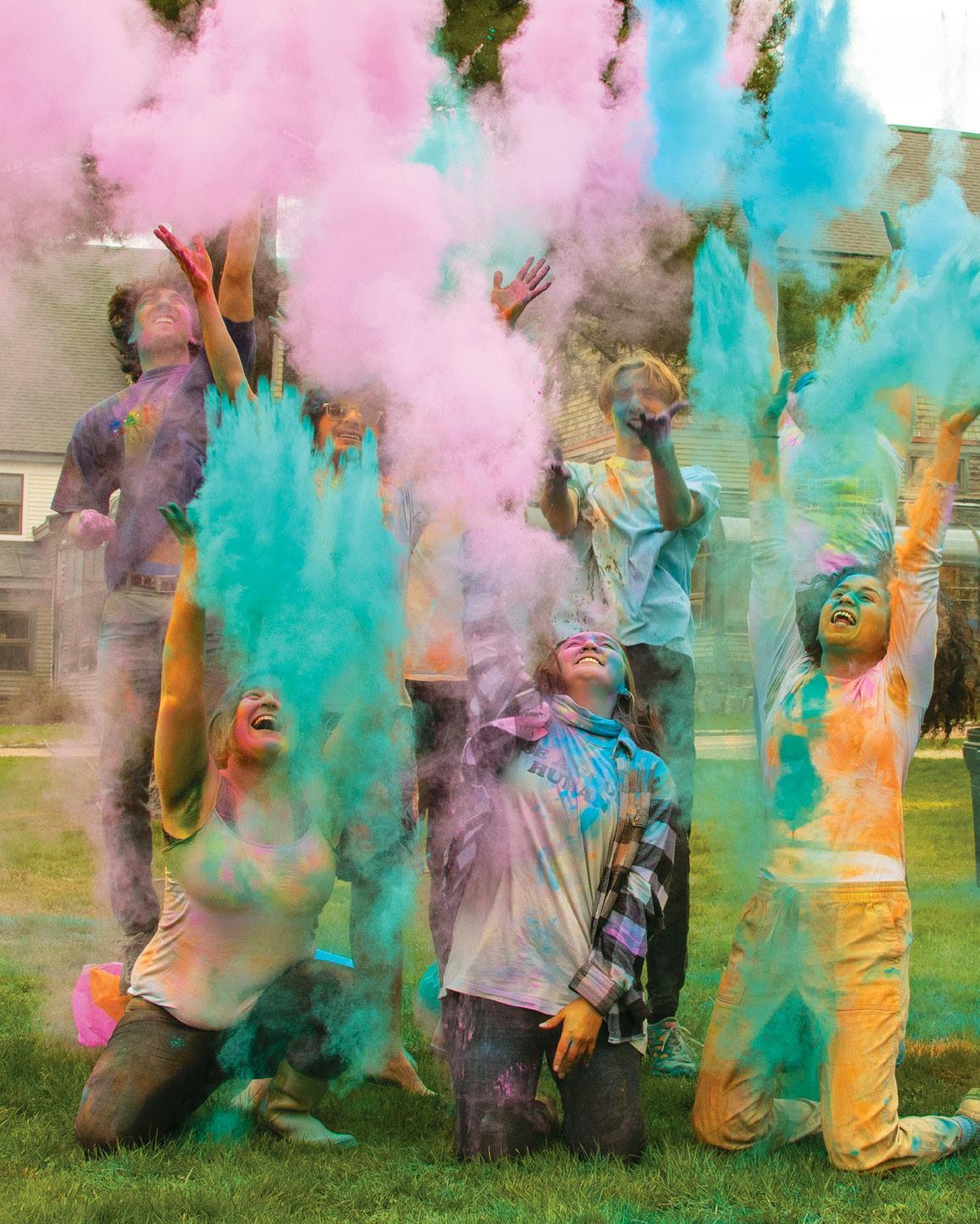

COLLEGE OF THE ATLANTIC
Philanthropy Report | Fiscal Year 2023
BOARD OF TRUSTEES 2023
TRUSTEE OFFICERS
Beth Gardiner, chair, London, UK
Marthann Samek, vice chair, New York, NY
Hank Schmelzer, vice chair, Somesville, ME
Ronald E. Beard, secretary, Bar Harbor, ME
Clay Corbus, treasurer, San Francisco, CA
TRUSTEE MEMBERS
Cynthia Baker, Washington, DC
Timothy Bass, Washington, DC
Michael Boland ’94, Bar Harbor, ME
Joyce Cacho, Washington, DC
Alyne Cistone, Mount Desert, ME
Sarah Currie-Halpern, Boulder, CO
Heather Richards Evans, Wilmington, DE
Allison Fundis ’03, Vallejo, CA
Marie Griffith, St. Louis, MO
Cookie Horner, Bar Harbor, ME
Nicholas Lapham, Washington, DC
Howard Lapsley, Needham, MA
Casey Mallinckrodt, Denver, CO
Anthony Mazlish, Chevy Chase, MD
Chandreyee Mitra ’01, Aurora, IL
Roland Reynolds, Alexandria, VA
Nadia Rosenthal, Bar Harbor, ME
Laura McGiffert Slover, Washington, DC
Laura Z. Stone, New York, NY
Steve Sullens, New York, NY
Claudia Turnbull, Greenwich, CT

and
LIFE TRUSTEES
Samuel M. Hamill, Jr., Princeton, NJ
John N. Kelly, Yarmouth, ME
William V.P. Newlin, Washington, DC
TRUSTEES EMERITI
David Hackett Fischer, Wayland, MA
William G. Foulke, Jr., Bedford, NY
Amy Yeager Geier, Santa Fe, NM
George B.E. Hambleton, Charleston, SC
Elizabeth D. Hodder, Cambridge, MA
Jay McNally ’84, Bar Harbor, ME
Philip S.J. Moriarty, Hinsdale, IL
Cathy Ramsdell ’78, Portland, ME
Hamilton Robinson, Jr., New York, NY
William N. Thorndike, Boston, MA
John Wilmerding, New York, NY
EX OFFICIO
Darron Collins ’92, president, Bar Harbor, ME

We may be an unlikely college, but we are essential… to communities around the globe where human ecologists are helping to solve some of the world’s most pressing challenges.
Dear COA donors,
This publication, titled The Philanthropy Report, could also be titled, The Donor Impact Report. At COA, philanthropy and impact go hand in hand. Your generous gifts—whether inspired by our students, our mission, or as may be the case for alums, a desire to give back to a college that helped shape you—have real and tangible impacts on our students and the study and practice of human ecology. And the wonder of education is that these impacts only grow as students move into the world, applying their knowledge, values, and skills to challenges we face.
Our hope is that this report brings you a little closer to the program we offer here at COA. Through faculty and staff reports on endowed chairs and funds, you’ll get a window into the types of classes, field experiences, and other opportunities donors have made possible for our students. I hope you’ll take a moment to read through our year in review (pages 4–5), peruse the scholarships we awarded students (pages 35–40), consider the magnitude of investment the Davis family has made in COA through the Davis United World College Scholar Program (page 6), and look for your friends on the donor lists.
You may notice some funds that honor people who are no longer with us, but whose generosity lives on thanks to their forethought and our careful management of their funds invested in our endowment.
Most of all, I hope you take pride in being among an amazing community of supporters who share our belief in the power of an education in human ecology. We may be an unlikely college, nestled here on the coast of Maine between Frenchman Bay and Acadia National Park, but we are an increasingly essential college. Essential not only to our local community where so many of our alums have made their homes and livelihoods, but to communities around the globe where human ecologists are helping to solve some of the world’s most pressing challenges, and to the world of higher education that continues to incorporate COA’s approach to education.
Our impact—your impact—is growing.
With gratitude,
Shawn Keeley ’00 Dean of Institutional Advancement
2,475 GIFTS 1,197 DONORS $12.7M OVERALL GIVING AND PLEDGES
FINANCIAL SUSTAINABILITY
This fiscal year our donors contributed $1.6M for the college’s Annual Fund, the highest amount ever. Broad Reach Capital Campaign pledge payments, new gifts to endowment funds, and contributions to new and ongoing projects added another $11.1M for a total of $12.7M raised.
Each and every one of our 1,197 donors were a part of this success. Thank you all!
ENDOWMENT
Global financial markets showed significant year-over-year improvement in returns over the course of FY23 (+15.4%) versus the returns of FY22 (-16.8%). This performance, along with additional Broad Reach Capital Campaign receipts, moved the COA endowment from the $69.7 million mark on June 30, 2022, to $78.8 million on June 30, 2023. The three- and five-year annualized returns of the endowment stand at 7.4% and 5.9% respectively as of the close of June 2023.
The generosity of our supporters sustained the college through the challenges faced in the global asset markets of 2022, as well as in the everyday life of the college’s annual operations. Our annual endowment draw represents a vital source of funding for program operations, equating to roughly $9,450 in annual revenue per student for the 2022–23 academic year. The following pages include reports of the many funds within the endowment and how they support the fulfillment of the mission of the college.
$100M
$80M
$60M
$40M
$20M
$0
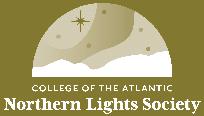
JULY: Boston-based artist Sophie Tuttle created a mural on the back of Thomas S. Gates Jr. Community Center over the course of one week during the 2022 Summer Institute, Our One and Only Ocean, held in partnership with The National Geographic Society. The mural features humpback whale migration routes (representing Allied Whale research) and sea birds (representing
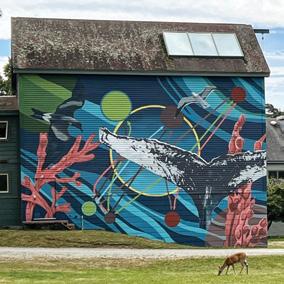
YEAR IN REVIEW 2022
SEPTEMBER: The COA Mount Desert Center and The Salt Market (owned by Maude Kusserow ’15) opened on 141 Main Street in Northeast Harbor. This year-round project, including housing for 15 students and a staff/faculty apartment, was the result of a collaborative partnership with Mount Desert 365.
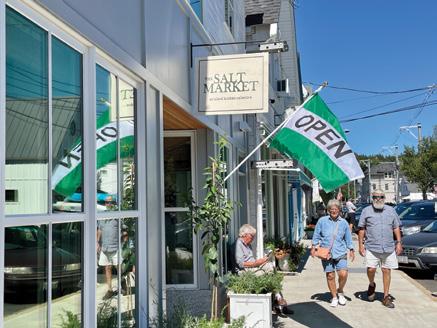
NOVEMBER: The “Bed Subcommittee,” a team of speedy COA students, won the Bar Harbor Bed Races (part of the annual Pajama Sale) in a course-breaking time!

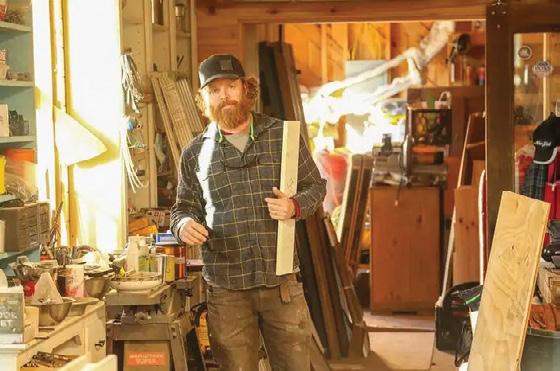
AUGUST: Chase Morrill ’00 of Maine Cabin Masters joined our Coffee & Conversation series with host faculty member Heather Lakey ’00, MPhil ’05. The pair discussed Morrill’s journey from COA to a beloved TV show that profiles his work restoring historic Maine cabins.
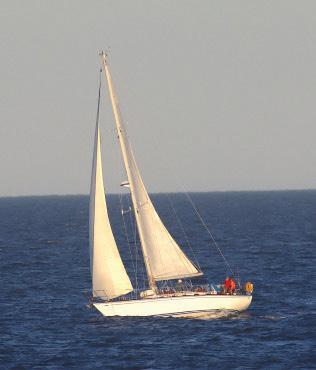
OCTOBER: Off-shore research, coastal island expeditions, and novel ways to extend COA classrooms onto the water are all part of the program for Rebecca, a 44-foot sailboat restored by scores of COA students and launched in October 2022.

DECEMBER: Doreen Stabinsky and Ken Cline took seven COA students to the 15th Conference of the Parties of the Convention on Biological Diversity in Montréal, Canada. In addition to hearing prominent speakers such as the Prime Minister of Canada and the Secretary-General of the United Nations, students were able to attend two weeks of intense negotiations over the future of the world’s biodiversity. The COA delegation worked to improve legal documents pertaining to the conservation of biodiversity that came out of these negotiations.
JANUARY: COA’s outdoor leadership program helps students develop wilderness survival skills while generating confidence, building community, and experiencing the beauty and awe of Maine’s rugged landscape. Dozens of COA students take part in the program, becoming Wilderness First Aid certified in the process. Many of these students will lead COA Outdoor Orientation Programs (OOPs) trips for incoming students in the fall.
MARCH: COA hosted three performances of César Alvarez’s avant-Americana musical Futurity, which looks back to the Civil War to raise questions about the role of technology in
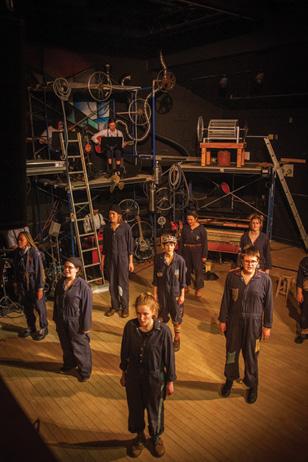


warm themselves by the fire and share how the college has influenced their lives. Our community truly stepped up, contributing a total of 495 gifts over the 24 hours. We exceeded our goal of $100,000 to unlock an additional $100,000 in matching gifts for a grand total of $232,681!
MAY: Culture Week, organized by
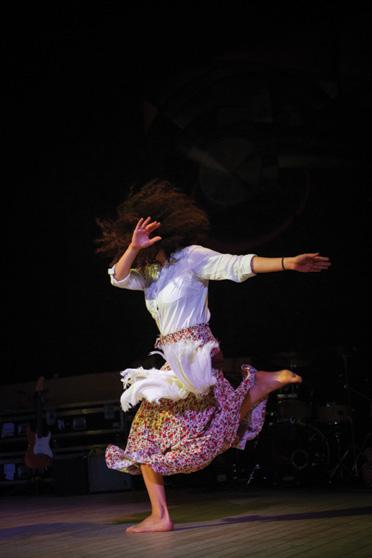
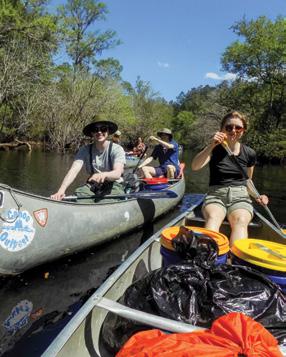
APRIL: Ken Cline taught his Human Ecology of Wilderness class for the first time in 12 years. This interdisciplinary class culminated in a two-week field trip to Georgia and Florida to visit the Okefenokee National Wildlife Refuge, Cumberland Island Wilderness, and the Suwannee River, where students were able to witness and apply course concepts.

going on guided hikes, kayaking, and taking trips out to Great Duck and Mount Desert Rock. The event culminated with a lively performance by ’80s cover band Destroy Them My Robots.
The Davis United World College Scholars Program
Shawn Keeley ’00, Dean of Institutional Advancement
The moment College of the Atlantic and the Davis UWC Program joined forces is arguably the most important moment in COA’s 52-year history. After 13 years as president here at COA, one of the things I will miss the most upon my departure is the constant learning I experience from engaging with these absolutely incredible students. The extraordinary commitments of the Davis Scholarship Program has helped catalyze an entire generation of students who will make fundamental improvements to the world around us.
—Darron Collins ’92, COA President
Throughout our campus and in this report, you will see the impacts of the Davis family in academic buildings, student residences, and funds like the Expeditionary Fund (pages 44–45), all of which have greatly enhanced our college. But the Davis UWC Scholars program stands out as having the greatest impact on COA’s cultural and learning environment.
From the fall of 2000, when COA was part of an initial five American colleges to enroll Davis Scholars, to today, the number of Davis United World College Scholars has reached an astounding 13,544 with 99 colleges
participating in the program. Among these colleges, COA has the highest percentage of its student body—over 20%—made up of Davis Scholars. With these scholars representing a full fifth of our student body, nearly every aspect of the COA experience— academics, student activities, food, culture, language, religious studies, etc—is enhanced by the international context they bring. The study and practice of human ecology increasingly confronts intertwined challenges that often have a global context. Our students’ abilities to understand different perspectives is greatly enhanced by friends and

classmates who come from places very different from their own. This was the goal of founders Shelby Davis and Phil Geier when they set this program in motion.
When you visit COA today, it is clear that the college has become a hub of international thought and culture here in Maine. COA, our local community, and our global communities have all benefited immensely from this program. To learn more about the impact of the Davis United World College Scholars program at COA and beyond, visit davisuwcscholars.org.
TOTAL SCHOLARSHIP FUNDING FOR DAVIS SCHOLARS SINCE THE PROGRAM BEGAN IN 2000 DAVIS UWC
71 DAVIS SCHOLARS CURRENTLY ENROLLED
17 COUNTRIES REPRESENTED BY CURRENT DAVIS SCHOLARS
$34.9M
20% OF COA STUDENTS ARE DAVIS SCHOLARS
277 COA GRADUATES ARE DAVIS SCHOLARS
23 YEARS THAT DAVIS SCHOLARS HAVE ATTENDED COA
ENDOWED CHAIRS
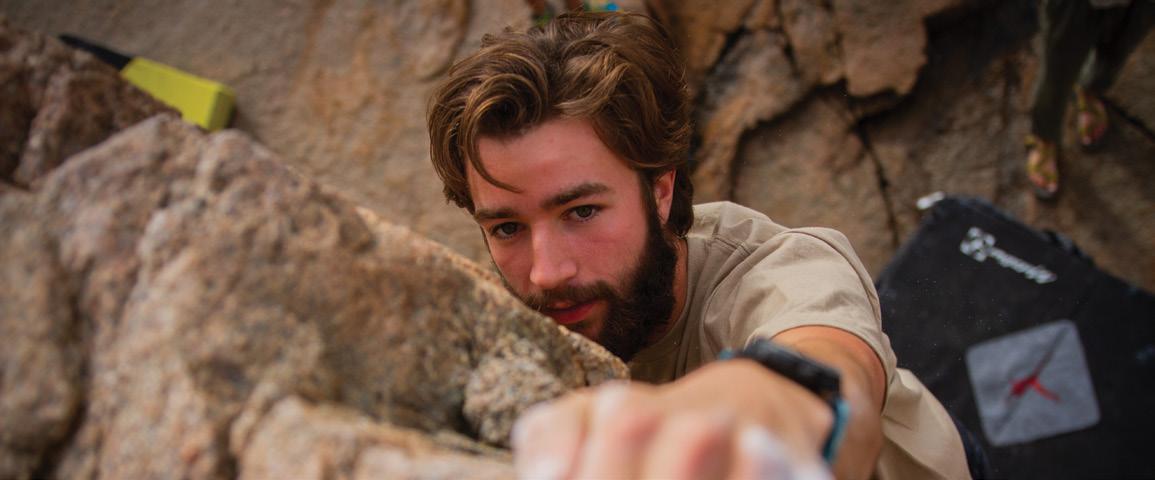
Anne T. and Robert M. Bass Chair in Earth Systems and Geoscience
Chairholder: Sarah R. Hall, PhD
The Bass chair funds a range of field and lab-based opportunities. During the fall and winter terms, I taught a total of 43 students and mentored 16 student advisees. I served as the EcoLeague and Goldwater Fellowship campus representatives and served on the Faculty Development Group. With students and local collaborators, I continued work with partners at Acadia National Park and the Mount Desert Island Biological Laboratory on local and regional water quality research projects. Externally, I completed my second term as president of the Geological Society of Maine and served as a Cooperating Curator of the Hudson Museum at the University of Maine.
Courses I taught during the 2022–23 year:
• Geology of MDI (fall): This field-based course introduces students to various topics in geoscience through the exploration of the MDI bedrock and landscapes.
• Dynamic Landscapes (fall): Building on introductory geoscience, this new class asked students to consider the vast time and space scales impacting landscape features. We spent a Saturday exploring sites throughout the
Anne and Bob Bass established this endowed chair in 2011 as part of the Life Changing, World Changing Capital Campaign.
Penobscot Bay, considering how geologic and human activities shape the coastal Maine landscape.
• The Anthropocene (winter): In this course, which I cotaught with faculty member Netta van Vliet, students read current and historical text from the scientific literature, human studies, and the current media to consider questions about difference and to experience and exercise translation between disciplines.
• Geology of National Parks (winter): In this course, students learned the principles of geology through the lens of US National Parks. They each chose a national park from anywhere in the world to study throughout the term and built a story map using the ArcGIS Online software.
In May, I traveled to Costa Rica for two weeks to participate in part of the Tropical Ecology Monster course with faculty member Steve Ressel and Dorr Museum Director Carrie Graham. With my training in tectonic geomorphology and paleoclimatology, the landscape of Costa Rica was a perfect location for me to supplement student learning as a visiting geoscience faculty member.
During my spring 2023 sabbatical, I made up for missed travel due to the pandemic. I studied and worked with colleagues and students in the Yucatán. While part of my time in Mérida was dedicated to language learning, I also have been gathering information for adding a potential future field course in that region. I hope to connect landscape forming processes to the rich cultural learning opportunities students have through our existing Spanish language immersion program based there.
During the 2022–23 academic year, I worked with students Delphine Demaisy ’26 and Ludwin Moran Sosa ’24, who assisted with water sample collecting, curricular resource creation, and outreach to local schools. Another work study student, Lily Dutton ’25, focused on documenting and visualizing the recent land-use history of the Breakneck Watershed. Six students conducted extended independent study subprojects which they presented at the Acadia National Park Science Symposium: Ben Capuano ’23, Adam Feher ’23, Lenka Slamova ’24, Ludwin Moran Sosa ’24,
Lily Dutton
’25, and Joshua Harkness ’25.
During the 2023–2024 academic year, I’m on unpaid leave to pursue a Science & Technology Policy Fellowship sponsored by the American Association for the Advancement of Science. I am stationed at the US Geological Survey in the Washington DC area and am working as part of the Natural Hazards Mission team, specifically focused on landslides and other geohazards.
During my time at COA, the thing that has resonated with me most is the trust and responsibility that is placed in students, enabling us to contribute to and actively shape our own education. Through the classes I have taken, I have been able to expand upon my education without traditional boundaries. At COA, every discipline converges to address realworld challenges. COA is more than just a college; it’s a living, breathing community where I’ve had the chance to explore not only my academic interests but also my place in a complex, interconnected world.
BEN TROUTMAN ’24
333,203 Contributions 0
$2,479,501

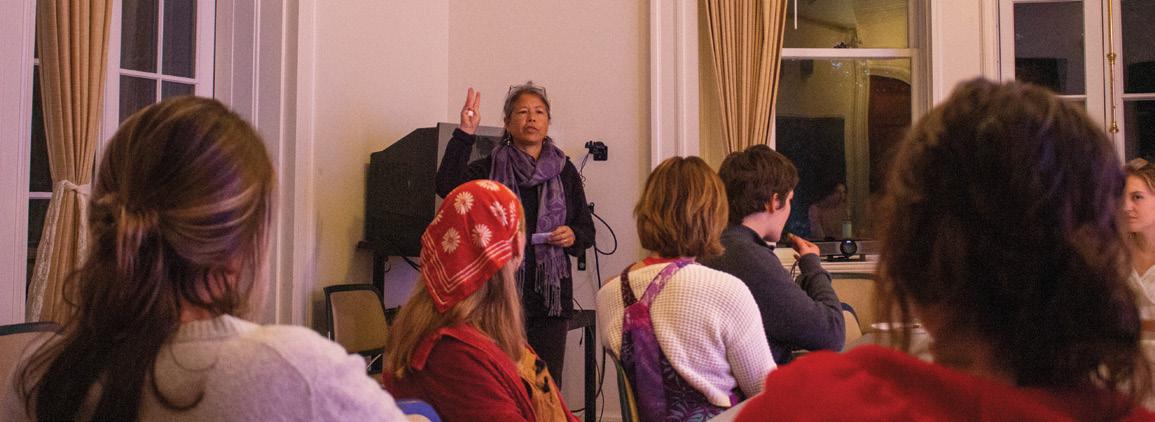
Richard J. Borden Chair in Humanities
Chairholder: Bonnie Tai, EdD
My teaching and advising last year contributed to the Human Studies resource area, the graduate program, student participation in college governance, student life wellness and support programs, and the Educational Studies program.
In the fall, I taught Changing Schools, Changing Society, which is a gateway course to Educational Studies and those seeking to teach in schools, whether as Maine certification candidates as well as any student interested in better understanding the relationship between the history of education and contemporary school change initiatives in the US and beyond.
In the spring, I taught Experiential Education, which is a placebased and practice-focused course intended for students interested in working in informal educational settings such as farms, national parks, or museums. Students were introduced to the philosophy, psychology, neuroscience, and practice of experiential education in a variety of contexts.
I also co-directed an independent study on student civic engagement and a senior project developing an inclusive curriculum to help new and returning writing center tutors better understand and contribute effectively to the experiences of multilingual and neuro-divergent students.
Together with several seniors, I began a book project in which participants in the first cohort of COA’s College Opportunity and Access program (COA 2) reflect on their experiences as low-income, racially minoritized, and/or first-generation college students. After peer review of a proposal and receiving approval from COA’s Ethical Research Review Board, chapter authors and I met over the last several months to discuss individual chapters, as well as an introduction and conclusion that I drafted—the
latter based on a synthesis of the student-authored chapters. Four chapters are complete or near completion, with three others in various stages of development.
In addition to the book project, I conducted research to develop a new course I am teaching this fall called Culturally Sustaining and Revitalizing Education. This included reviewing literature, meeting with colleagues who teach in this area, and participant observation during a professional development workshop for Portland Public School teachers on a module of their Wabanaki Studies curriculum.
COA trustees and alumnx established this chair in 2011 to honor long-time COA professor and academic dean, Richard J. Borden.
Finally, in support of a new course called Contemplative Practice, Science, and Education projected for spring 2025, I attended an Insight Meditation Society retreat on the four Brahmaviharas, and began a year-long mindfulness teacher training program through Inward Bound Mindfulness Education, accredited by the International Mindfulness Teacher Association.
Beginning Fund Balance $1,622,879
Net Return on Investments 238,857 Contributions 0 Less Allocations/Withdrawals (86,500) Ending Fund Balance $1,775,235
Rachel Carson Chair in Human Ecology
Chairholder: Suzanne Morse, PhD
During the 2022–23 academic year, I taught 70 students and mentored 14 advisees. I also directed four senior projects that addressed wet meadow seed banks in Acadia National Park (Taylor Palmer ’23), the development of cooking skills for hungry ecologists (Adam Burke ’23), the long history of the humandandelion relationship (Mycena Phillips ’23) and farming systems in Laos (Navaluck Phalyvong ’23*).

Between 1998–2007, many donors contributed to the establishment of this chair honoring the renowned marine biologist, conservationist, and author of SilentSpring.
In the fall, I joined faculty and students in the Human Ecology Core Course. My teaching module in this foundational course explored different ways of knowing with a focus on the contrast between sensory experiences and the mediated experiences of books, lectures, film, and museums. In my advanced Seeds course we used the community garden as our classroom and explored the theory and practice of seed saving, the genetics of natural hybrids, and established a seed inventory. Together with crop breeder and seed producer Heron Breen, we planned a seed event for the MDI community in mid-February. Despite a snow storm, we came together, swapped seeds, discussed current vulnerabilities of the seed systems, and the potential of working together towards more communitybased seed systems. We shared a meal of sweetheart beets, Canadian crookneck squash, and rutabagas—all varieties from or being further developed in the state of Maine. The event was created with the immense help, enthusiasm, and energy of chef Adam Burke ’23, designer Emily Fetter ’24, and group facilitators Helen Poertner ’23, Quinn Jonas ’24, and Alex Pesek ’23. Open Table MDI kindly offered their space for this event.
In the winter term, I taught a foundational biology course on cellular processes that concluded with a capstone experience on the techniques and use of clustered regularly interspaced short palindromic repeats (CRISPR) for understanding zebrafish development at the MDI Biological Laboratory. I also taught an advanced seminar titled Cross Kingdom Interactions, where we
*Deceased
evaluated the role of symbioses in the ecology and evolution of life. Ian Medeiros ’16 gave an exceptional presentation on lichens as a model holobiont and insights into the extent to which fungalalgal relationships change over different ecological gradients. Spring term was brought in with my course Theory and Practice of Organic Gardening. The gardens established during the spring term flourished throughout the summer and produced abundant cut flowers for college events, vegetables for The Howdy Houghton Memorial COA Community Food Pantry & Fridge, a sensory garden for children, and a seed trial garden in collaboration with the seed savers exchange. Over the summer Tanvi Koushik ’23, seed saver and gardener extraordinaire, helped with maintenance of the community garden and seed work for the fall course.
My COA committee service includes the Landscape subcommittee, Academic Affairs, and the Food Systems Working Group.
Outside of COA, I continue to be a board member for Native Gardens of Blue Hill, volunteer for MOFGA, teach and advise masters students at the Norwegian University of Life Sciences (NMBU), and share stories about Rachel Carson. In August 2022, I taught a two-week module at NMBU and developed a day-long workshop exploring the different meanings of agroecology within and beyond Europe. In addition, I established a Memorandum of Understanding that supports the exchange of students between NMBU and COA.
As always, I am deeply thankful for the institutional support of my work through the Rachel Carson Chair.
$1,403,800
T.A. Cox Chair in Studio Arts
Chairholder: Nancy Andrews, MFA
It has been an honor and pleasure to serve as the T.A. Cox Chair in Studio Arts. I am excited to share some of the events that transpired over the previous academic year.
I taught four courses: Documentary Video Studio, Making Art: Effort, Resilience, and Persistence, Animation 1, and Four-Dimensional Studio.
I also took one term as a “zero-class term”, meaning one fulfills committee work and student advising, but takes a term to focus on professional projects. My major focus was my solo exhibition, Homebodies, showcased at the Center for Maine Contemporary Art from May 27 to September 10, 2023. The exhibition was a blend of various artistic practices (sculpture/drawing/video/installation), exploring themes of display, femininity, and societal perceptions.
“In this show, the domestic environment is upended, surreal, even violent. Andrews tackles a delirious array of themes, including sexual submission and exploitation, possibly alcoholism (there are toiles patterned with beer and spirits as well as packs of cigarettes), so-called ‘women’s work’ (albeit employed in explicit or suggestive imagery, like one of many phalluses that protrude from between the legs of figurines), loneliness (on one shelf, the figurines face the wall, turning their back on the viewer, as if even these kitschy collectibles shun us) and much more. The show feels free-associative and feverishly hallucinogenic.” ~Jorge S. Arango, Portland Press Herald.
During the past couple of years, I had the honor of co-creating a full-length album titled A Passing Cloud in collaboration with Linda Smith, a lo-fi, DIY icon. This album, featuring all original songs
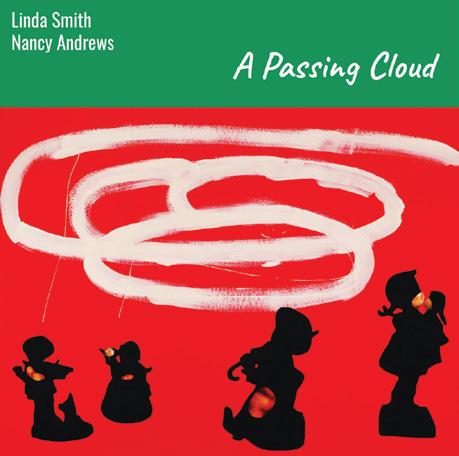
written and recorded by the both of us, encapsulates decades of shared creative vision and enduring friendship. Linda and I were housemates in Baltimore back in 1983, and our musical journey together culminated in the April 2023 release of this album. The record was mixed by Zach Soares ’00, COA’s Director of Audio Visual Services.
This endowed chair was established by COA trustee Tom Cox and the hundreds of friends, family members, and trustees who gave to the chair after Tom passed away in 2019.
I Like Tomorrow, a film I created with Jennifer Reeder, was invited to be part of the January issue (#83) of Labocine, titled “Scientific Musicals.” This issue explores the intersection of scientific experiments and art through musicals, operas, performances, and spoken word poetry. Strange Eyes of Dr. Myes was also invited to be featured in this vibrant issue.
On campus, I actively contributed to the community by organizing the Art Crawl, a delightful evening of arts showcased during the tenth week of each term, which included open studios which promote student artists and courses, and to foster celebration of the arts.
In April 2023, I had the opportunity to visit New York City for a WFMU interview with Linda Smith, and I was able to make time for cultural exploration, immersing myself in the artistic offerings of renowned museums such as the MOMA, The Whitney, the Drawing Center, and the New Museum. This experience enriched my understanding of diverse contemporary art exhibits, informing my role as the Chair in Studio Arts.
The funds provided through this endowed chair have been instrumental in realizing these activities and more—buying books, equipment to support courses and the like. As we pursue studio arts in the rubric of a human ecology education, we remain steadfast in our commitment to advancing artistic education, nurturing talent, and fostering a sense of community through creative expression and study.
Beginning Fund Balance $1,323,533
Net Return on Investments 1,323,533 Contributions 0 Less Allocations/Withdrawals (60,000) Ending Fund Balance $1,458,825

William H. Drury Jr. Chair in Evolution, Natural History, and Ecology
Chairholder: John G.T. Anderson, PhD
This has been a busy year, in spite of—or perhaps because of—a sabbatical in winter 2023.
I taught Ecology and the Human Ecology Core Course in the fall, Wildlife Ecology and the campus-based portion of Island Life in the spring. I had 31 advisees, sponsored three senior projects and two independent studies, and coordinated our bird research on Great Duck Island and Mount Desert Rock.
I completed my term on the Waterbird Society Council, but continue as Book Review Editor for the international journal

Waterbirds, and serve on editorial boards for two other professional journals.
In August, I had the opportunity to visit the Innerpeffray Library. This is the oldest free library in Scotland, dating to the 17th century, and contains many important books on natural history. Examination of some of the texts sparked the “next-after-theGreat-Duck book” concept: The Mirror of the World. I also visited Cambridge, staying in Darwin’s old college (Christ’s), and was able to see some of his original notes from the Beagle voyage.
While on sabbatical, I conducted research for my book on the ecology of Great Duck Island, and the role of the island as a model for a certain form of education. I completed drafts of several chapters and met with my editor to discuss progress.
I was co-author on a paper titled The Value and Necessity of Natural History Studies of Waterbirds with an international cast. I also did an oral presentation at The Waterbird Society annual meeting, and organized, presented at, and chaired a session at the Northeast Natural History Conference. I was able to get grant funding from Friends of Acadia to survey National Park Service islands in our region. The 2023 “Duckling” crew, plus the students in Island Life, counted birds on 10 park-owned islands, placed GPS tags on several birds, and mapped and banded nesting individuals. This work will help us understand population dynamics in regional gulls, and to assess the risk of Highly Pathogenic Avian Influenza in our area.
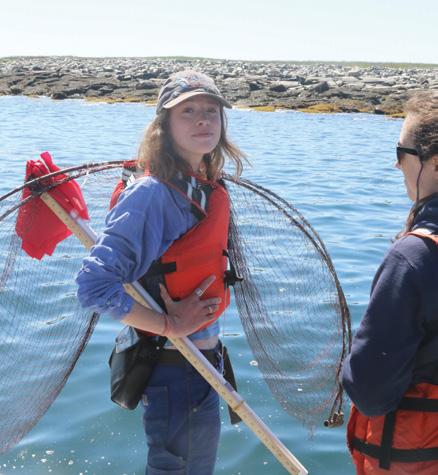

W.H. DRURY RESEARCH FUND
This fund allowed two students to join me and present at the annual meeting of The Waterbird Society in Texas, plus seven students to join me and present at the Northeast Natural History Conference in New York. In addition, the fund made it possible for six students and an alum to work with me at the Alice Eno Field Research Station on Great Duck Island.
This year we began the season early, starting in April with the arrival of the gulls, and continued until August. Of particular note was the presence (and removal) of three otters, who were feeding on Leach’s storm petrels. It seems likely that in the absence of the COA team, the island’s petrel population would have suffered
greatly. Through the hard work of the students, we now have the first comprehensive map of all gull nests on the island, as well as something of a phenology of arrival. We will all present our work at an international conference in October 2023.
As always, I am deeply grateful to the donors of the endowed chair and this fund for making this work possible.
This endowed chair and research fund were established in honor of the eminent ecologist and former research director of the Massachusetts Audubon Society who died in 1992. Bill lectured on evolutionary biology and ecology at Harvard University for over 20 years before joining the COA faculty in 1976.
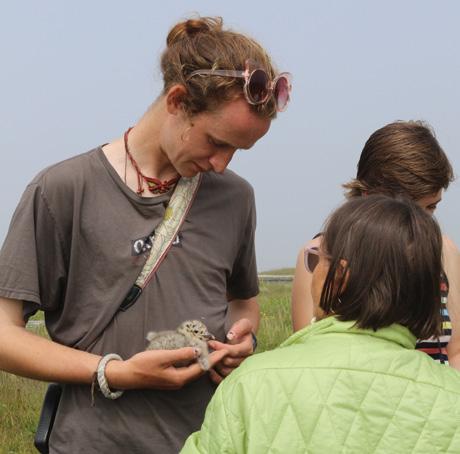
Charles Eliot Chair in Ecological Planning, Policy, and Design
Chairholder: Brook Muller
A year ago, a friend and COA alum shared the posting for the Charles Eliot Chair in Ecological Planning, Policy and Design, and my mind exploded: this is the position I would have written for myself! It struck me as the perfect place to advance the work I am passionate about while nurturing a next generation of ecological design thinkers.
I practiced architecture before I had the opportunity to serve as co-project leader for the design of the environmentally friendly National Institute for Forestry and Nature Research (IBN) in Wageningen, The Netherlands. But I knew from my time in graduate school that teaching had to be central to my future, teaching that embraces a systems-based approach to design with a strong focus on water (my name is Brook after all). My recent book, Blue Architecture: Water, Design, and Environmental Futures (University of Texas Press, 2022) explores ecologically responsive strategies for designing with water, and celebrates its never-failing capacity as a connective medium between sustainable architectures and climate-adapted urban landscapes.

Dan and Polly Pierce established this endowed chair in 2000. Dan Pierce was a COA trustee, grandson of landscape architect Charles Eliot, and great grandson of Harvard President Charles William Eliot. Beginning Fund Balance $351,206
My arrival at COA coincides with the next phase of projectbased work with colleagues in Cairo, Egypt who operate in neighborhoods suffering from poverty, food insecurity, failing infrastructure, climate change impacts, and other severe challenges. I served on the design team and ran an international field school that led to the recently completed al-Khalifa Heritage and Environment Park, a much-needed open green space primarily intended for women and children in the heart of medieval Islamic Cairo. The approach involves intercepting water from leaky pipes damaging 13th century shrines that my colleagues are working to restore, treating it, and directing it to vegetation in the park. In other words, the medium causing harm becomes the very resource to make a new system go; such is the logic of systemsbased ecological design!
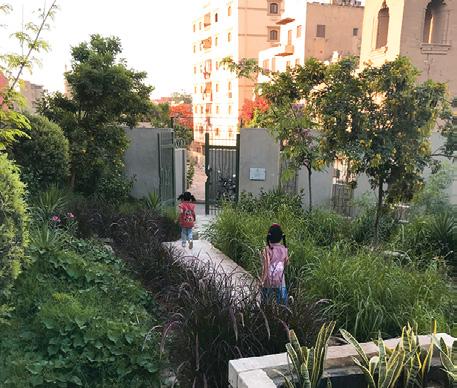
We have very recently started to investigate how to apply the logic of water reuse to the neighborhood in its entirety, with a focus on urban food production and evaporative cooling measures to reduce the urban heat island effect in this desert city. I am so excited about engaging COA students in this work, not only in Cairo, but more broadly in applying ecological design principles to urban contexts in the cause of environmental quality and environmental justice.

Andrew S. Griffiths Chair for the Dean of Administration
Chairholder: Bear Paul, Administrative Dean and CFO
The endowment created by this chair provides important budget relief to administrative operations, allowing funds to flow to mission critical activities, initiative, and capital projects.
Some of the more exciting developments over the course of the 2022–23 academic year included:
• A full renovation and electrification of the Delaitre barn at Peggy Rockefeller Farm, in preparation for the installation of a solar array. The barn is now being used to house livestock.
• Expansion and improvements to the farmstand at Beech Hill Farm, allowing it to open earlier in the season and stay open later into the fall.
• Transitioning of Witchcliff off fossil fuels.
• Installation of heat pump water heaters in Blair Tyson, significantly reducing the college’s use of fossil fuels in these dormitories.
• Undertaking building efficiency work that reduced our heating oil purchase by roughly 30%.
• Completing a number of deferred maintenance projects, including replacing the roofs of 14 COA buildings, including seven off-campus houses, Blair Tyson, Witchcliff, the Dorr Museum, and many more.
• Transitioning the school budget reporting from a cash accrual hybrid format to a full accrual format.
I continue to chair the Personnel Committee and lead the budget-setting process.
Additionally, examining the condition of campus buildings and developing a facilities condition analysis has come into focus as a priority, as has supporting the IT department in refreshing the information infrastructure here at the college.
The 2022–23 academic year was a productive one, and we are excited to address the challenges of 2023–24.
The Andrew S. Griffiths Chair was one of nine chairs created during the Broad Reach Capital Campaign. The endowed fund was established in 2018 by COA’s board of trustees to honor Andrew “Andy” S. Griffiths, the college’s long-serving and wellrespected administrative dean who served for more than 15 years. Beginning Fund Balance $495,043
Return on Investments 74,487
111,000
Allocations/Withdrawals (25,400)
Fund Balance $655,130
Renovated DeLaittre Barn at Peggy Rockefeller Farm
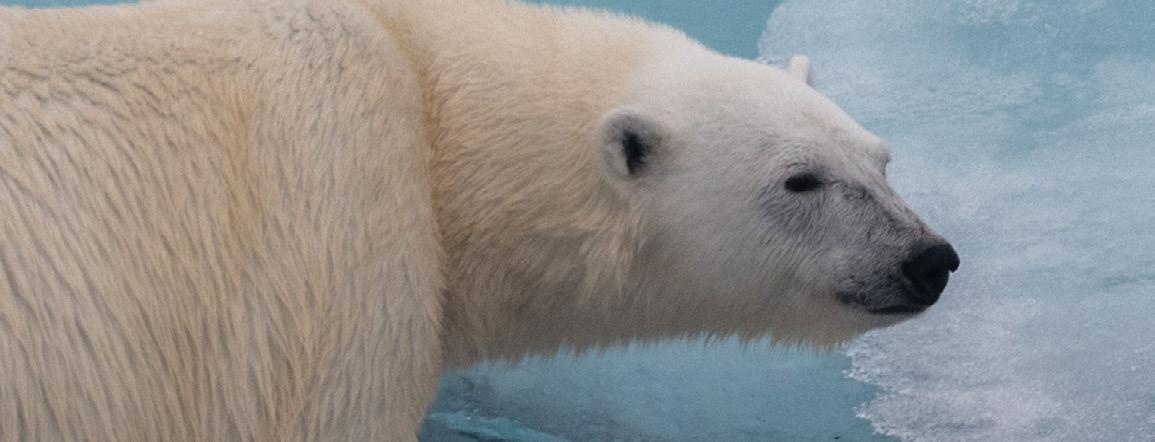
Steven K. Katona Chair in Marine Studies
Chairholder: Sean Todd, PhD
Over the 2022–23 academic year, I taught a total of 83 students in four classes, two senior projects and one independent study. Classes taught include: Marine Mammal Biology, Biology Form and Function (team-taught with Susan Letcher), Introduction to Statistics and Research Design, and Introduction to Oceanography. I had an official advisee roster of 20 students, including one graduate student, and reviewed three writing portfolios and three human ecology essays.
COA trustees, hundreds of alumnx, and friends of the college established this endowed chair in 2007 to honor COA’s fourth president and founding faculty member.
I assisted with the management of the Edward McC. Blair Marine Research Station on Mount Desert Rock in the 2022 field season. A total of 15 students worked at the field station on projects that incorporated marine mammalogy, biological oceanography, intertidal science, soundscape, photography, and marine bird ecology. Four of the 15 took on leadership roles, helping to run the field station. The island also hosted an overnight visit from the Islands Through Time class.
With the Gulf of Maine Stable Isotope Project (GOMSIP)—an examination of climate-induced changes in Gulf of Maine whale feeding behavior—ending in 2022, we turned our attention to finalizing analyses and collating samples. We also used the time to review the project in terms of successes and challenges. A resounding conclusion was the need to extend our research into a
second set of five years—a project dubbed GOMSIP II, for which we are now fully permitted. Our work continues in part funded by Katona Chair discretionary funds. We began to write up some of the earlier work for publication within the year.
During the 2022–23 academic year, I continued to serve on the Faculty Development Group, and devoted significant energy to chairing a task force that ultimately recommended that COA instructor Karla Peña become full-time faculty, a proposal that was fully supported by the institution as long overdue. In addition to directing Allied Whale and overseeing operations at Mount Desert Rock, I also worked on the Islands Committee, Graduate Committee, and assisted with various Admission functions.
I also took a sabbatical in winter 2022, using the time to collect data for the Antarctic Humpback Whale Catalog aboard the expedition vessel Seabourn Venture, during which time I improved my seamanship and ability to operate vessels in polar conditions.
I helped with the inaugural voyages of Venture in summer 2022, visiting eastern Greenland, Jan Mayen, Iceland, Norway and Svalbard, reaching 82°N.
I continue to serve on the Maine Coalition for the North Atlantic Right Whale, and I now also serve on an advisory board that acts as a consultative body to the development of offshore wind energy in the Gulf of Maine.
Chair funds were used to help purchase research equipment for Allied Whale, as well as for operating costs at Mount Desert Rock. Funds also supported virtual attendance for nine students to join me at the Right Whale Consortium, and supported course teaching assistants, equipment purchases, and travel costs associated with my sabbatical.
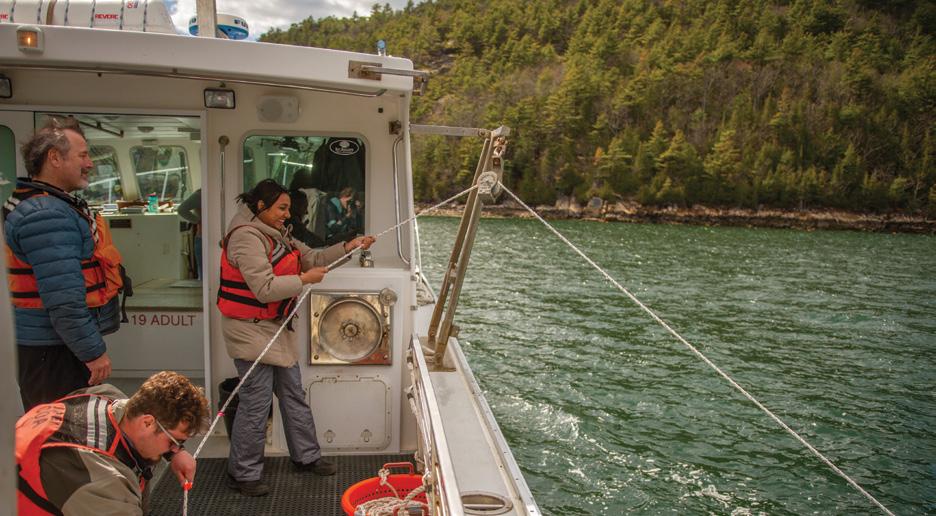
Over the course of the year, I successfully raised approximately $160,000 for Allied Whale research and Marine Mammal Stranding Response Program activities, including:
• Anonymous foundation, $20,000
• Oceanside Properties, $20,000
• Cestone Foundation, $20,000
• NOAA Prescott Health and Stranding Program, $100,000 Beginning Fund Balance $2,051,593
Return on Investments
Contributions 0 Less Allocations/Withdrawals (110,200) Ending Fund Balance $2,243,304
With the freedom and responsibility to design our own course of study, abundant opportunities for getting involved in research, and having faculty closely engaged in and supporting our individual learning and development, COA in many ways felt like ‘graduate school for undergraduates’.
NINA OVERGAARD THERKILDSEN ’05

McNally Family Chair in Philosophy and Human Ecology
Chairholder: Heather Lakey ’00, MPhil ’05, PhD
The 2022–23 academic year was a busy, engaging, and productive one. I renewed and revised five courses: Utopia/ Dystopia; Sex, Gender, Identity, Power; Problems and Dilemmas in Bioethics; Rethinking the Canon; and Philosophies of Death and Dying. Overall, I taught a total of 61 students, read nine human ecology essays, directed one independent study on Ancient Greek literature, mentored 17 advisees, and directed four senior projects.

In addition to teaching, I assumed a number of administrative service roles. I served as co-chair of the Steering Committee with Ken Cline for the fall and winter terms, and as the sole chair during the spring when Ken was on sabbatical. This year, the All College Meeting passed several important policies,
including The Bias Response Policy and a revision to the Energy Policy. In addition, Steering facilitated a number of community conversations on important topics such as the five-year strategic plan, flags at graduation, and the job contours for upcoming faculty searches. I am a strong advocate for COA’s participatory governance structure because it facilitates valuable learning opportunities and it fosters productive community discussions regarding challenging issues. In addition to my work with Steering, I served on the Summer Institute Planning Committee. It was a pleasure to work with a dynamic group of COA staff and board members to plan this year’s Institute, Reimagining Exploration
Another notable administrative experience was serving on the search committee for the faculty position in Ecological Planning, Policy, and Design. Finally, I convened a working group over the summer to assess the human ecology essay assignment and its place in COA’s curriculum.
To support COA’s commitment to place-based learning and community engagement, I invited three visitors from Northern Light Health to Philosophies of Death and Dying: Vanessa Little, a Palliative Care Service Line Medical Director; Erin Kerns, the Manager of Northern Light Hospice in Ellsworth; and Tim Soucy, Spiritual Counselor and Bereavement Coordinator. Their visits generated excellent class conversation and they provided interesting examples to inform our philosophical discussions.
In January, I attended the seventh annual Reproductive Ethics conference in Galveston, Texas. I presented a version of my paper, Rethinking Regret: Simone de Beauvoir and the Ethics of Abortion. I received valuable feedback from bioethicists, philosophers, and health care providers, and attended some excellent sessions which will enrich my courses on bioethics and feminist philosophy. I want to express my deep gratitude to the McNally family for endowing this chair and supporting philosophical studies at COA.
Beginning Fund Balance $899,059
198,889
Jay McNally ’84 established this endowed chair in 2019 as part of the Broad Reach Capital Campaign.
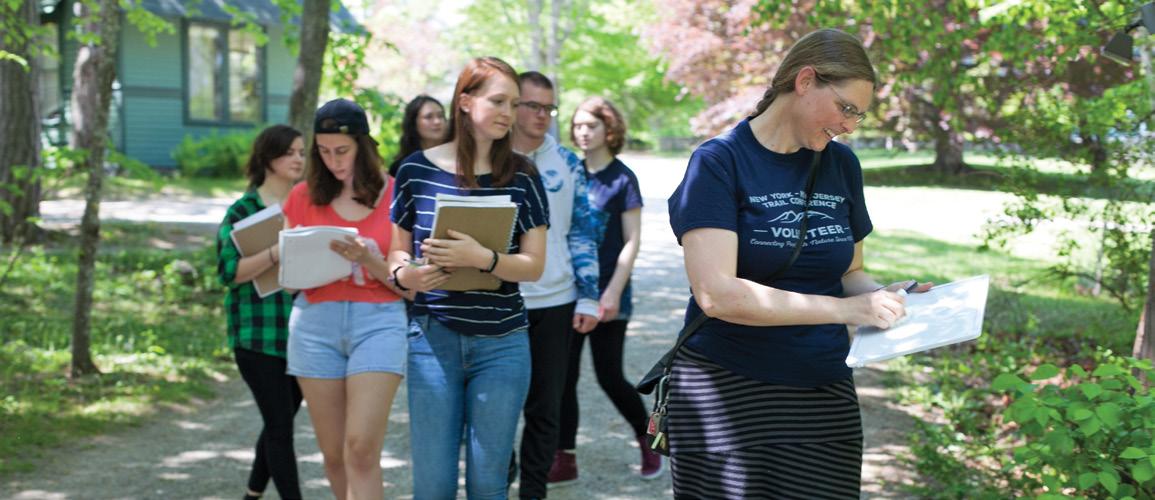
Elizabeth Battles Newlin Chair in Botany
Chairholder: Susan Letcher, PhD
I was granted a sabbatical in the fall of 2022, which provided a much-needed opportunity to focus on research, writing, and course development. I worked on a new course in plant systematics for the fall of 2023. I also did some volunteer work transcribing herbarium specimen labels through the online platform Digivol. I wasn’t able to travel in the fall, so I took advantage of fall on MDI to do lots of hiking and enjoy the stunning autumn foliage.
In the winter, I taught Biostatistics, an upper-level exploration of statistical methods and research design, and Plants and People: Economic Botany, an introductory course on plant use in human societies. In the spring, I taught an upper-level course in theoretical ecology, Population and Community Ecology, and I team-taught the introductory course Biology: Form and Function I also supervised three independent studies and three senior projects, serving just over 100 students during the academic year. I helped a number of undergraduate and graduate students with experimental design and statistical analysis for projects. I worked with my 15 advisees to find paths through human ecology that serve their interests and aspirations.
In service to the college, I worked with the Admissions Committee to evaluate applications for the class of 2028. Once again, I was amazed by the range of talents and the broad array of human experiences among the students, and was confident that the committee identified an outstanding incoming class. I also served on Review and Appeals, reviewing residency applications and
helping students navigate the curriculum. In July 2023, I had the fantastic opportunity to interview author Kim Stanley Robinson for COA’s Coffee & Conversation series.
In service to the scientific community, I reviewed seven manuscripts for scientific journals and eight postdoctoral fellowship proposals for European Science Foundation grants. I performed prepublication reviews of two book-length manuscripts. I gave several online talks in Spanish to a restoration ecology course at the University of Costa Rica. In June 2023, I traveled to Costa Rica as a visiting faculty member on a graduate course in tropical field ecology offered by the Organization for Tropical Studies, where I helped students with experimental design and conducted a field project on forest dynamics.
Two of Elizabeth Battles Newlin’s children, Lucy Bell Sellers and her husband Peter, and Bill Newlin and his wife Louisa (née Foulke) Newlin established this chair in 1996 as part of the college’s Silver Anniversary Campaign.
Thanks to collaborations with other scientists around the world, I published two scientific papers in the 2022–23 academic year: one titled Forest Ecology and Management with Dr. Yi Ding’s research group at the Chinese Academy of Forestry, on the impacts of drought on forest recovery in southern China; and one
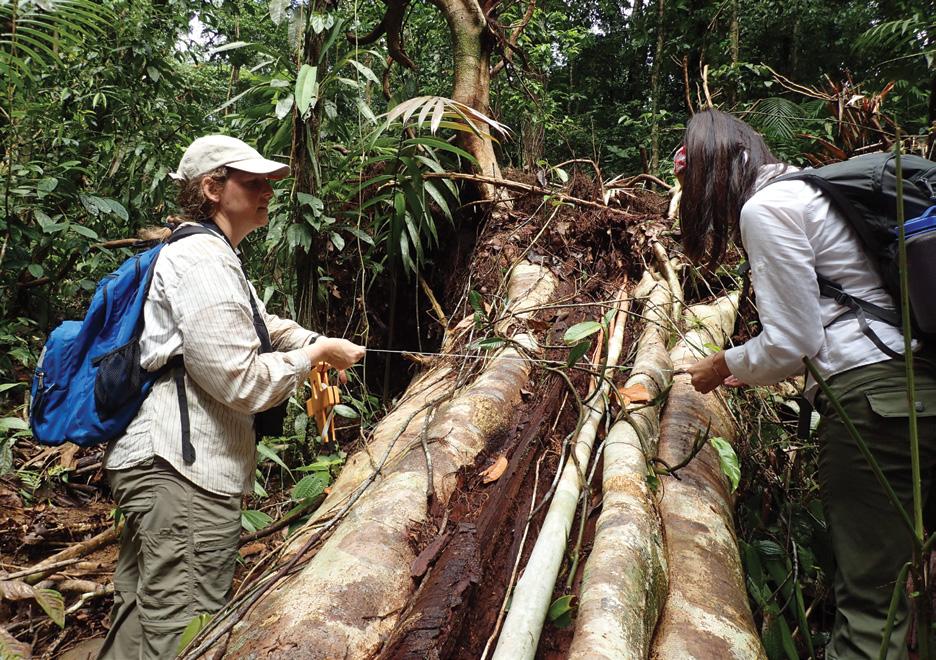
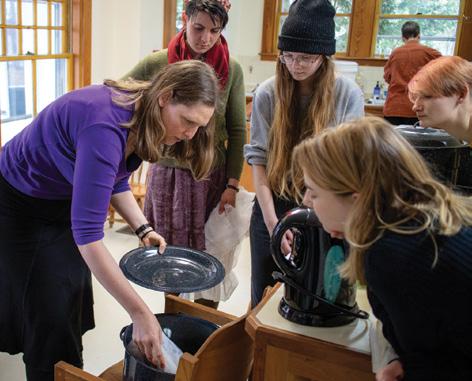
titled Proceedings of the Royal Society B: Biological Sciences with an international group of colleagues led by Víctor Arroyo-Rodríguez (UNAM, Mexico) on the ways that regional forest cover affects the predictability of forest recovery from major disturbances. Three additional papers are currently in review.
Overall, it’s been another busy and delightful year at COA. I am grateful to the family of Elizabeth Battles Newlin for supporting my work.

Beginning Fund Balance $1,138,445
Return on Investments 167,539 Contributions 0 Less Allocations/Withdrawals (60,900) Ending Fund Balance $1,245,084
Partridge Chair in Food and Sustainable Agriculture Systems
Chairholder: Kourtney K. Collum, PhD
With the generous support of the Partridge Chair, the 2022–23 academic year was one for the books. In the fall, I taught my signature course, Transforming Food Systems, to a group of 20 students eager to envision and enact a socially just, ecologically sustainable food system. I also taught a challenging new course, Food & War. Our contemporary food systems are the product of war—from innovations in refrigeration and canning during the First World War to skyrocketing grain prices due to the ongoing Russia-Ukraine war. The 13 students in the course explored one central question: how has food been both a weapon of war and a tool of diplomacy? In the winter, I took a long-delayed sabbatical, but returned in the spring to teach two courses. In Anthropology of Food, we brought back the always-popular TAB Takeover, where students in the course worked with the dining hall staff to present meals of personal and cultural significance. This year, students introduced the community to their versions of Spam masubi, thai boba tea, croquettes, and Maine red snapper hot dogs, to name just a few. It may have been the best year yet for this culinary tradition.
The highlight of my year was teaching Active Optimism for the second time. In this advanced course, I guide students as they apply their knowledge and skills to tackle food systems problems on our own campus. The brilliant, giant-hearted students in this years’ cohort engaged in multiple projects, including developing free Sunday “COAmmunity” dinners, creating food security training for orientation, launching a food access resources webpage, and expanding The Howdy Houghton Memorial COA Community Food Pantry & Fridge to include weekly deliveries of fresh meat, produce, and alternative protein products. In addition to my courses, I advised 27 students, directed two independent studies and two senior projects, and served as a reader for nine human ecology essays.
In the fall, the Food Systems Working Group hosted the 16th annual COA Farm Day, featuring a dinner of COA-grown meat and produce, a concert, and farm tours for nearly 200 COA students and staff.
After multiple delays due to the pandemic, I finally took my first sabbatical in the winter. The highlight was traveling to the Yucatán Peninsula to join Karla Peña’s Spanish immersion program. Karla graciously let me audit Spanish I in the fall and then, in the winter, facilitated opportunities for me to visit agricultoras and apicultoras across the peninsula while practicing

Spanish. I also used my sabbatical to complete two co-authored manuscripts, published this summer: Human Organization and Trees, Forests, and People. In May, Dr. Hillary Smith and I presented a workshop on blue food systems at the Agriculture, Food, and Human Values Society conference in Boston.
This chair was established in 2008 through the generosity of Polly Guth, a long-term supporter of COA and Beech Hill Farm, and the Partridge Foundation.
I continued to participate in the MDI Food Access Project, and was able to expand my participation in the Downeast Restorative Harvest Project, Hancock County Food Security Network, and on the board of the Bar Harbor Food Pantry. This summer, two students—Molly Hetzel ’25 and Darcy Kerr ’24—interned with the MDI Food Access Project, and helped glean and distribute food to feed our community. This work was all made possible by Patridge Chair funds. I am deeply grateful.
Beginning Fund Balance $3,953,940
Return on Investments 567,300 Contributions 0
Fund Balance $4,309,839
Kourtney Collum with COA students and alums at the Maine Food Convergence in May

Emily and Mitchell Rales Chair in Ecology
Chairholder: Chris Petersen, PhD
Emily and Mitch Rales established this endowed chair in 2020 as part of the Broad Reach Capital Campaign.
This year my coursework has been focused on ecology and policy in Downeast Maine with an introductory marine biology class (21 students) and the Fisheries, Fishermen, and Fishing Communities class that I teach with Natalie Springuel ’91 (15 students). The fisheries class had students visiting sites all over Downeast Maine, from Penobscot to Eastport, and we did several service projects with local community members, talking with more than 20 fishermen, aquaculturists, officials, and advocates for sustainable communities and fisheries. This class is a great mix of biology, fisheries, community, and policy, and probably has more human ecological themes than any other course I teach. With a deep bench at COA in marine socio-ecological systems including Natalie Springuel ’91, Galen Koch, Hillary Smith, Laurie Baker, Todd Little-Siebold, Sean Todd, and John Anderson, I’m confident that this and other classes will continue to give students great offerings in marine studies.
In addition to chairing the Bar Harbor Marine Resources Committee, I spent a substantial amount of time talking to town leaders in the state co-managed clam fishery as part of a grant from an anonymous fund at Maine Community Foundation on how to improve communication and management of the fishery in Downeast Maine. I’m currently analyzing the data with alum Elle Gilchrist MPhil ’21, and hope to have a report to give back to community members around the end of 2023.
Another area where I’m working on the intersection of biology and policy is the restoration of river herring populations and townbased fisheries. I’ve been active in the river herring network, and helped introduce new faculty member Laurie Baker to this great group of people. Laurie is currently co-principal investigator on a grant to strengthen this network, and I am playing an advisory role. I continue to serve on the board of the Somes-Meynell
Sanctuary, and play an active role in the restoration of alewives in Somesville with Sanctuary staff and a large group of volunteers.
I continue to do research in Acadia National Park, but this year the focus was a collaborative effort with the park, Schoodic Institute, and the Town of Mount Desert on the health of Otter Creek. I co-presented this work at the Acadia Science Symposium in October 2022 in a talk titled Perspectives on a Community Science project: Thriving Earth Exchange’s “Assessing the Health of Otter Cove and Potential Pathways to Remediate Problems”
I also work with several regional partnerships and state groups. These include the Downeast Fisheries Partnership and the Downeast Conservation Network. As I get ready for retirement in December 2024, I’m working on creating a smooth transition in the college’s representation in these groups. I’ve already begun the transition as principal investigator in the Maine INBRE biomedical grant at COA; next year Reuben Hudson will take over that role. This year, we had two summer fellows and nine academic-year fellows at The Jackson Laboratory, Mount Desert Island Biological Laboratory, and COA.
Finally, I continue to work on providing paid internship opportunities for students. I worked with the Advancement Office to place student interns through our grant from the Seth Sprague Family Charitable Foundation, and continue to work on a yearly ‘Research and Education Opportunities for the Sciences’ document to give all students access to information on local and regional internships with faculty and our partners. Beginning Fund Balance $726,422
$1,032,442
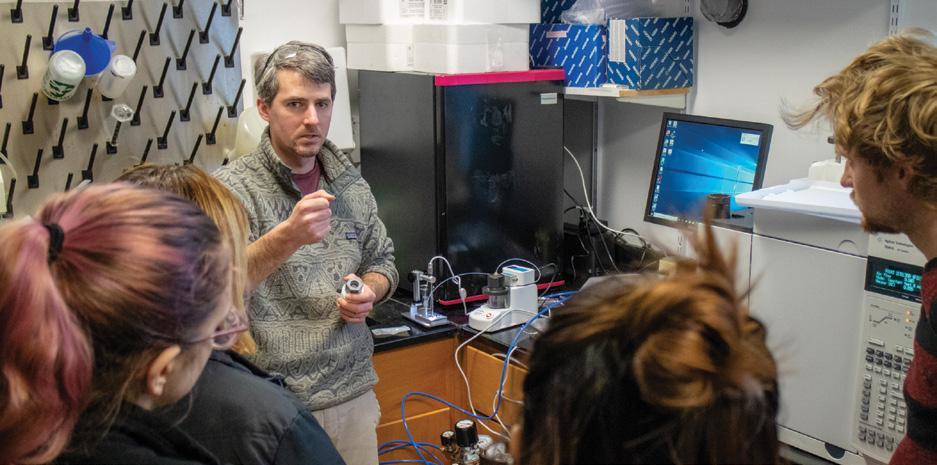
Lalage and Steven Rales Chair in Chemistry
Chairholder: Reuben Hudson, PhD
Chemistry at COA was an exciting place to be in the 2022–23 academic year. As a relatively new faculty member, I’m just starting to loop around to some of the classes I taught in previous years. The familiar topics allowed me to expand class sizes for some of my higher-demand courses (Introductory Chemistry and Analytical Chemistry). I also taught a new advanced electrochemistry course with visiting scholar Thiago Altair. An allocation from the Guthrie Chemistry Fund was used as institutional matching funds (for the purchase of lab supplies) for a $25,000 Faculty Seed Grant from the Maine Space Grant Consortium. We also had support from the American Chemical Society ($70,000), the Maine IDeA Network of Biomedical Research Excellence ($110,000) and the Davis Family Foundation ($60,000). The support from the Davis Family Foundation was used to purchase our first state-of-theart, research/teaching grade analytical chemistry equipment at COA: a gas chromatography mass spectrometer (GC-MS). With this instrument, we quantified biochemical markers indicative of humans in carbon-14 dated lake sediment cores going back thousands of years. Students working on this project in Analytical Chemistry continued this research in ancient coprolites (fossilized feces) from mammoths, rhinos, rangifer, and bison to establish the viability of these analytes for species identification. Students who received hands-on training on
Lalage and Steven Rales established this endowed chair in 2020, as part of the Broad Reach Capital Campaign.
the GC-MS went directly from their undergraduate career into graduate school or into industry as GC-MS technicians.
Our small research group is gaining more of an international profile. Thiago Altair joined our lab as a postdoctoral fellow after finishing his PhD at the University of in São Paulo, in Brazil. Thiago is spearheading a collaboration between COA and researchers in Brazil, Japan, Germany, and the UK. Sarah Kheireddine of Lebanon also joined our lab as a postdoc after finishing her PhD in France. Sarah focuses on sustainable and recyclable polymer-immobilized catalysts for a range of organic transformations in collaboration with researchers from Canada and Japan. We’re delighted that Thiago and Sarah chose COA to carry out their research and teaching activities in conjunction with our undergraduate students.
Beginning Fund Balance
$451,628
Net Return on Investments 102,479 Contributions 200,000 Less Allocations/Withdrawals (8,000) Ending Fund Balance $746,108
David Rockefeller Family Chair and T.A. Cox Fund in Ecosystem Management and Protection
Chairholder: Kenneth S. Cline, JD
CLASSES
David Rockefeller established this endowed chair in 2010. Tom Cox, a COA trustee and friend of David and Peggy Rockefeller, established the fund that supports the work of the chair.
In the fall, I taught my seminal course, Environmental Law and Policy, an advanced class focusing on common law, federal environmental statutes, and constitutional litigation. This was followed in the winter by Wildlife Law, which is a very advanced law course for students with a background in law and wildlife ecology. It is rare to have a large enough cohort of students for me to teach a class at this level at COA, and this was an exceptional group with a solid background in law and wildlife. I also taught the Human Ecology of Wilderness class for the first time in 12 years. This interdisciplinary class culminated in a
two-week field trip to the Okefenokee National Wildlife Refuge, Cumberland Island Wilderness, and the Suwannee River, where students were able to witness and apply course concepts. I also had the opportunity to teach the legal dimensions of the rights of nature to all of the sections of the Human Ecology Core Course Finally, I supervised senior projects focused on land protection, aquatic restoration, and active transportation.
CO-MANAGEMENT RESEARCH AND ADVOCACY
I continue to lead an effort within the Sierra Club to improve the Sierra Club’s working relationships with Native Peoples in the US. I have helped organize two national virtual conferences that have centered Native views on environmental protection. An outcome of this work is the writing and approval of a new co-management policy for the Sierra Club. My sabbatical was spent researching current examples of successful co-management, and I will present some of this work with a student this fall at the International Society for Human Ecology Conference in Tucson. I also spent time in Congress this spring lobbying Congressional offices on this and related subjects.
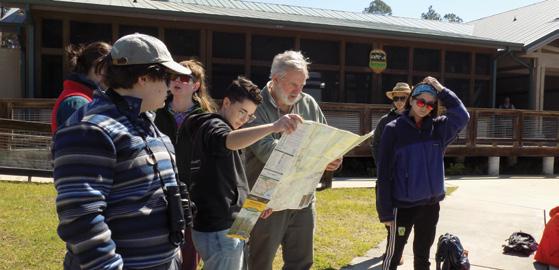
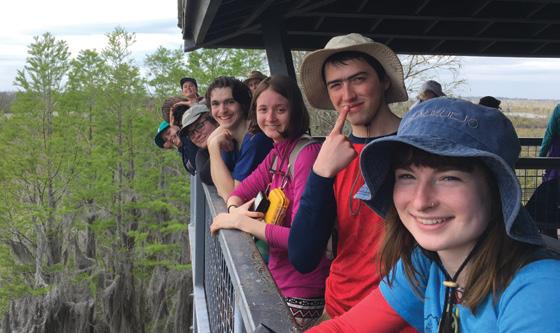

Above: Acadia Scholar Chloe Meyer ’25 with Bik Wheeler ’09, MPhil ’18, Acadia’s lead wildlife biologist
UNITED NATIONS BIODIVERSITY CONFERENCE
Doreen Stabinsky and I took seven advanced students to the 15th Conference of the Parties of the Convention on Biological Diversity in Montréal, Canada. In addition to hearing prominent speakers such as the Prime Minister of Canada and the Secretary-General of the United Nations, the students were able to attend two weeks of intense negotiations over the future of the world’s biodiversity. Nations of the world looked for ways to expand protected areas, safeguard endangered species, ensure adequate resource mobilization, and promote their own environmental and economic interests. The COA delegation worked to improve legal documents pertaining to the conservation of biodiversity that came out of these negotiations. I used my network of connections through the IUCN’s World Commission on Protected Areas and the IUCN’s World
DAVID ROCKEFELLER FAMILY CHAIR


Commission on Environmental Law to introduce students to experts in the international environmental law field.
NATIONAL PARK WORK
I continue to develop and strengthen the Acadia National ParkCOA partnership by introducing students and new faculty to opportunities to collaborate with the National Park Service. With support from a Davis Conservation Foundation grant, we were able to place a COA Acadia Scholar intern with the Wildlife Division in Acadia for the summer. I also continue to do advocacy work and file legal comments on proposed actions in Acadia that will affect park resources. I continue to serve on the Board of Directors for Schoodic Institute at Acadia National Park and chair their Science and Education Committee.
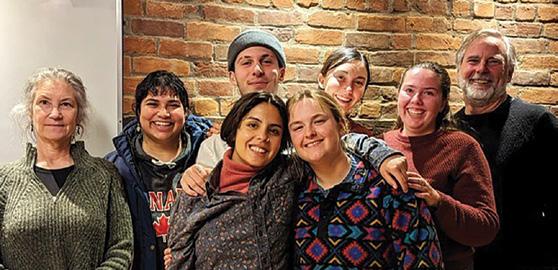
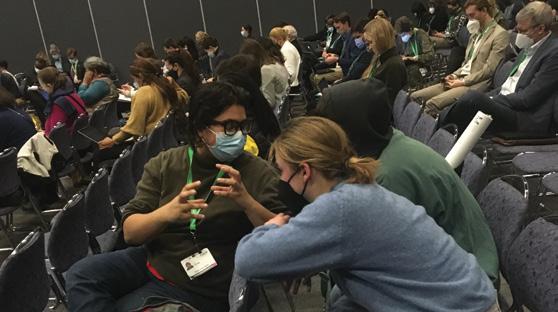
Sharpe-McNally Chair in Green and Socially Responsible Business
Chairholder: Jay Friedlander
The Sustainable Business Program renewed local and international ties this year.
In the fall, while on sabbatical, I visited the Learning Planet Institute in Paris, which focuses on interdisciplinary exploration, research, and sharing new ways of learning and cooperating to meet the needs of the youth and the planet. There, I met with their leadership team to discuss COA, teaching, and ideas on how to remake higher education. I also visited COA’s partner in Japan, the Setouchi Global Academy, to lay groundwork for a monster course next fall. In addition, I spent three weeks walking roughly 500 miles on the Camino de Santiago from St. Jean Pied-de-Port, France to Santiago de Compostela, Spain.
Henry and Peggy Sharpe initiated the funding of this chair and Jay McNally ’84 completed its endowment in 2004.
At the end of my sabbatical, I officially launched Profit Decoder™, a new web app that gives small business owners the power to take control of their financials and succeed. The app was highlighted in several masterclasses I led for small business owners and entrepreneurs focused on improving profitability with groups like SCORE, Maine Center for Entrepreneurs, Maine Innovation Nights, and others.
I returned to COA for the winter term and taught Designing Your Life and Solutions. In Designing Your Life, students examined their values and interests to generate several possible futures for themselves to test and refine. To augment the course, we brought in guests from backgrounds that included baking, academia, television, counseling, international development, aquaculture, and other professions to discuss their pathways through life.
Solutions had teams of students who sought to research problems, develop a theory of change, and ultimately use a methodology developed by Google Ventures to design the launch of their solution. Student projects included: expanding income of subsistence farmers in Central America; reducing waste from the “move out” process at COA; making personal testing for toxins widely available; unifying information to clean up the Penobscot River; and reducing household food waste.
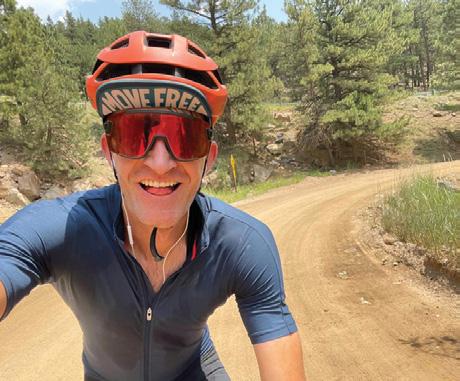
This spring, students in the Diana Davis Spencer Hatchery developed and refined enterprises in sustainable development, visual storytelling, sailing data science, fair trade tea, trans fashion, discarded resources, and renewable energy storage. Approximately 50 people from around the world attended the Hatchery Expo that was live at Havana restaurant and simulcast over Zoom, where students presented overviews of their work at the end of the term.
A graduating senior, Patrick Caron ’23, was accepted into the Dirigo Labs Accelerator Program to develop his athletic apparel business, Move Free. Patrick has been building this business—and integrating it with his coursework—during his entire time at COA, and this spring, he had the opportunity to share a pitch stage with select entrepreneurs from around the country.
In the broader community, I participated in groups fostering entrepreneurship and the local economy in Maine and beyond. As part of these activities, I was invited to review a new edition of a book on finding sustainable careers. Kerri Sands ’02, the Sustainable Business Program Manager, once again represented COA as a preliminary judge in a capstone competition for Manomet’s 2023 class of U360 Business Sustainability interns. Kerri and I were also active participants in the Downeast Innovation Network and Maine Accelerates Growth. These groups seek to understand and improve our entrepreneurial ecosystem across Maine.
Beginning Fund Balance $2,237,329
Return on Investments 329,240
Less Allocations/Withdrawals (120,000) Ending Fund Balance $2,446,569
Cycling in Move Free apparel
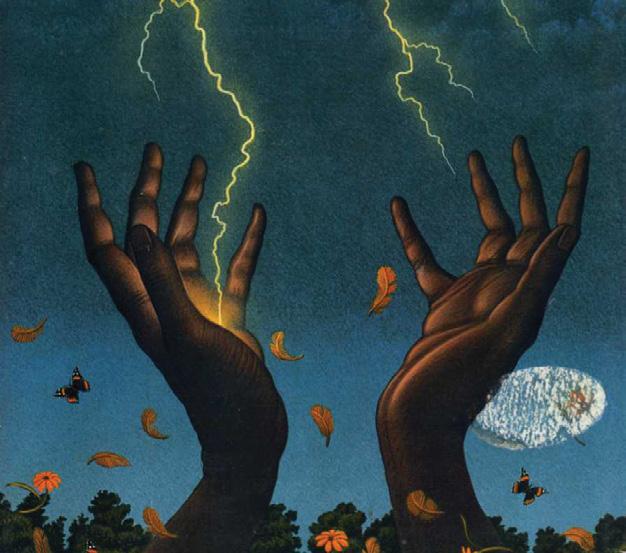

Lisa Stewart Chair in Literature and Women’s Studies
Chairholder: Karen E. Waldron
The 2022–23 academic year was an eventful one, as I was compelled to take a medical leave during the fall 2022 term. However, the leave gave me the opportunity to avidly return to Jane Austen, Charlotte Brontë and her sisters, and George Eliot in preparation for the Austen, Brontë, Eliot class I am planning to teach in the winter 2024 term.
I was able to supervise the Writing Program remotely and to mentor Palak Taneja, who is also teaching courses in women’s studies from a postcolonial and world literature perspective. When I returned in winter 2023, I taught The Nature of Narrative and Native American Literature; in the spring, I taught Literature, Science, Spirituality and African American Literature. All my classes include at least fifty percent works by women writers and use elements of narrative theory, historical context, and language analysis to probe both content and form of literary art.
The Nature of Narrative is especially focused on literary and narrative theory, and it was a fabulous group of students who read 11 challenging novels from around the world in English. Each student presented their rereading of one of the texts from their own theoretical perspective. The Native American and African American literature classes look at the rich and complex contributions of these minoritized populations to US
William P. Stewart established this endowed chair in 2012 in memory of his daughter, Lisa Stewart Target. Lisa was a remarkably personable, intelligent, and accomplished woman who started Bowen Asia, a successful investment firm in Hong Kong, specializing in the Asian economy. She spoke five languages and lived all over the world. Her three children attended COA’s Summer Field Studies program.
literary history, realizing how they help to complete their understandings of the culture that surrounds them.
In Literature, Science, Spirituality, there is a focus on the so-called divide between religion and science in terms of how literature reveals the changing ideas and normative values in each. We move from Francis Bacon, founder of the Royal Society, to Gloria Naylor, whose Mama Day features a strong black matriarch and how she connects, and questions, her beliefs in the divine, her herbal knowledge, and her personal power. Students in this class realized that science is not what is in their biology textbook, anymore than religion or spirituality is what lies in a catechism. They became avid questioners, seekers, and knowers about both as a result.
Beginning Fund Balance $1,478,423 Net Return on Investments 217,557 Contributions 0 Less Allocations/Withdrawals (79,400) Ending Fund Balance $1,616,580
Left: Detail from cover of Mama Day; right: portrait of Anne, Emily, and Charlotte Brontë by Patrick Branwell Brontë
Allan Stone Chair in the Visual Arts
Chairholder: Catherine Clinger, PhD
After three years of work on developing an expanded Studio Art Residency Program at COA with board members of the Marion Boulton “Kippy” Stroud Foundation, the effort resulted in an endowment of $1 million for the Kippy Stroud Artists-in-Residence program in December 2022. This program will bring artists and public events to COA in the late summer and throughout the academic calendar year, benefiting both COA students and the local community.

Clare Stone established this chair in memory of her husband Allan Stone in 2006. Allan was celebrated for his visionary eye which incorporated an eclectic approach and early advocacy of pivotal artists of the 20th century and beyond. Alongside being a leading authority on Abstract Expression, he gave Wayne Thiebaud his first New York show and represented him for over 40 years. He was a passionate collector of anything that appealed to his eye including Willem De Kooning, Franz Kline, Arshile Gorky, John Graham, Joseph Cornell, John Chamberlain, and many less known artists. In addition to modern masterworks and contemporary art, Allan collected tribal and folk art, Americana and important decorative arts, industrial design, furniture, and Bugattis.
I hosted and worked for over a month with Maine artist Heather Lyon—our final Kippy Stroud Resident Artist associated with a three-year pilot program that concluded in 2022. Heather worked with students to present a public performance of ECHO, a work-in-progress in collaboration with Juliette Sutherland. ECHO was a two-channel video installation accompanied by COA students in a live performance within a large projection in the Ethel H. Blum Gallery. The work was shot on location in Echo Lake during September 2022 using underwater cameras and free-diving techniques. ECHO explores underwater realms and movement creating a transportive, immersive environment inviting the viewer to experience the otherworldly space.
I served as chair of the yearlong search for the Charles Eliot Chair in Ecological Planning, Policy and Design. We undertook the challenging task to find a new colleague
would fill
who
in
The successful search resulted in the fall 2023 arrival of our new Charles Eliot Chair, Brook Muller. The entire committee was thrilled by his acceptance of the appointment.
As my practice as a scholar/artist dictates, I spent considerable time in archives, public and private art collections, and at exhibitions throughout the United States and Canada this past year. My studio work activity progresses over years at a time, mediative and active, according to the temperament of the work. I continue a cycle of work that is allegorical and autographic in nature—always accompanied by writing and research.
My teaching concentrated on the courses that I offer in printmaking and drawing. In 2022–23, my art history courses focused on contemporary artists who work within an innovative modality of transdisciplinary praxis, specifically in relation to the displacement of the living across the globe, a result of climate shift accelerating and political machinations.
One of the great teaching experiences at the college is the supervision of senior projects. In the spring of 2023, I co-supervised the spectacular and multivalent work of Nati Rijo de Leon ’23, Anna Parsons ’23, Mafe Farias Briseno ’23, and Liv Soter ’23. This form of co-teaching often goes without comment in our literature on curriculum. It is an immense honor to share in their final expression here.
Beginning Fund Balance
$1,982,206 Net Return on Investments 292,165 Contributions 2,000
Fund Balance $2,173,971
who
the shoes of Isabel Mancinelli,
retired
2021.
Cody van Heerden Chair in Economics and Quantitative Social Sciences
Chairholder: Davis F. Taylor, PhD
Along with teaching and advising, my professional work over this—my final year as a full-time professor at College of Atlantic—was dominated by the development of an exciting new course in complexity economics. I have always greatly enjoyed responding to student interests and new developments in the intellectual world, and it seemed like a course in complexity would accomplish both of these things, as well as being a great way to end my 28 years at the college.
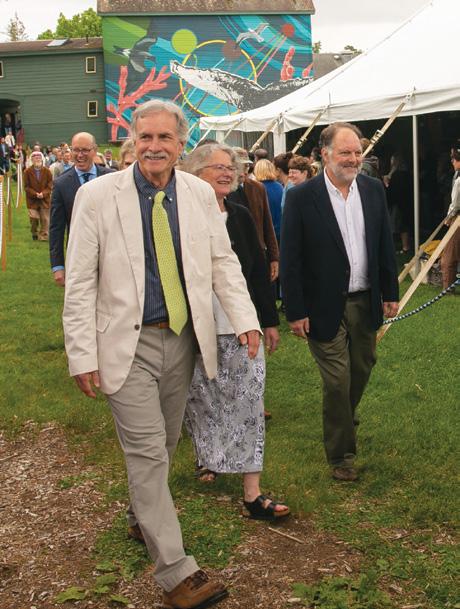
I benefited greatly from a sabbatical during the winter term of 2023, and used much of the time to develop the new course. Complex systems (such as economies) exhibit long memories (history matters), extract and process information from their environment, and evolve in ways that defy prediction. Mainstream neoclassical economics, on the other hand, comprises a set of tools and approaches that can be extremely powerful in some contexts, but are limited by their focus on modeling simple (or
David and Robin Reis, along with dozens of COA trustees, staff and faculty, established this endowed fund in 2019. Cody van Heerden, MPhil ’17, was a trustee who passed away in 2018 at the age of 58 after a short battle with ALS.
greatly simplified) relationships. My new course used concepts of complexity, a tapestry of interrelated ideas that includes nonlinear dynamics, emergence, fractals, scaling, cellular automata, networks, evolution, and related concepts, to explore selected economic phenomena that greatly augments the existing neoclassical framework, and permits an examination of much more real world phenomena, which—of course—is something that students at College of the Atlantic always appreciate. A complexity approach allowed us to explore economic and social phenomena such as the behavior of financial markets, wealth distribution, the evolution of technology and business practices, climate action, and scaling in firms, urban areas, and sociopolitical units. I used my chair funds to accumulate a small library of books and other resources on complexity (and also for Thorndike Library to acquire similar materials), and dove into the material voraciously. I also used the time to extend my knowledge of agent-based modeling and associated NetLogo software.
In addition to this new course and my long-standing introductory course, I was delighted to be able to offer in my final year two of my favorite non-standard economics courses: Economics of Cooperation, Networks and Trust, and Leaving Capitalism. I augmented both courses with new material and perspectives, and really appreciated how the students responded to the material.
In essence, I used my final year at College of the Atlantic to celebrate some of the awesome opportunities regarding research and teaching that the college has afforded me. As always, it entailed a lot of time and effort, but was extremely rewarding.
$1,010,937
Steve Ressel, Jane Hultberg, and Davis Taylor process into the tent at COA’s 2022 Commencement. The three retired at the end of the spring 2022 term.
Kim M. Wentworth Chair in Environmental Studies
Chairholder: Stephen Ressel, PhD
The 2022–23 academic year had special significance to me because it represented my last year of professional service at College of the Atlantic with my upcoming retirement. As such, I set goals for the year that were both necessary, i.e. completing aspects of an ongoing research project; and meaningful, i.e. offering two popular field-based courses to students one last time.
In the fall, I used my sabbatical leave primarily to revise three previously submitted manuscripts for future publication that had been under review. To that end, I finalized drafts of two separate species accounts to the editors of Maine Amphibian and Reptiles, second edition, to be published in 2024. I also devoted significant time to revising a manuscript that addresses six years of field research on salt tolerance in salamanders. During this process, I worked closely with two students, Georga Lattig ’24 and Wriley Hodge ’24, who used programming skills acquired in a data science course taught by Laurie Baker to revise the results section. The manuscript, which has Emma Damm ’22, Wriley Hodge ’24, Georgia Lattig ’24, Tess Moore ’23, Westly Reason ’22, Judith Tunsted ’22, and Jasper White ’22 as co-authors, was subsequently accepted for publication in Northeastern Naturalist for later this year.
Kim and Finn Wentworth established this endowed chair in 2019 as part of the Broad Reach Capital Campaign. When establishing the chair, Kim said “We need to inspire and equip future generations to be able to improve some of the conditions we face. We want to address the legacy issue: we, the baby boomers, may have recognized some of the problems early on, but we didn’t do enough.”
In the winter term, I taught the foundational biology course Cellular Processes of Life and Winter Ecology. In my final offering of Winter Ecology, I revamped my weekend field trips to make more extensive use of North Woods Ways, the college’s newly acquired property in interior Maine.
In the spring term, I co-taught Neotropical Ecology and Conservation, a three-credit expeditionary program, with Dorr Museum Director Carrie Graham. Prior to our six-week immersion teaching in Costa Rica, she and I worked closely to incorporate her expertise in
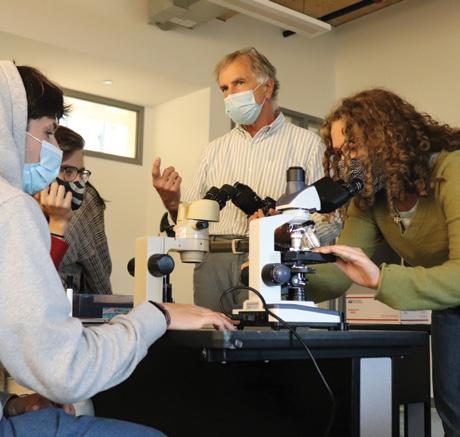
entomology and scientific illustration into my existing coursework in neotropical and conservation biology. Student work in the three integrated courses culminated in a public exhibit in the Dorr Museum of Natural History upon our return.
I also supervised two senior projects that melded educational outreach, science, and art in two very different ways. One project involved designing and implementing educational material based on the biology of a live reptile for an environmental education center in Lewiston, Maine. Here, the student constructed new housing for a lizard species that was part of COA’s live animal collection, wrote background interpretative material to be used in future programs, and designed and produced interpretative signs for the enclosure.
A second senior project used original images and text of the habitat, fauna, and flora of the student’s native country of Colombia, South America as the basis for a book and museum exhibit. The student’s intentions were to educate readers of her book and viewers of her exhibit on the rich and varied biodiversity found within her home country.
Finally, I participated in college governance as a standing member of the Academic Affairs Committee, Museum Committee, and the Expeditionary Program Taskforce throughout the academic year.

James Russell Wiggins Chair in Government and Polity and Philip Geylin Fund for Government and Polity
Chairholder: Jamie McKown, PhD, Associate Dean for Academic Affairs
This past year was one of exciting and transformative possibility for faculty here at College of the Atlantic. While the recent wave of faculty and staff retirements has left us missing the presence of long-standing colleagues, the infusion of new faces taking their place has opened new opportunities for collaboration and experimentation.
This past fall I offered a retooled version of my Equal Rights, Equal Voices class that looks at the history of the women’s suffrage movement in the United States by studying public speeches by activists of the period. We have recently adjusted the nature of the course to make it more accessible to incoming first-year students and to add more foundational hands-on applied training in the use of digital history archives for research work. While the class is open to all students, our hope is that new incoming students will take advantage of the opportunity to conduct applied research and, in the process, become more familiar with the wide array of archival resources that are digitally available to them. These skills will be useful to them in future classes and independent work.
November brought with it the midterm elections, and the usual array of related campus activities including voter registration drives, assistance with absentee ballots, nonpartisan voter information sessions, and our election day Get Out the Vote
The Wiggins Chair honors the memory of former COA trustee James Russell Wiggins, one of the most respected and influential figures in American journalism. His career spanned three-quarters of a century, including 20 years as editor of the Washington Post. After his retirement, he was nominated by President Lyndon Johnson to serve as US Ambassador to the United Nations. Over the course of his final three decades, he was owner and editor of the Ellsworth American.
Another former trustee, Philip L. Geyelin, initiated the idea of the Wiggins Chair and led the fundraising campaign to create it. At the time of Phil’s death, COA wanted to honor the renowned WashingtonPost senior editor and Pulitzer Prize-winning author and extend the project by creating this fund to support programs in government, international affairs, and politics
(GOTV) programs. This year we added a new and quintessential COA flair to the GOTV effort. Our new faculty member in music, Jonathan Henderson, happened to be teaching his samba
percussion class on the afternoon of the election. Rather than practicing in Gates Auditorium, Jonathan had his class march around campus drumming an infectious rhythm, encouraging students to follow them like Pied Pipers back to the shuttles that were heading out to the polls. I cannot say for certain whether this new strategy led to any large increases in turnout, but it certainly added a wonderfully fun and festive element to the entire day and perhaps set a precedent for future election days.
In the winter term, I once again taught my seminar on Conspiracy Theory and Politics. This seminar has long been popular with students, though I am not entirely excited by just how salient and timely the content is of late! Throughout this past year I have entertained numerous requests for interviews and public talks on the topic, though unfortunately my administration duties currently
JAMES RUSSELL WIGGINS CHAIR
limit that availability. I do anticipate that my time as Associate Dean will be coming to end soon, and I look forward to being able to dedicate more energy to engaging our students in various research projects in the area.
In the spring, I had the chance to work with a small group of five students in an advanced seminar on election law and policy in the United States. The advantage of having such a small seminar is that it allowed us to spend some time deciding what topics we wanted to cover. In addition to some core historical material, we covered a number of topics related to the Voting Rights Act, gerrymandering, compulsory voting, voter holidays, and alternative electoral systems such as ranked choice voting, approval voting, and single transferrable votes.
PHILIP GEYELIN FUND
Beginning Fund Balance $197,458
COA drew me with its sustainable goals and plans, and pulled me with the closeness of a family. But on top of anything else I was convinced that at COA I could express who I am in the most authentic and unique ways.
Whether I am interested in photography, videography, drones, marine biology, birds, and even guitar— COA will accept that form of me.
ILHAM SANTOSO ’24
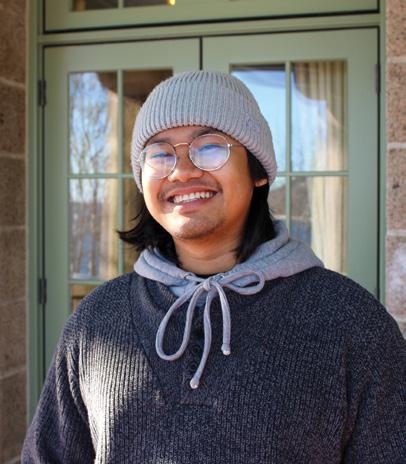
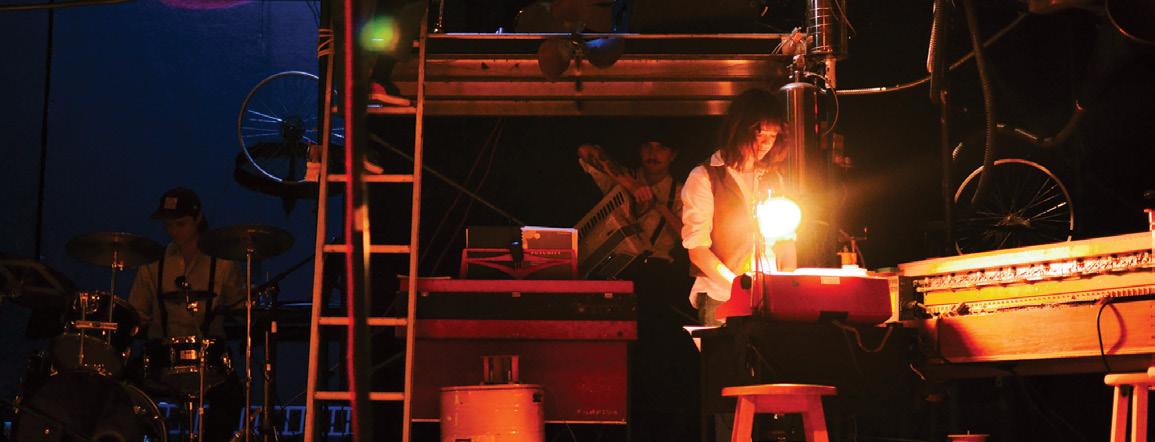
Joanne Woodward and Paul Newman Chair in the Performing Arts
Chairholder:
Jodi Baker
Performance study at COA evolved in some exciting ways this year. I was able to collaborate with students and colleagues in multiple different contexts, and my own work grew exponentially from those experiences. I taught both foundational and advanced level coursework, contributed to the governance and function of the college, and had the opportunity to connect with a handful of artists from outside the COA community whose
In the fall of 2022, I collaborated with seven other COA faculty members on the Human Ecology Core Course and also offered my American Dream course, which investigates 20th century cultural and political history through dramatic literature and performance practice.

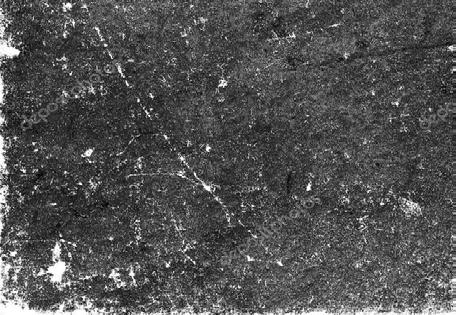
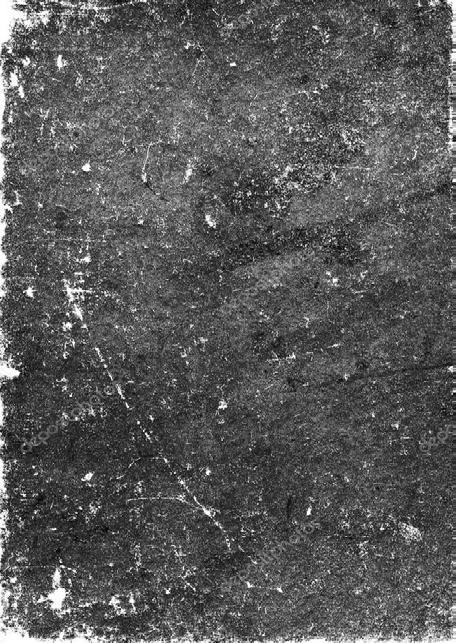
In the winter, I co-taught a three-credit large-scale practicum with music professor Jonathan Henderson. Together with a group of 22 students we researched, rehearsed, and produced our own rendition of César Alvarez’s and the Lisps’ contemporary folk musical Futurity. As part of this process, we had the luxury of working with electroacoustic sculptor Mark Dixon. Many of Mark’s musical instruments were featured prominently in the show, and both Mark and César Alvarez were able to visit campus to assist and experience the work. The students’ deep commitment to this project and the high level of work they produced was extraordinary. It was a gift to be a part of. Anna Parsons ’23 served as lead dramaturg for this production, and was accepted soon after into the graduate program in International Dramaturgy (Arts and Culture) at the University of
Several anonymous donors established this endowed faculty chair in 2019 as part of the Broad Reach Capital Campaign, in honor of the renowned actors Joanne Woodward and Paul Newman, whose daughter, Nell Newman, graduated from COA in 1987.
COLLEGE OF THE ATLANTIC PRESENTS:
Amsterdam, one of the most prestigious programs of its kind in the world (we are all of course, super proud).
In the spring, I co-taught Politics, Body and Representation in collaboration with Netta van Vliet, professor of cultural and political anthropology. PBR is an advanced level course that combines postcolonial and feminist theory (among other texts) with theatrical physical training methods in an effort to investigate the ways in which the body directly and indirectly challenges assumptions about politics and representation.
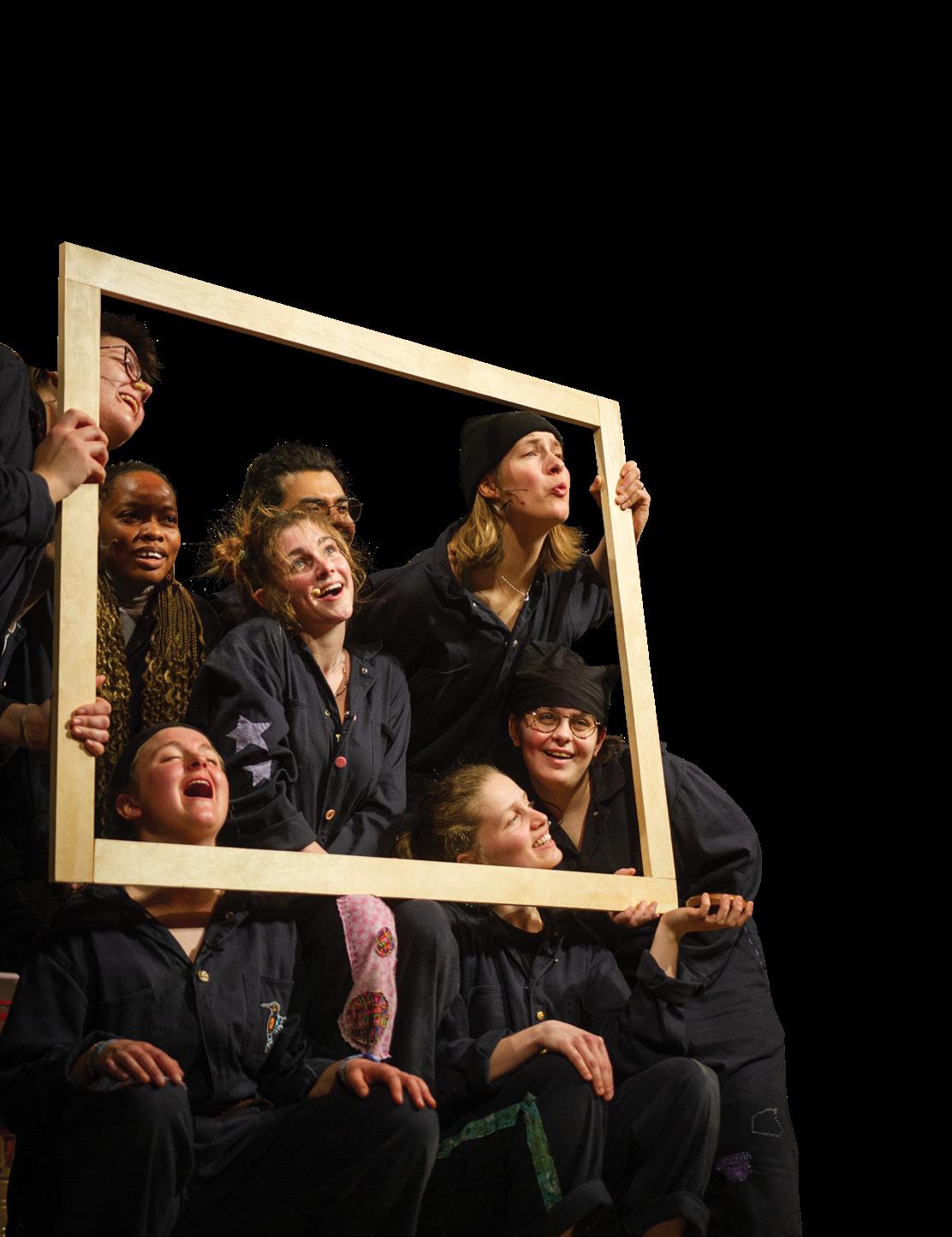
I also reworked Dramatic Mechanics, fundamentally a form and function course that looks closely at the style and structure of a wide variety of old and new plays, considering how they are built and, as importantly, how different choices in production create new meaning.
Additionally, I managed to recruit a long-time friend and colleague, performance artist Donna Oblongata to come to COA in the spring as part of our budding Arts Fellows Program. Donna workshopped her new musical about the Earth First! movement, and also taught a class in clowning methods and practice. Donna is a tremendous artist and her courses provided an incredible and unique opportunity for COA students. I am so happy we were able to make it happen.
Beyond this, I directed two senior projects, four independent studies, and served as academic advisor for 10 students. I once again helped direct and produce the end-of-year senior project presentations for the Board of Trustees.
All this work was made possible by funds from this endowed chair and several other intersecting and generous endowments that fuel art and performance study at COA. I remain incredibly grateful for the exceptional teaching and learning opportunities these funds provide.
ENDOWED SCHOLARSHIPS
Nancy Aronson Scholarship
This scholarship was established during the Broad Reach Capital Campaign to benefit students with financial need.
RECIPIENT: Erica Gross ’23 (Minneapolis, MN)
BEGINNING BALANCE: $108,642 ENDING BALANCE: $123,008
Brooke and Vincent Astor Scholarship
This scholarship was created in 2012 through a generous bequest from Mrs. Brooke Astor to COA, as well as gifts from the Vincent Astor Foundation. It is awarded to Maine students with financial need.
RECIPIENTS: Gabrielle Peñalver Dumas ’23 (Peaks Island, ME), Isabella Pols ’24 (Brunswick, ME), Megan Waters ’23 (Starks, ME)
BEGINNING BALANCE: $901,358 ENDING BALANCE: $986,336
Christina and William Baker Scholarship
Family and friends of Christina ‘Tina’ Baker established this fund in 2013 in memory of Tina. After the passing of Tina’s husband, William ‘Bill’ Baker in 2021, the family added Bill to the scholarship name and amended the criteria. This four-year scholarship is awarded to students with financial need with a preference towards first-generation and BIPOC (Black, Indigenous, people of color) students.
RECIPIENT: Ruby DeWilde ’25 (Portland, OR)
BEGINNING BALANCE: $89,840
ENDING BALANCE: $113,716
Sidney and Hazel Demott Bahrt Scholarship
The scholarship was created in 2008 through a bequest from Sidney and Hazel Bahrt to COA. The four-year scholarship is awarded to a Washington Academy graduate from Pembroke. Depending on COA’s enrollment, the scholarship may also be awarded to other students from Washington Academy or from the greater Washington County community.
RECIPIENT: Sage Bagley ’23 (East Machias, ME)
BEGINNING BALANCE: $866,111
ENDING BALANCE: $954,491
Judith Blank and Steve Alsup Scholarship
Created in honor of two wonderful people who have lived on MDI for many years. Both talented makers: Judith a very gifted fiber artist mixing the colors of the woods and waters magically in her rugs. Steve a builder and artisan in metals. To sit around a fire with a cup of tea chatting of many thoughts and things was as fine a way to spend time as could be thought of. Student selection criteria: fiber arts, metal arts, handcrafts.
RECIPIENT: Simone LePage ’23 (Brooklyn, NY)
BEGINNING BALANCE: $105,578 ENDING BALANCE: $113,810
Lynn Boulger Young Writers Scholarship
This scholarship was created in 2020 as part of the Broad Reach Capital Campaign in honor of Lynn Boulger to recognize COA students with gifts in writing and provide them with the chance to develop those skills through the COA curriculum. This scholarship is awarded to students who demonstrate
financial need and great talent in writing.
RECIPIENT: Tanvi Koushik ’23 (Bengaluru, India)
BEGINNING BALANCE: $68,786
ENDING BALANCE: $89,026
Bright Horizons Scholarship
The Bright Horizons Scholarship was established by Bar Harbor Bank and Trust as part of the Life Changing, World Changing Capital Campaign. The scholarship is awarded to local Maine students who are graduates of high schools located in Hancock and Washington Countiess.
RECIPIENT: Hope Rankin ’25 (Bucksport, ME)
BEGINNING BALANCE: $187,318 ENDING BALANCE: $243,210
Roc and Helen McGregor Caivano Scholarship
Created to honor two heartfelt and wonderful people, full of kindness and knowledge. From the beauty of a flower to the architecture of shelters, buildings and cities. Student selection criteria: architecture, landscape design.
RECIPIENT: Josiah Hansen ’23 (North Haven, ME)
BEGINNING BALANCE: $129,114
ENDING BALANCE: $140,869
Helen Caldicott Scholarship
Created to honor Helen Caldicott, an Australian physician, author, and anti-nuclear activist who has founded several associations (Physicians for Social Responsibility among them) to educate the public about the ongoing dangers of nuclear weapons proliferation and war. Student selection criteria: social
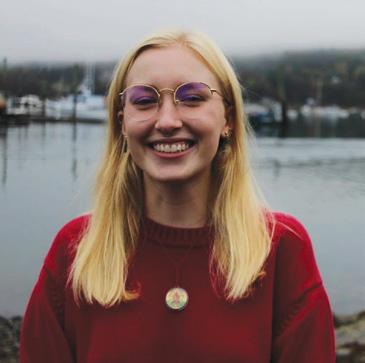
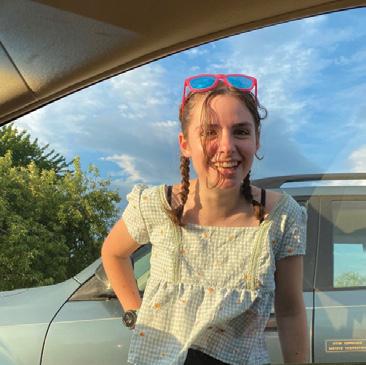
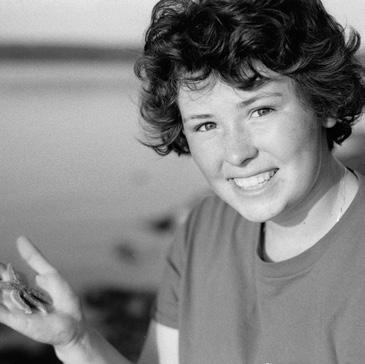

responsibility, advocacy, renewable energy.
RECIPIENT: Liz Morrison ’24 (Doyle, TN)
BEGINNING BALANCE: $105,578
ENDING BALANCE: $113,810
Alida Camp Scholarship
This scholarship was created in 2018 by David Milliken as part of an effort to honor family, friends, and public figures and the characteristics David admires in them. This scholarship supports a student working in fields of related interest to the individual honored by the scholarship. Characteristics and interests that speak to the honoree include: oceans, community, craft, sailing, humor, integrity.
RECIPIENT: Sil Kiewiet de Jonge ’23 (Monnickendam, Netherlands)
BEGINNING BALANCE: $109,866 ENDING BALANCE: $117,799
Rachel Carson Scholarship
This scholarship was created in 2018 by David Milliken as part of an effort to honor family, friends, and public figures and the characteristics David admires in them. This scholarship supports a student working in fields of related interest to the individual honored by the scholarship. Characteristics and interests that speak to the honoree include: investigation, deep deeing, dot connecting, exposing of toxins in environment, and revealing the destruction of nature and natural habitats.
RECIPIENT: Savannah Averitt ’25 (Nellysford, VA)
BEGINNING BALANCE: $109,866 ENDING BALANCE: $117,799
Rebecca Clark Memorial Scholarship in Marine Sciences
The scholarship was established in 2004 in memory of Rebecca Clark, a COA graduate who lost her life in the 2004 Indian Ocean tsunami in Thailand. The fund was started with a lead gift from trustee Edward
McC. Blair and support from many friends and family of Rebecca. The scholarship is awarded to a rising junior or senior, exemplary in dedication, enthusiasm, passion and scholarship, in the field of marine science and/or marine conservation.
RECIPIENT: Rosie Chater ’25 (Pony, MT)
BEGINNING BALANCE: $449,227 ENDING BALANCE: $511,705
Christensen Scholarship
This scholarship was created in 2005 with a gift from the Christensen Fund. It is awarded to students with financial need, with a preference towards international students.
RECIPIENT: Lenka Slamova ’24 (Říčany, Czech Republic)
BEGINNING BALANCE: $320,969 ENDING BALANCE: $351,430
Richard Slaton Davis and Norah Deakin Davis Scholarship
This scholarship was created in 2004 by Norah Deakin Davis, the widow of Richard S. Davis (Dick), a founding faculty member who passed away at the age of 41 in 1982. Mrs. Davis’s pledge spurred additional gifts from friends and former students of Dick. Recipients are outstanding students in the contemplative, aesthetic, and philosophical aspects of human ecology that Dick loved.
RECIPIENTS: Odin Gage ’24 (Thorndike, ME), Philéas Dazeley-Gaist ’23 (Nantes, France)
BEGINNING BALANCE: $134,763 ENDING BALANCE: $147,600
Rosie Chater ’25
Sage Bagley ’23
Isabella Pols ’24
Lenka Slamova ’24
THE DREIER SCHOLARSHIPS
BEGINNING BALANCE: $37,711
ENDING BALANCE: $41,472
John C. Dreier Scholarship
The scholarship was created in 2006 by the children and friends of John and Louisa Dreier. It is given to a junior who has shown leadership in building community spirit both on campus and in the college’s surrounding communities.
RECIPIENT: Sarah Ottinger ’25 (Colfax, WI)
Louisa R. Dreier Scholarship
The scholarship was created in 2006 by the children and friends of John and Louisa Dreier. The scholarship is given to a junior who embodies the spirit of joy in the arts.
RECIPIENT: Simone LePage ’23 (Brooklyn, NY)
Samuel and Mary Kathryn Eliot Scholarship
The scholarship was established by COA’s trustees to honor Sam Eliot as he retired from COA after 11 years as vice president. Mary Kathryn served as fundraising assistant to COA’s first president and designed the college’s iconic logo. It is awarded to Maine students with financial need.
RECIPIENT: Ella Giroux ’25 (Vassalboro, ME)
BEGINNING BALANCE: $159,817 ENDING BALANCE: $175,462
Heather Richards Evans Scholarship
This scholarship was established during the Broad Reach Capital Campaign to benefit students with financial need.
RECIPIENT: Adam Feher ’23 (Strongsville, OH)
BEGINNING BALANCE: $110,857 ENDING BALANCE: $294,422
Anne Franchetti Scholarship
This scholarship was created in 2018 by David Milliken as part of an effort to honor family, friends, and public figures and the characteristics David admires in them. This scholarship supports a student working in fields of related interest to the individual honored by the scholarship. Characteristics and interests that speak to the honoree include: study of oceans, making, chemistry, medicine, curiosity, dowsing, whimsy, laughter, global thinking, ceramics.
RECIPIENT: Raheem Khadour ’25 (Syria)
BEGINNING BALANCE: $109,866 ENDING BALANCE: $117,799
General Scholarship
The General Scholarship Fund was established in 1984. The fund contains gifts given by hundreds of friends in every amount for unrestricted student scholarships. We continue to accept donations for this important endowment. There are many students who recieve aid from this fund. Here are a few::
RECIPIENTS: Gillian Teall ‘24 (Ann Arbor, MI), Abigail Thornton ‘26 (Audubon, PA), Benjamin Troutman ‘24 (Montville, ME), Megan Waters ‘23 (Waterville, ME)
BEGINNING BALANCE: $1,076,526 ENDING BALANCE: $1,184,982
Craig Greene Memorial Scholarship
This scholarship was created to honor the late Craig William Greene, former Elizabeth Battles Newlin Professor in Botany. It is
awarded to two rising juniors or seniors who have excelled in botany and general biology classes, and who share Craig’s passion for the world of flora.
RECIPIENTS: Jennifer McNamara ’23 (Bernard, ME), Finley O’Connor ’24 (Harwinton, CT)
BEGINNING BALANCE: $93,246 ENDING BALANCE: $101,652
Hartzog-Kauffmann Scholarship
This award honors both George B. Hartzog and John M. Kauffmann. Kauffmann, who passed away in 2014, was a former COA trustee, and retired to MDI after a long career at the National Park Service, most notably in Alaska where he helped define the boundaries of the Gates of the Arctic National Park. George Hartzog, head of the National Park Service from 1964–1972, was a hero of John’s and revered by many for the way he managed the agency and defended the NPS during his tenure. It is awarded to students who have an interest in the management and protection of ecosystems—especially wilderness and rivers.
RECIPIENT: Ella Reilich Godino ’23 (Steuben, ME)
BEGINNING BALANCE: $418,902 ENDING BALANCE: $438,515
August Heckscher Scholarship
The scholarship was created in 1997 through gifts from friends and family of August Heckscher, an artist, author, and public servant whose life and work encompassed many of the values and principles underlying the study of human ecology. It is awarded to two students, preferably juniors, with preference for those whose work focuses on public lands, government, or the arts.
RECIPIENTS: Marlon Andrew ’24 (New Canaan, CT), Margaret Denison ’23 (Schaghticoke, NY)
BEGINNING BALANCE: $173,308 ENDING BALANCE: $181,953
Justine Hooper Scholarship
This scholarship was created in 2018 by David Milliken as part of an effort to honor family, friends, and public figures and the characteristics David admires in them. This scholarship supports a student working in fields of related interest to the individual honored by the scholarship. Student selection criteria: art, craft, landscape design.
RECIPIENT: Rosie Chater ’25 (Pony, MT)
BEGINNING BALANCE: $109,866 ENDING BALANCE: $117,799
Louise H. and David S. Ingalls Scholarship for International Students
This scholarship was created in 2018 with a gift from the Louise H. & David S. Ingalls Foundation. It is awarded to students with financial need, with a preference towards international students.
RECIPIENT: Malek Hinnawi ’25 (Palestine/Syria)
BEGINNING BALANCE: $88,524 ENDING BALANCE: $95,077
Larry Lutchmansingh Scholarship
In honor of a college professor who in the best sense of the teaching craft opened the eyes and hearts of his students to art and art history. Student selection criteria: education, teaching, humanities, art history.
RECIPIENT: Eva Pearlingi ’25 (Arcata, CA)
BEGINNING BALANCE: $105,578 ENDING BALANCE: $113,810
MAINE COMMUNITY FOUNDATION HELD SCHOLARSHIPS
Edward G. Kaelber Scholarship for Maine Students of Outstanding Promise
COA and the Maine Community Foundation created the Edward G. Kaelber Scholarship for Maine Students of Outstanding Promise to honor Ed Kaelber for his leadership and for his contributions in the fields of education and community development. The scholarship provides opportunities for Maine students who possess the potential for the kind of boldness, commitment, and leadership personified by Ed Kaelber, and who will use their skills and talents to impact their communities in equally significant ways.
RECIPIENT: Conrad Kortemeier ’26 (Bristol, ME)
Alice Blum Yoakum Scholarship
This scholarship was created in 1996 by former trustee Robert Blum, honoring his daughter Alice. It is awarded to students who plan to actively work for biodiversity and especially for the preservation of underwater species in various parts of the world.
RECIPIENT: Bailey Tausen ’23 (Taneytown, MD)
MAINE STUDENT SCHOLARSHIP FUND
The Maine Student Scholarship Fund is an endowment created through generous gifts to the COA Silver Anniversary Campaign from the organizations listed below.
BEGINNING BALANCE: $791,760
ENDING BALANCE: $826,947
Betterment Scholarship
This scholarship was created in 1995 through a gift from the Betterment Fund, and supports students from Bethel, Oxford County, and the State of Maine, in that order of priority.
RECIPIENT: Eva McMillan ’23 (Rangeley, ME)
H. King and Jean Cummings Scholarship
This scholarship was established with a gift from the H. King & Jean Cummings Charitable Trust. Mr. Cummings led his family’s business, Guilford Industries, a textile manufacturer in Guilford, Maine. He later served as CEO of Sugarloaf ski area and played decisive roles in the founding of Carrabassett Valley Academy and Maine Community Foundation. The scholarship is awarded to students from western Maine.
RECIPIENT: Cheyanne Goroshin ’24 (Sumner, ME)
Kenduskeag Scholarship
This scholarship was created in 1995 with two gifts from Dead River Company and the Kenduskeag Foundation. It is awarded to Maine students with financial need.
RECIPIENT: Hayden Platteter ’24 (Phippsburg, ME)
John McKee Scholarship
Created in honor of a master of black and white and color photography who uses his knowledge of the medium to awaken the awareness of a student to framing a shot, to the play of shadow and light, to notice color and color saturation. A wonderful, thoughtful and kind man. Student selection criteria: photography.
RECIPIENT: Ben Troutman ’24 (Montville, ME)
BEGINNING BALANCE: $105,578
ENDING BALANCE: $113,810
Phoebe and Gerrish Milliken Scholarship
This scholarship was created in 2018 by David Milliken as part of an effort to honor family, friends, and public figures and the characteristics David admires in them. This scholarship supports a student working in fields of related interest to the individuals honored by the scholarship. Characteristics and interests that speak to the honorees include: birding and preservation of wild habitat, service, loyalty, care, attention to detail.
RECIPIENT: Levi Sheridan ’24 (Lansing, MI)
BEGINNING BALANCE: $124,367
ENDING BALANCE: $140,084
Pamelia Markwood Neff Scholarship
The scholarship was established by Craig Neff “to honor the extraordinarily creative, loving, generous, energetic person Pammie was. She had an incredible passion for taking care of the planet, protecting wildlife and habitat, and encouraging everyone to learn more about nature and science. I know COA’s commitment to those values is strong and we have always admired the school, the staff and the wonderful students and graduates we have come to know.”
RECIPIENT: Lydia Burnet ’25 (Asheville, NC)
BEGINNING BALANCE: $129,758 ENDING BALANCE: $144,098
Barbara Piel Scholarship
The scholarship was created in 2004 through a bequest from Barbara Piel to College of the Atlantic. She was a great friend of the college, deeply interested in the natural world and inspired by “the intense individuality of students and staff” at COA. This annual scholarship is awarded to students with financial need.
RECIPIENT: Maddy Stevens ’23 (Kent, CT)
BEGINNING BALANCE: $498,648 ENDING BALANCE: $544,598
Eleanor T. and Samuel J. Rosenfeld Scholarship
The scholarship was created in 2000 by Eleanor T. and Samuel J. Rosenfeld. This annual scholarship is awarded to students with financial need.
RECIPIENT: Leander Laga Abram ’26 (Santa Fe, NM)
BEGINNING BALANCE: $13,311 ENDING BALANCE: $14,361
Maurine P. and Robert Rothschild
Graduate Scholarship
This scholarship was created in 1997 with a gift to the Silver Anniversary Endowment Campaign by trustee Maurine P. Rothschild and her husband Robert Rothschild. The scholarship is awarded to qualified graduate students with preference given to those pursuing work in the education field.
RECIPIENTS: Olivia Paruk ’24 (Gorham, ME), Ruvan de Graaf ’22, MPhil ’24 (Eveni, Swaziland)
BEGINNING BALANCE: $276,300 ENDING BALANCE: $301,958
Michael and Rose Russo Scholarship
The scholarship was created in 2013 through a gift made by Jay McNally ‘84 to honor his maternal grandparents. This four-year scholarship provides financial assistance to a high-achieving student who is a great fit with

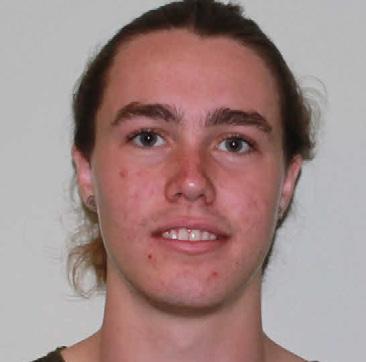
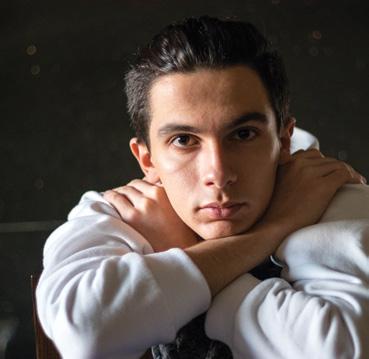
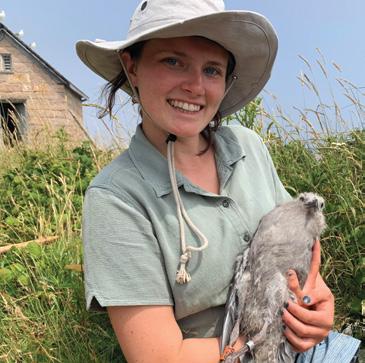
Jennifer McNamara ’23
Eva McMilan ’23
Leander Laga Abram ’26
Malek Hinnawi ’25


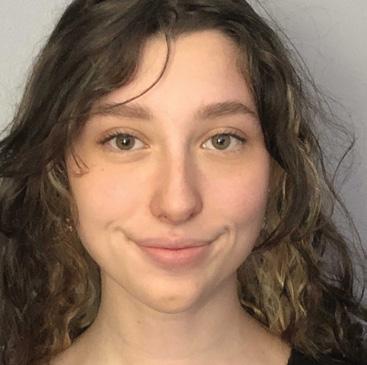
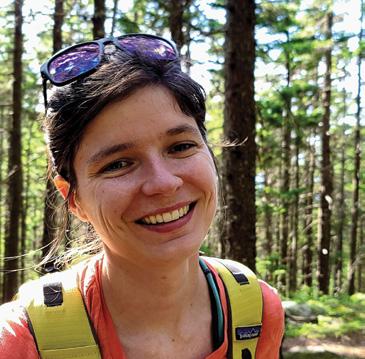
the mission of COA and would otherwise not be able to attend.
RECIPIENT: Autumn Pauly ‘26 (Saint Peter, MN)
BEGINNING BALANCE: $686,914 ENDING BALANCE: $720,453
Charles and Katharine Savage Scholarship
This scholarship was created in 2018 by David Milliken as part of an effort to honor family, friends, and public figures and the characteristics David admires in them. This scholarship supports a student working in fields of related interest to the individuals honored by the scholarship. Characteristics and interests that speak to the honorees include: Love of wood, landscapes and gardens, books, art, music, lifelong love of learning, letters, winter structure of plants, compassion and empathy, love and leadership in community.
RECIPIENT: Jennifer McNamara ’23 (Bernard, ME)
BEGINNING BALANCE: $109,866 ENDING BALANCE: $117,799
Donald Straus Scholarship
This scholarship was created in 2008 with a gift from Donald and Beth Straus. It is awarded to a rising junior or senior who shows promise in working for cultural change, collaboration, in the field of human relations and/or leadership.
RECIPIENT: Aishwarya Devarajan ’24 (Edison, NJ)
BEGINNING BALANCE: $227,376
ENDING BALANCE: $248,424
Joan and Dixon Stroud Scholarship
This scholarship was created in 2018 by David Milliken as part of an effort to honor family, friends, and public figures and the characteristics David admires in them. This scholarship honors the Strouds’ love of family, care of community, embrace of beauty and aesthetics, respect for the past, and belief in the future. Interest in the investigation of unpolluted
water and riparian habitats as an essential support of life. Student selection criteria: water quality, wildlife habitat, community service.
RECIPIENT: Maggie Denison ’23 (Schaghticoke, NY)
BEGINNING BALANCE: $109,866 ENDING BALANCE: $117,799
ANNUAL SCHOLARSHIPS (NOT ENDOWED)
Alumnx Climate Action Scholarship
This scholarship was created in 2020 during the Broad Reach Capital Campaign by four alumnx—Taj Schottland ’10, David Winship ’77, Kyle Shank ’14, and Rich Van Kampen (’13)— to recognize students with a passion for environmental and climate activism.
RECIPIENT: Emiliana Reinoso ’24 (Valparaiso, Chile)
Great Lakes of Africa Scholarship
This scholarship was created in 2007 with the goal of providing a COA education for a student from the Great Lakes region of Africa who is a secondary school graduate and demonstrates an affinity for human ecology and embraces the vision and mission of COA.
RECIPIENT: Ninoska Ngomana ’23 (Massinga, Mozambique)
Water is Life Scholarship
This scholarship was established in 2021 by Ellen Seh (’75) for students with demonstrated need, with a preference for women who have an interest in freshwater resources—especially efforts focused on the protection of water quality and quantity for drinking water and ecological integrity.
RECIPIENT: Sarah Ottinger ’25 (Colfax, WI)
Raheem Khadour ’25
Maddy Stevens ’23
Cheyanne Goroshin ’24
Maggie Denison ’23
ENDOWED FUNDS
Cox Protectorate Fund
Staff Supervisor: Darron Collins ’92, President
Over the years, the Cox Protectorate has provided opportunities for COA students to study wildlife, botany, geology, history, GIS mapping, and more.
In 2023 it was an important site for students in John Anderson’s Wildlife Ecology class. He took them to the Protectorate on multiple class field trips, and they also went as small groups to check game cameras and do small mammal trapping. This was critically important for students who subsequently worked with Brittany Slabach ’09 on her Second Century Research grant. Brittany is currently teaching at Trinity University in Texas, and she is conducting a study of small mammals in Acadia National
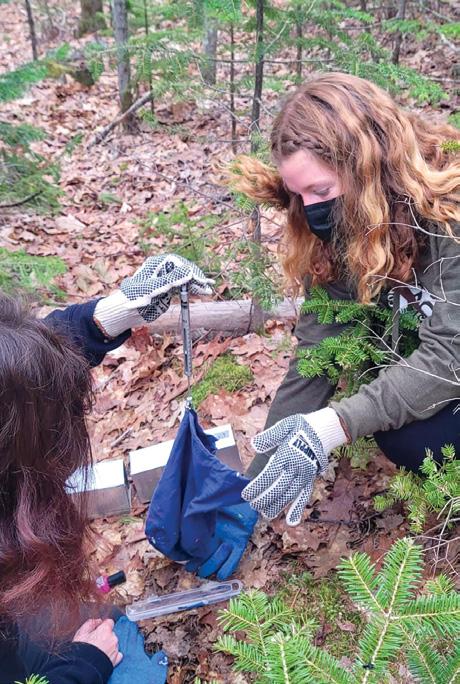
Park. She recruited multiple COA students to assist her in the work, and their experiences on the Cox Protectorate were key to their being useful in this important study.
Additionally, every student in the incoming 2023 class spent a three-hour lab session exploring the Cox Protectorate. Done in individual sections of 13-16 students, Ken Cline focused his module in the Human Ecology Core Course on the Cox Protectorate. The lab consisted of a walking tour of the property and a discussion with each section about the opportunities presented by the Protectorate and what its future should be. Porcupines, Barred owls, numerous birds, and brilliant fall foliage greeted the various student group sections while they explored the landscape.
The Cox Protectorate is a 101-acre tract of undeveloped property near the center of Mount Desert Island that was donated to COA by former trustee Tom Cox in 2010, along with a fund to tend the property. The property encompasses Mill Brook, part of the headwaters of Northeast Creek. The Protectorate has walking trails for recreation, but is mainly used for an array of interdisciplinary courses, projects, and research, including annual surveys by students in COA’s WildlifeEcology class.
And finally, in 2023 the COA Board of Trustees enjoyed a trip to the Protectorate to consider using part of the site for critically needed faculty and staff housing—a use that accords with the donor’s original intent. Given the generous size of the property, we believe it can serve multiple needs.
Beginning Fund Balance
$119,233
Net Return on Investments 17,525 Contributions 0 Less Allocations/Withdrawals (9,200)
Fund Balance $127,558
Students weigh a deer mouse as part of their fieldwork on the Cox Protectorate.
David Hales Director of Sustainability Fund
Staff Supervisor: David Gibson, CEM, LEED AP BD+C, Director of Energy
Peggy and Henry Sharpe established this fund in honor of COA’s fifth president, David Hales, upon his retirement. Hales led environmental policy and sustainability programs for the US Agency for International Development, and was the first American to serve as chair of the World Heritage Convention.
This year we have continued to make strides towards our goal of eliminating fossil fuel use on campus by 2030.
In September, we installed a whole-building ducted heat pump in Witchcliff. This replaced the 1984 kerosene furnace, and extinguished fossil fuel consumption in the building. The old system burned about 1,500 gallons of kerosene each year, so this upgrade provided COA with a net savings of around $5,000 in the first year, after accounting for the increased electrical usage. The new system performed very well all winter, and provides air conditioning in the summer.
During the fall term, I taught Practicum in Sustainable Energy. The course offered students the opportunity to directly participate in energy efficiency improvements on campus. We installed a basement vapor barrier, insulated the attic of an off-campus housing unit, and led a Window Dressers workshop on campus. Window Dressers are insulating window inserts that add a double-pane of plastic on the interior of existing windows, significantly reducing heat loss. More than 80 volunteers participated in the workshop, including students, faculty, staff, and MDI community members. We built 350 window inserts for nearly all of the single-pane windows on campus.

In November, we installed a commercial split-system heat pump water heater in the Blair Tyson dormitory as part of an Efficiency Maine pilot program. This is the first system of its kind in the state. It provides domestic hot water for all the showers, sinks, and laundry, reducing demand on the oil boiler. This is estimated to save 2,000 gallons of heating oil or more annually, and will demonstrate the viability of the technology for other buildings across the state. We saved approximately $10,000 on contractor costs by insulating the new pipes ourselves.
Over winter break, I had five hard-working students who installed a full vapor barrier in the Turrets basement. This blocks moisture from the ground from getting into the building, which reduces mold, mildew, and rot, and makes a dramatic improvement in air quality. We did the prep work for a contractor to spray foam the basement walls. Following the installation of the spray foam, the Turrets basement was warmer on a record-cold day in February than it had been on a 40-degree day before insulation.
I collaborated with the Building Performance Association on a successful workforce development grant, which funded three students as summer interns, and enabled the students in my spring course to complete certificates in Building Science Principles.
In June, COA collaborated with the non-profit Envirolution to lead a three-day professional development workshop for middle- and highschool teachers. The workshop offered hands-on efficiency and clean energy lessons, which we connected with local career opportunities in the clean energy sector. We took the teachers on a tour of the energy improvements on campus, took a field trip to the solar array at Peggy Rockefeller Farm, and joined Toby for a harbor tour on M/V Osprey. In addition to Envirolution, we collaborated with ReVision Energy, Versant Power, the Governor’s Energy Office, and Maine Climate Action Now for activities and presentations. Participating teachers received a set of classroom materials to lead lessons with their students. With the success of this pilot project, we are planning to expand the program to a full week-long workshop with 20-25 teachers from across the state on campus next summer.
Barbarina M. and Aaron J. Heyerdahl Beech Hill Farm Endowment Fund
Staff Supervisors: Anna Davis and David Levinson, Farm Co-Managers
Here at Beech Hill Farm we had another productive and successful year. Throughout the season, we grew over 100,000 lbs of MOFGA certified organic vegetables which were sold through our farm stand, wholesale accounts, and 100-person summer and fall Community Supported Agriculture (CSA) program.
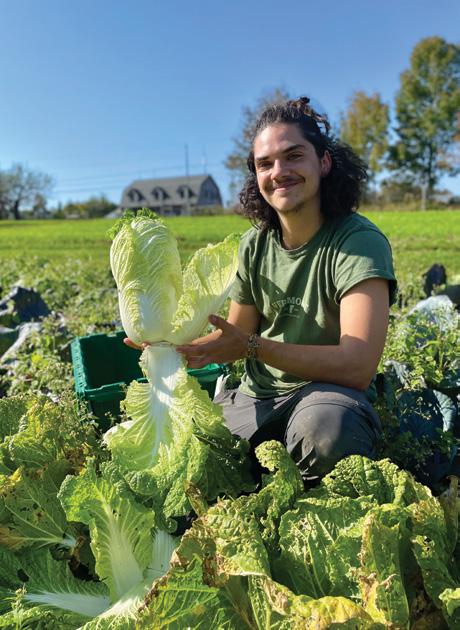
We finished construction on our farmstand renovation and expansion project which included a 400-square-foot addition, spray foam insulation, a 100-square-foot walk-in cooler, and heat pumps. This project will allow us to extend the sales season, improve produce management during the hot summer months, and increase production through expanded storage. This season we also constructed two new greenhouses, adding 4,500 square feet of protected growing space. With the added greenhouses, we will be able to grow more produce in the shoulder seasons to better serve our community and grow more food for campus while classes are in session.
We continued to expand our food access outreach through
working with our community partners. We supplied nearly 5,000 pounds of produce to Hancock County community members through Healthy Acadia’s Gleaning Initiative. We also provided 2,000 pounds of food to the Bar Harbor Food Pantry through the Good Shepherd Food Bank’s Mainers Feeding Mainers program. We continued to supervise and work closely with student coordinators Hannah Crea Frink ’23, Charly Sperling ’24, Mycena Phillips ’23 of our student-run food access project, Share the Harvest. Through Share The Harvest, we provided free produce to low-income residents of Mount Desert Island, as well as 50% discounts in the farmstand to all SNAP and WIC users through our “Double your Dollar” program.
Barbara M. Heyerdahl ’88 and Aaron J. Heyerhdahl ’87 established this endowed fund in 1999 when they donated Beech Hill Farm to COA.
We hosted multiple on-farm events, including the Share the Harvest annual fundraiser concert featuring The Soul Benders, a spring plant sale, and a seed-starting and crop-planning workshop. Beech Hill Farm also partnered with Healthy Acadia and Impact Justice to host a fundraising dinner to support the Chefs in Prisons and Downeast Restorative Harvest projects.
We continue to work toward building soil health and fertility through improved management practices, such as increasing cover cropping, mulching, beneficial insect plantings, and reduced tillage practices.
We employed over 20 work-study students in the spring and the fall, sponsored three summer internships, and hired 15 full-time staff. We hosted numerous class visits from The Community School, MDI High School, and from various COA classes.
CANADA
Attending the United Nations Biodiversity Conference
ALASKA, U.S.A.
Interning as a naturalist aboard tourism excursions
CANADA
Meeting community who have experienced the Mammalian Diving Reflex Theatre Company
WASHINGTON, U.S.A.
Creating a multimedia installation exploring the relationship between winter and rest for both farmers and the land
TEXAS, GEORGIA & SOUTH CAROLINA, U.S.A.
Sampling microplastics within urban retention ponds
MEXICO
Interning in Educational Sexology
Leading a movement workshop at Gathering: Autonomies in Practice festival FRENCH
POLYNESIA
Sailing from the Caribbean to Tahiti via Panama, Galapagos, and the Marquesas (and snorkeling, of course!)
COSTA RICA
Examining ecology and biotic diversity in key habitats
CHILE
Learning wilderness and leadership skills in Patagonia
MAINE, U.S.A.
Wood-firing pottery
MARYLAND, U.S.A.
Studying economic impacts of battlefield preservation, historical tourism, Civil War marketing, and social capital
COLOMBIA
Working at a national park
URUGUAY & ARGENTINA
Researching deconstruction of the “Latin America” idea

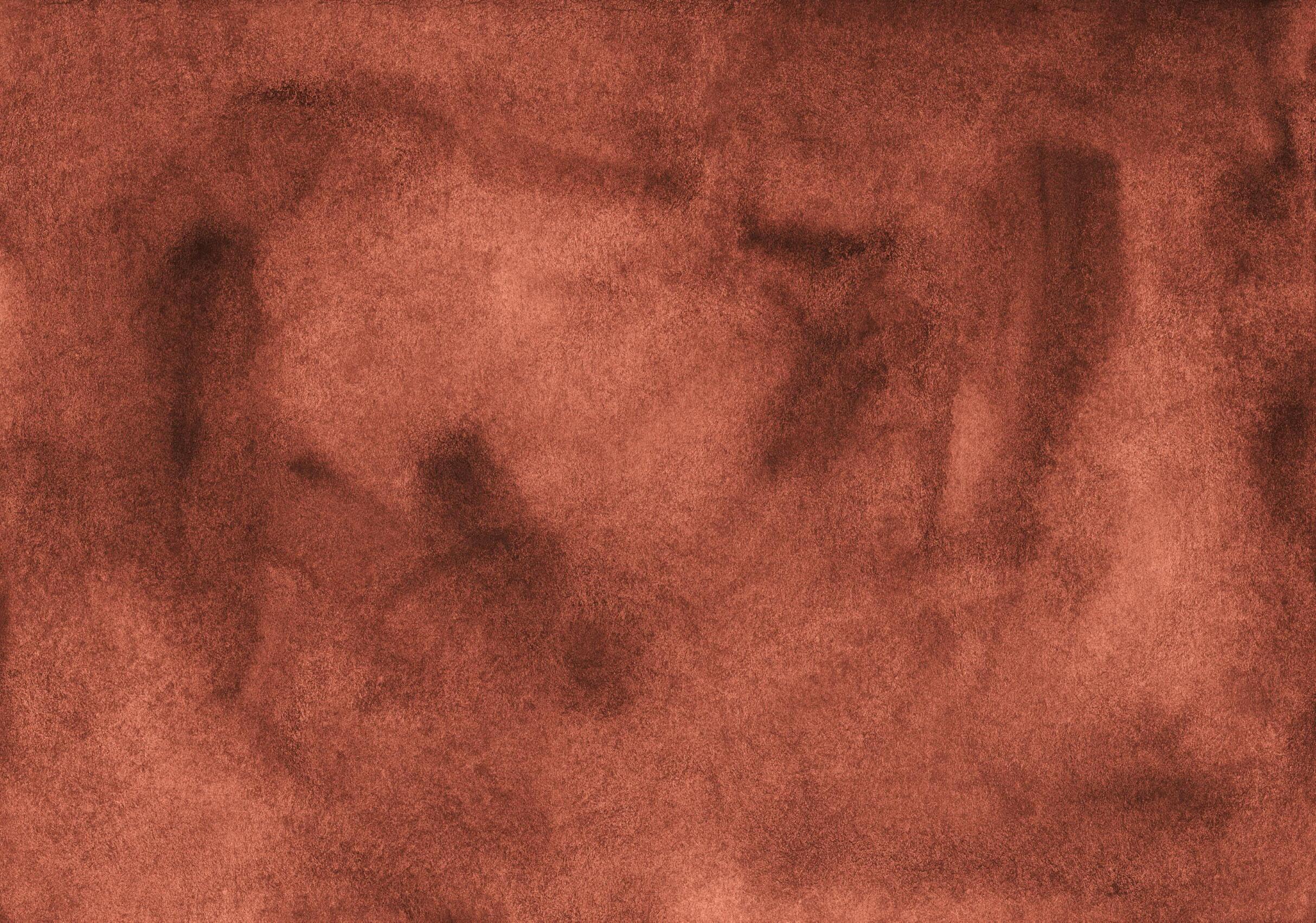


Davis Fund for Global and Civic Engagement
EXPEDITIONARY FUND THE Kathryn
This program was initially endowed by Kathryn W. Davis. Now generally referred to as “the Expeditionary Fund,” it allows COA students the opportunity to learn while travelling as part of their college experience. Each student may apply for up to $1,800 for credit-bearing activities such as travel expenses, residencies, independent studies, internships, senior projects, and attendance at off-campus conferences or meetings.
In 2023, students used their grants to pursue projects in countries including Canada, Mexico, French Polynesia, Uruguay, Mozambique, Kazakhstan, and Japan.
KAZAKHSTAN
Developing bilingual educational software presenting Kazakh culture and history to high school students
GERMANY
Merging food systems with textile art and visiting professional quilters
FRANCE
Participating in French language immersion program
SPAIN
Exploring the crossroads of wine/fermentation, agriculture, food, local culture, and stories/history
EGYPT
Studying comparative global politics
INDIA
Working on a farm
Conducting interviews for a documentary
MOZAMBIQUE
Surveying coral, invertebrate, and fish species while completing a Divemaster diving internship
JAPAN
Exploring the relationship between place and people of Osakikamijima island
Beginning Fund Balance $2,521,326 Net Return on Investments 370,042 Contributions 0 Less Allocations/Withdrawals (251,500) Ending Fund Balance $2,639,868





The Robert P. and Arlene Kogod Visiting Artist Fund
Faculty
Supervisor: Ken Hill, PhD, Provost
Bob and Arlene Kogod established this endowed fund 20 years ago to create opportunities to bring talented artists to COA at a time when the college did not have a robust art faculty. COA has grown since then and has professors in the performing arts, painting and drawing, filmmaking, graphic arts and design, music, landscape design, art history, and printmaking. Today, the Kogod Fund is used to enhance our offerings through lecturers and visiting faculty who offer courses in things like photography, ceramics, and cinema. The fund also supports art supplies and equipment, travel, professional development, and student opportunities that otherwise would not be possible.
The following courses offered by visiting instructors in the 2022–23 academic year were made possible through income from this fund.
DESMOND BEACH
• Introduction to Painting
MICHAEL BENNETT
• World Percussion
• Advanced World Percussion
RYAN BLOTNICK
• Improvisation in Music
• Guitar Fundamentals
CAROLINE COTTER
• Introduction to Songwriting
SAFFRONIA DOWNING
• Craft Ecologies
• Intro to Ceramics (2)
• Silt to Shard
• Craft Ecologies; Mount Desert Island
FRANCE HILBERT
• Figure Drawing
• Introduction to Drawing
JUNE KIM
• Introduction to Photography
HEATHER LYONS
• Into Watery Realms: Image Making as Ritual
ROCKY MANN
• Intermediate Ceramics
Income from the Kogod Fund also helped supplement the cost of COA field trips, equipment, and class costs—including costumes for the Futurity monster course—and paid for teaching assistants for the following courses:
Animation Ceramics
COA Gallery
Documentary Video
Dramatic Mechanics
Futurity: Monster course
Production 4-D Design
Graphic Design Studio II
Installation Art
Making Art: Effort, Resilience, Persistence
Studio Printmaking
ADAM MCLEAN
• Musicianship
ERNIE MCMULLEN
• The Theory and Mystery of Color
DONNA OBLONGATA
• The Art of Clown
• EF!: A New Musical Workshop
LINDA PERRIN
• Introduction to Glass Blowing and Sculpture
MICHAEL REMY
• Music Fundamentals
DANI ROBBINS
• Beginning Contemporary Dance Technique
• Contemporary Dance Composition
• Sourcing the Body: Experiential Anatomy
MATTHEW SHAW ’11
• Landscape Cinema
ZACH SOARES ’00
• Audio Production and Engineering
KRISTY SUMMERS
• Mixed Media Sculpture

Beginning Fund Balance $1,475,437 Net Return on Investments 217,110 Contributions 0 Less Allocations/Withdrawals (79,400) Ending Fund Balance $1,613,146
A student in Saffronia Downing’s class
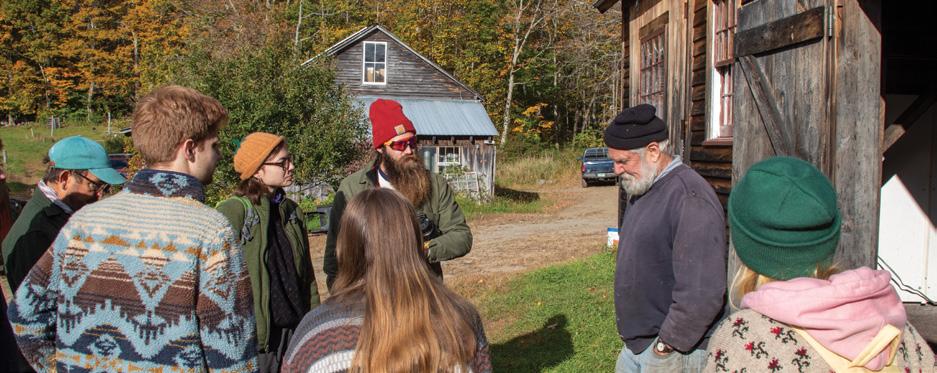
Fund for Maine Islands
Faculty Coordinator: Todd Little-Siebold, PhD
This year, the partnership with the Island Institute has made a dramatic leap forward with the development of several major grant proposals, a new oral history project, a speaker series on blue humanities, and the launch of a collaborative interdisciplinary course called Navigating Change: History, Place, Stories. All of these built upon the partnership’s success, as well as almost decade-long relationships built with support from the fund. The team we have built over the last few years includes Galen Koch of The First Coast, Natalie Springuel ’91 of Maine SeaGrant, Hillary Smith of the University of Maine, Laurie Baker (who teaches data science at COA), and the college’s faculty member in history, Todd Little-Siebold, who continues to serve as program director. The projects rely on student interns, alumnx, and a wide range of community partners.
This professional training pipeline has led this year to a soundwalk in Deer Isle, an Island Institute Fellowship on Swan’s Island, podcasting production work, and ongoing oral history projects. The team approach that has emerged as our modus operandi leverages the skills of a diverse set of professionals to undertake a wide range of projects far beyond what was originally envisioned when we launched the partnership. Leveraging and building on the work funded by the Fund for Maine Islands (FMI), we have been able to secure an additional grant of $196,896 from an anonymous fund at Maine Community Foundation to support Mapping Ocean Stories and additional funds for a NOAA project exploring gendereddimensions of climate change.
The new Navigating Change class involves a four-member interdisciplinary team with expertise in geography, data science/ data visualization, audio production/community storytelling, and history. The team will launch an immersive place-based course
focused on Frenchman Bay. Students selected for this threecredit course will take only this course during the term, learning about the bay from different perspectives while visiting communities, honing skills, and then undertaking project-based learning for five weeks.
The Island Institute and College of the Atlantic launched this partnership in 2014 to seek solutions to sustain island and coastal ecosystems. Funded by a $2M challenge grant from the Partridge Foundation and the support of many other donors who helped secure the match, the fund addresses four areas of critical concern for Gulf of Maine residents: agriculture and food, energy, education, and adaption to climate change.
We also launched the Frenchman Bay Oral History Project with current students (Tiegan Paulson ’25 and Katie Culp ’24) and an alum (Camden Hunt ’22) to collect local traditional knowledge about the bay and its environs. Finally, the team has had success with grant-writing that builds on and complements the work funded by FMI. These include a project on women and climate change and a mapping project associated with the ongoing Atlas of MDI Fisheries.
As we approach our 10th anniversary as partners, the Fund for Maine Islands reveals the power of partnerships, and is a model for how to build effective cross-institution partnerships at COA in the future.
Beginning Fund Balance $1,979,588
291,409
1,000
(105,900)
$2,166,097
McCormick Library Director Fund
Staff
Supervisor:
Jane Hultberg, MLS, Library Director
This year, the library— comprised of Information Services, the College Archives, and Audio-Visual Services—started the summer by conducting a collections inventory. This involved scanning every item with a barcode to ensure our catalog accurately reflects the items in our collection. In spring 2022 we initiated a project to redesign, print, and install new permanent library signage. This work was completed with the help of a library work-study student interested in graphic design.
Nancy Hoskinson McCormick, widow of Charles Deering McCormick established this endowed fund through the Chauncey & Marion Deering McCormick Foundation in 1996.
Throughout the year, we helped work-study students interested in libraries to find various opportunities, including an internship position with the Balsam Consortium (a group of small Maine libraries to which we belong), a volunteer position with the Conners-Emerson school library, a work-study position with the Oral History Project, and a work-study position to familiarize patrons with some of the Thorndike’s new accessibility resources. We also hosted a student intern from the library program at the University of Maine (Augusta).
We had several generous donations and grants this year. The Endeavor Foundation funded a six-month trial (January-June) of a streaming service called Kanopy Base. The Higgins Foundation, which has supported the library’s juvenile and education collections
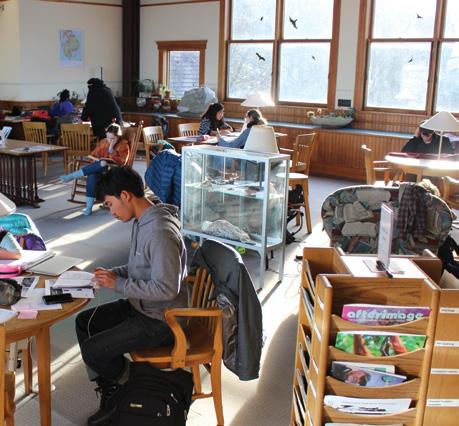
for years, nearly doubled their contribution with a $2,500 award. Finally, we learned in June that the library received a $40,000 grant from the Stephen & Tabitha King Foundation to make accessibility improvements to the entrance of Kaelber Hall and within the library. This grant also allows us to purchase electronic learning and reading aids and software that will be available to our patrons, as well as the Balsam Consortium via interlibrary loan.
We were busy with many of our regular activities, with the help of more than 40 library work-study students. Library staff provided library instruction in classes and met individually with students, interlibrary loan was active, and we continued to build community by coordinating or hosting multiple events and presentations, class exhibits, and senior project displays. Finally, in addition to their regular duties, two library staff members presented a session called Zines: how to inform and enhance representation in collections at the Maine Libraries Association annual meeting in May.
In the archives, this year’s focus was catching up on backlogged work and assisting those needing archive materials. Director of Audio Visual Services Zach Soares ’00 and his work-study students supported 97 events. He was also responsible for overseeing the design, purchase, and installation of $30,000 worth of new lighting in Gates Auditorium.
Finally, this year I announced my retirement to coincide with the end of the 2023 academic year. I am so grateful for everyone I’ve had the opportunity to get to know and work with over the past 20 years, but none more than those in the library. I am so excited to know that my leaving has presented new opportunities for the library staff. Trisha Cantwell and Catherine Preston-Schreck will be library co-directors, and Hannah Stevens ’09 will step away from her archive duties and assume more library responsibilities. A new librarian/archivist will be hired, and Director of Audio Visual Services Zach Soares ’00 will begin reporting directly to the Provost (Ken Hill). I look forward to the next chapter in the library’s history and am thankful to have been part of its history for the past 20 years. Beginning Fund Balance $614,260
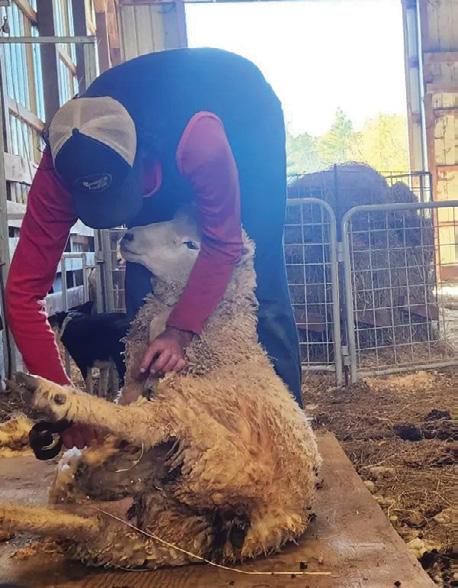
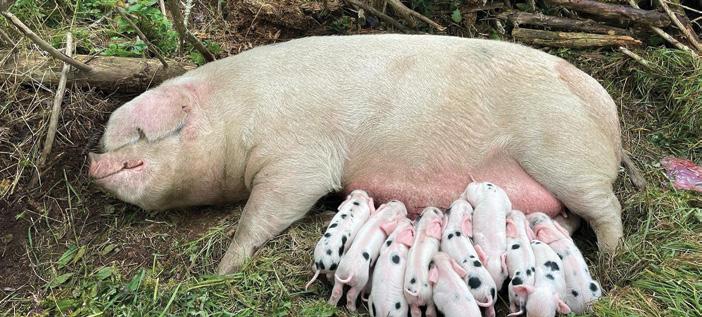
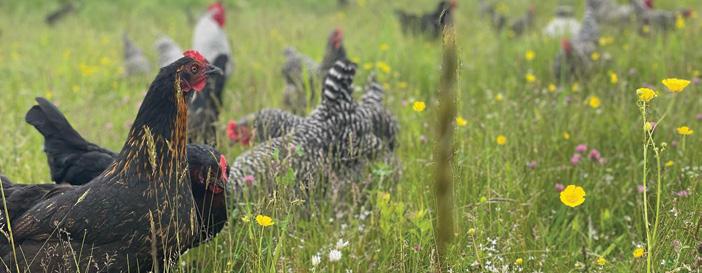
Peggy Rockefeller Farm Endowment Fund
Staff Supervisor: April Nugent, Farm Manager
Through the 2023 season, the Rockefeller Endowment supported the position of the Peggy Rockefeller Farm (PRF) Manager April Nugent, a new 10-month production assistant, and ongoing facilities operations. The farm continued to manage its other livestock enterprises at a slightly increased scale of production. Highlights included the expansion of the meat Community Supported Agriculture program available to residents of MDI and Hancock County. The expansion of production included a laying flock of approximately 150 organic hens yielding approximately 70 dozen eggs a week, 1,400 pounds of lamb, more than 1,600 pounds of pork, 2,000 pounds of organic chicken, and 1,200 pounds of beef. MHHEFA funds were used to renovate the old equipment barn at 660 Norway Drive into a functional cattle facility and dry hay storage barn. PRF continued to partner with The Howdy Houghton Memorial COA Community Food Pantry & Fridge to donate a variety of protein options to the campus community. The farms also recently began a partnership with alum-run local business Fogtown Brewing to utilize mash byproduct as feed for the swine on the farm. The farm’s animal breeding programs are expanding, particularly our flock of sheep. Animal breeding, on-farm educational opportunities, and community partnerships are expected to expand in future seasons.
The Peggy Rockefeller Farm (PRF) Endowment Fund was established in 2011 when David Rockefeller donated the Carmen and DeLaittre Farms to COA (which were combined to form the current PRF), along with a generous endowed gift to support farm operations.
Numerous students were able to engage via the work-study program, summer internships, farm workshops, class visits, and placed-based farm courses. In the fall term of 2023, April will teach an on-farm organic poultry practicum course. Several professors incorporated the farms in their classes this season, including students from the Human Ecology Coure Course, Ornithology, Bees and Society, Agroecology, Sheep to Shawl, and Sustainable Energy Community interactions have continued with numerous school groups and organizations engaging in educational farm tours to learn more about Peggy Rockefeller Farm and COA.
The 2023 COA Farm Day was hosted by PRF again this year and featured local music, tabling, farm tours, and a community dinner utilizing farm products.
$1,382,324
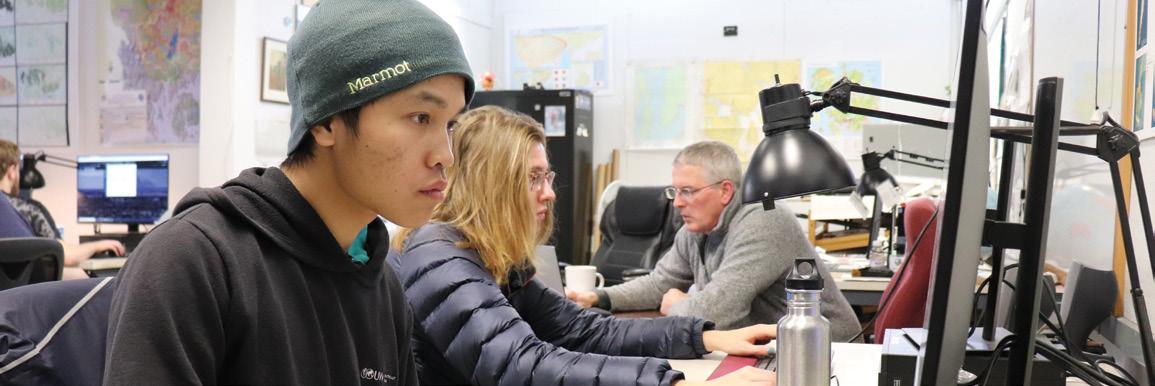
Doug Rose GIS Enhancement Fund
Staff Supervisor: Gordon Longsworth ’90, Director of the Geographical Information Systems (GIS) Lab
The Doug Rose Fund has continued to play a crucial role in advancing GIS in important ways. Here are some highlights of the fund’s contributions:
• Transfer of Mavic Mini drone to Earth Sciences: The fund facilitated the transfer of a Mavic Mini drone to the Earth Sciences department, enabling them to utilize it for mapping erosion of pathways on the College of the Atlantic main campus. This drone was also taken to México and used to map several agricultural study areas.
• Acquisition of Mavic Mini 3 drone: This drone features integrated video and apps. Unlike the previous setup that required students to use their personal phones to operate the drone, this new drone provides a self-contained solution, making it more accessible for students. Importantly, it weighs less than 250 grams and does not require special training or FAA certification. Students have been actively engaged in using drones for mapping and surveying on campus, on Great Duck Island, at the North Woods Ways property, and at the Cox Protectorate property.
Family and friends of Doug Rose established this fund in 1994. Doug, a COA student in the 1990s and avid climber, died climbing Great Head when the weather turned. This fund supports the purchase of software and equipment, as well as student attendance at conferences related to Geographic Information Systems.
• Pix4D.com subscription: Pix4D continues to be instrumental in processing and storing drone imagery. There
was cost sharing between GIS, and Earth and Marine Sciences of the yearly fee for the cloud service. An increasing number of students, some with their own drones, have been using Pix4D. Imagery can be directly integrated into ArcGIS for further analysis and visualization.
• IDrive.com subscription: The fund supported a subscription to IDrive.com, a cloud service for backing up and sharing critical data. This has ensured the safety and accessibility of the 30year history of the lab’s work, up to the current projects.
• Enhancing collaboration: The GIS Lab is not just a collection of individual workstations but also a space for collaboration and group projects. The fund was used to add a second couch to the GIS lounge area, making the lab a comfortable and inviting space for students to have conversations and share ideas about the work they are engaged in.
Overall, the Doug Rose Fund has played a vital role in advancing GIS technology and its applications in education and research. It has enabled students to engage in innovative projects and has created a collaborative environment for GIS enthusiasts at the lab.
6,679
Diana Davis Spencer Hatchery Fund
Faculty Supervisor: Jay Friedlander, Sharpe-McNally Chair in Green and Socially Responsible Business
COA’s venture incubator was endowed by a grant from the Diana Davis Spencer Foundation in 2015. The Diana Davis Spencer (DDS) Hatchery provides eligible students with academic credit, professional services, and access to seed funding to develop a sustainable for-profit or nonprofit business. While the vast majority of collegiate venture incubators and accelerators are cocurricular, forcing students to choose between their interests and education, the DDS Hatchery removes these barriers, aligning education and individual passion by providing students with a full term of academic credit. Sustainable Business Program Manager Kerri Sands ’02 and I manage the program, and have built a bespoke curriculum so any student at COA can develop their ideas and be fully immersed in the entrepreneurial experience.
Students selected for the DDS Hatchery:
• Perform a series of increasingly high-fidelity prototypes over 10 weeks
• Learn essential business skills necessary for success in any enterprise
• Receive guidance from mentors and professionals in prototyping, branding, social media, legal, and accounting
• Have access to office space and up to $5,000 in seed funding
For the 2022–23 academic year, it was a pleasure to have the DDS Hatchery class in person. We continued to make use of remote technology as students joined the class via Zoom while they traveled to France, Costa Rica, and around the United States to gather information for their ventures. Eight participants pursued seven enterprises reflecting the diverse interests of COA students. Many of the students had already been developing their ventures across a range of classes and years at COA. Enterprises included:
• Current Peak—storing solar energy to return it to the grid at peak times, smoothing demand and maximizing returns for solar providers
• Findi Sahel—boosting income for Nigerian women through Nigerian fair-trade tea made from West African plants and herbs
• Malek Hinnawi—visual storytelling with videos, photos, and graphic design that brings stories to life
• COA Second Chance Thrift—providing an on-campus thrift shop for gently used discarded resources
• Visionarios de Paz— educating Costa Rican youth and restoring the local ecosystem in Palmichal, Costa Rica
The Diana Davis Spencer Foundation endowed COA’s venture incubator in 2015. The Diana Davis Spencer Hatchery provides eligible students academic credit, professional services, and access to seed funding to develop a sustainable for-profit or nonprofit business.
• Detritus—sewing custom fit street wear for trans males
• SeaWise—processing sailing data into easy-to-use and informative tracking maps for racers, the press, and race organizers
DDS Hatchery students learned sustainable enterprise fundamentals, developed numerous prototypes, experimented with new products and sales channels, solicited meaningful feedback from customers, outlined operations plans, developed growth strategies, and ultimately came to see themselves as professionals offering products and services of value. At the end of the 10-week term, students, families, and supporters from around the world attended the live Hatchery Expo in person and over Zoom, where students presented overviews of their work.
The DDS Hatchery’s educational model continues to be of interest to organizations both inside and outside academia. I was interviewed and presented the Hatchery model at conferences, workshops, and meetings in the United States, Europe, and globally over Zoom. The program was highlighted for how it merges academic credit with students’ interests to elevate learning and provide entrepreneurs with the skills they need to succeed.
Thomas and Mary Hall Library Fund
This fund was established in 1986 with the purpose of helping Thorndike Library build a collection of science and history of science books. The fund grew further when Thomas Hall died in 1990, and the Hall family requested that donations made in his memory be directed to this fund. Each year, selections are made based on requests, class needs, and academic or general interests. This year’s selections include:
Running Out: In Search of Water on the High Plains by Lucas Bessire (2021)
Plagues Upon the Earth: Disease and the Course of Human History by Kyle Harper (2021)

Regeneration: Ending the Climate Crisis In One Generation by Paul Hawken (2021)
The Light Ages: The Surprising Story of Medieval Science by Seb Falk (2020)
Slime: A Natural History by Susanne Wedlich (2023)
The Milky Way: An Autobiography of Our Galaxy by Moiya McTier (2022)
Beyond Measure: The Hidden History of Measurement from Cubits to Quantum Constants by James Vincent (2023)
Fen, Bog and Swamp: A Short History of Peatland Destruction and Its Role in the Climate Crisis by Annie Proulx (2022)
Lakes: Their Birth, Life, and Death by John Richard Saylor (2022)
Salmon Wars: The Dark Underbelly of Our Favorite Fish by Catherine Collins and Douglas Frantz (2022)
Ancient Sea Reptiles: Plesiosaurs, Ichthyosaurs, Mosasaurs and More by Darren Naish (2023)
Determinants of Addiction: Neurobiological, Behavioral, Cognitive, and Sociocultural Factors by Justin R. Yates (2022)
Microbia: A Journey into the Unseen World Around You by Eugenia Bone (2018)
Composting for a New Generation: Latest Techniques for the Bin and Beyond by Michelle Balz and Anna Stockton (2017)
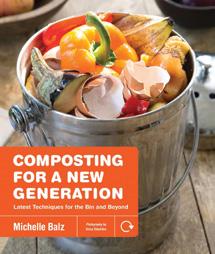
Why Sharks Matter: A Deep Dive with the World’s Most Misunderstood Predator by David Shiffman (2022)
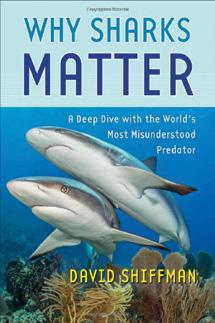
The Treeline: The Last Forest and the Future of Life on Earth by Ben Rawlence (2022)
The Ice Age by Jurgen Ehlers (2022)
The Song of the Cell: An Exploration of Medicine and the New Human by Siddhartha Mukherjee (2022)
Plant Genetic Conservation by Nigel Maxted, Danny Hunter and Rodomiro Ortiz Rios. (2020)
Mutualism by Judith L. Bronstein (2015)
Life Between the Tides by Adam Nicolism (2023)
A World Without Soil: The Past, Present, and Precarious Future of the Earth Beneath Our Feed by Jo Handelsman and Kayla Cohen (2021)
The Blue Revolution: Hunting, Harvesting, and Farming Seafood in the Information Age by Nicholas Sullivan (2022)
Otherlands: A Journey Through Earth’s Extinct Worlds by Thomas Halliday (2023)
Introducing Stratigraphy by Paul Lyle (2019)
First Steps: How Upright Walking Made Us Human by Jeremy DeSilva (2021)
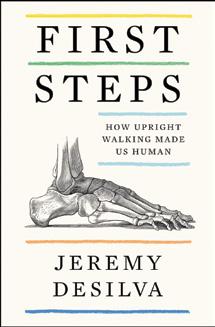
R. Amory Thorndike Memorial Fund
This fund was established in 1979 in memory of long-time supporter and friend, R. Amory Thorndike. College of the Atlantic’s library was subsequently named for Mr. Thorndike and his wife Elizabeth. The purpose of this fund is to strengthen and enlarge the college’s library collection materials in the fields of the arts and humanities. This year’s selections include:
A Theory of Adaptation by Linda Hutcheon (2012)
Algorithms of Oppression: How Search engines Reinforce Racism by Safiya Umoja Noble (2018)
Dawoud Bey & Carrie Mae Weems: In Dialogue by Ron Platt, Dawould Bet, et al. (2022)
Decolonial Ecology: Thinking from the Caribbean World by Malcom Ferdinand, Anthony Paul Smith, et al (2022)
Ecodeviance: (Soma)tics for the Future Wilderness by C.A. Conrad (2014)
Feelings are Facts: A Life by Yvonne Rainer (2013)
Fractured Identities: Changing Patterns of Inequality by Harriet Bradley (2015)
Hear Me Now: The Black Potters of Old Edgefield, South Carolina by Adrienne Spinozzi, Simone Leigh, et al. (2022)
I Am Because We are: Readings in Africana Philosophy by Fred Lee Hord and Jonathan Scott Lee (2016)
Indigenous Conflict Management Strategies: Global Perspectives by Akanmu G. Adebayo, Jesse J. Benjamin, et al. (2016)
Kehinde Wiley at the National Gallery: The Prelude by Christine Riding, Sarah Thomas, et al. (2022)
Medieval Islamic Philosophical Writings by Muhammad Ali Khalidi (2005)
Modern Fabric: TwentyFive Designers on Their Inspiration and Craft by Abby Gilchrist and Amelia Poole (2020)

Music is History by Questlove (2021)
Philip Guston Now by Philip Guston, Harry Cooper, et al. (2020)
Pluriversal Politics: The Real and the Possible by Arturo Escobar (2020)
Political Ecology: A Critical Introduction by Paul Robbins (2019)
Queer Threads: Crafting Identity and Community by John Chaich and Todd Oldham (2017)
Race and Modern Architecture: A Critical History from the Enlightenment to the Present by Irene cheng, Charles L. Davis II, et al. (2020)
Sea People: The Puzzle of Polynesia by Christina Thompson (2022)
Sound Art: Sound as a Medium of Art by Peter Weibel (2019)
The Decameron Project: 29 New Stories from the Pandemic by the New York Times (2020)
The Invention of Green Colonialism by Guillaume Blanc and Helen Morrison (2022)
The Moving Body: Teaching Creative Theatre by Jacques Lecoq, David Bradby, et al. (2020)
The Oxford Handbook of Philosophy and Race by Naomi Zack (2019)
The Seven Moons of Maali Almeida by Shehan Karunatillaka (2022)
The Trans Generation: How Trans Kids (and Their Parents) are Creating a Gender Revolution by Ann Travers (2019)
Wabanaki Modern : The Artistic Legacy of the 1060s “Micmac Indian Craftsmen” by Emma Hassencahl-Perley and John Leroux (2022)
Ways of Being by James Bridle (2023)
When the Light of the World Was Subdued, Our Songs Came Through: A Norton Anthology of Native Nations Poetry by LeAnne Howe, Jennifer Elise Foerster, et al. (2020)
When We Cease to Understand the World by Labatut Benjamin (2021)
TOTAL COMBINED FUNDING FOR THE THOMAS AND MARY HALL BOOK FUND AND THE R. AMORY THORNDIKE MEMORIAL FUND:
Elizabeth Thorndike Senior Class Book Fund
In 2001, Thorndike family members started a fund in honor of Betty Thorndike, for whom Thorndike library is partly named. Each year, this fund pays for the Thorndike “Senior Books,” which are selected by the graduating class for inclusion in the library’s collection. In 2015, the family made an additional contribution to the fund to support library resources. This year’s selections include:
The Circus of the Earth and the Air by Brooke Stevens
“Author Stevens, who worked as a tiger groom with the Ringling Brothers, and Barnum & Bailey circuses, has written an amazing first novel that strikes repeatedly at the core notion of the performer, the performance, and the unknown.”
—Eloise Kinney, Amazon
Drawing As a Way of Knowing in Art and Science by Gemma Anderson-Tempini
“Gemma Anderson’s Drawing as a Way of Knowing in Art and Science introduces tested ways in which drawing as a research practice can enhance morphological insight, specifically within the natural sciences, mathematics and art.”
—Bookshop
Narcissus and Goldmund by Hermann Hesse
“Hesse’s novel of two medieval men, one quietly content with his religion and monastic life, the other in fervent search of more worldly salvation. This conflict between flesh and spirit, between emotional and contemplative man, was a life study for Hesse.” —Bookshop
The Ethnic Project: Transforming Racial Fiction into Ethnic Factions by Vilna Bashi TreitleI
“In The Ethnic Project, Bashi Treitler considers the ethnic history of the United States from the arrival of the English in North America through to the present day. Tracing the
histories of immigrant and Indigenous groups…she shows how each negotiates America’s racial hierarchy…” —Bookshop
Mirrors In The Earth:
Reflections on Self-Healing from the Living World by Asia Suler
“Combining poetic nature writing with exercises and reflection prompts at the end of each essay, Mirrors in the Earth coaxes us to come as we are: to discover and tend the inherent brilliance and medicine that lives in each of us.” —Bookshop
A Short History of the World
According to Sheep by Sally Coulthard
“Sally Coulthard weaves this fascinating story into a vivid and colorful tapestry of engaging anecdotes and extraordinary ovine facts, whose multiple strands celebrate just how pivotal these wooly animals are to almost every aspect of human society and culture.” —Amazon
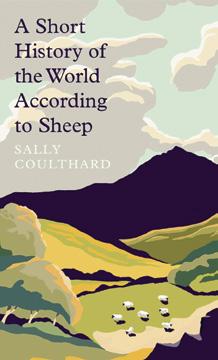
Mother Courage and Her Children by Betrolt Brecht
“Set in the seventeenth century, the play follows Anna Fierling (“Mother Courage”), an itinerant trader, as she pulls her wagon of wares and her children through the blood and carnage of Europe’s religious wars.” —Bookshop
This Place That Place by Nandita Dinesh
“This Place That Place is an evocative debut that functions as a bold allegory for militarized occupations anywhere. As much a visual read as it is a literary one, this brilliant literary debut provides new ways to think about the intersections between the personal and the political; between occupier and occupied…” —Amazon
Embracing Light: A Year in Acadia National Park & Mount Desert Island by Scott Erskine
“The work in this book represents a very personal and deep-felt intimacy with the park and the island that can evolve only by completely immersing oneself into the rhythm and flow of the land and sea, and
then using all of his craft to express this deep love, his soul, that belongs to Acadia.”
—Bookshop
Herbal Healing For Women by Rosemary Gladstar
“Comprehensive and easyto-use, Herbal Healing for Women explains how to create remedies—including teas, tinctures, salves, and ointments—for the common disorders that arise in the different cycles of a woman’s life.” —Bookshop
Black Marks on the White Page edited by Witi Ihimaera and Tima Makereti
“Here are the glorious, painful, sharp and funny 21st century stories of Maori and Pasifika writers from all over the world. Vibrant, provocative and aesthetically exciting, these stories expand our sense of what is possible in Indigenous Oceanic writing.” —Amazon

Waterfront Director Fund
Staff Supervisor: Toby Stephenson ’98, Waterfront Director
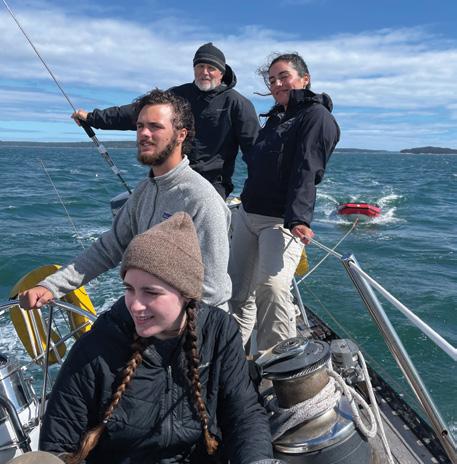
FALL 2022
Between 30–40 students sailed, or learned to sail, and numerous students learned to operate our small powerboats for safety watch. S/V Rebecca, our 46-foot sloop, took students out more than a dozen times, and the smaller sailboats worked regularly for our growing sailing program. I continue to appreciate the joy our students get from sailing Frenchman Bay.
M/V Osprey returned from Wesmac at the end of October (the repair process outlasted her entire construction process by three months!). This was a huge disappointment, but she ran beautifully when she was finally launched. The renovation following her mooring failure at the Bar Harbor waterfront was comprehensive and her hull looks as good as it did when she first launched in 2012. Excluding a small deductible, the nearly $350,000 repair was covered by insurance. We are now keeping Osprey and Rebecca at Abel’s boatyard for winter storage.
We accepted a 30-foot Etchells sailboat as a donation in December 2022 that will sail in the fall of 2023 and 2024 before putting her on the market. Her value was put at $44,000, though she will likely sell for less than that.
SPRING 2023
Osprey launched in late April. Improvements were made to her hydraulic system and the WASSP multibeam transducer and
hardware were installed permanently. The transducer was installed into the keel, a differential GPS antennae was added to our mast, and the required computers, heading sensors, and data splitters were installed in our electronics closet to allow for seamless transitions into mapping operations. We are now awaiting the Timezero Professional software pledged by our Nobeltec representative.
An anonymous donor established this endowed fund with a gift of $1.25 million during the Broad Reach Capital Campaign to maximize the educational potential of our offshore islands— Mount Desert Rock and Great Duck Island—and the coast itself. The gift endowed our waterfront director’s position, allowing the college to improve access to the Gulf of Maine and enable more faculty members, students, and visitors to use these remarkable assets to their full potential.
A proposed renovation for the Davis Garage that I initially presented at Campus Planning and Building Committee (CPBC) in 2021 passed through CPBC this May, and the construction process began shortly thereafter. The garage will be insulated, roofed, and heated, and attached storage sheds will be created to allow for year-round use of the interior of the building. An 18'x35' shed will be installed on the front of the garage for our numerous inflatable boats, and a 16' shed will be installed along the entire back for bulky gear storage, and drying tents and other camping gear. Until now, this equipment was stored inside the building over the winter, rendering the space impossible to use for other purposes. The renovation will facilitate a year-round workspace for students to engage in boat—and similar—projects downstairs, and Student Life trip planning and outdoor gear storage upstairs. In addition to the garage renovation, we will erect a canoe and kayak pole-barn just to the west of the garage in 2024 to keep all our lake and river boats out of the elements. This project is funded through the Maine Health and Higher Education Facilities Authority.
$1,421,409
Sailing Blue Hill Bay
Writing for the Future Fund
Teaching Staff Supervisor: Blake Cass, MPhil ’19
Karen Waldron served as interim director of the Writing Program during the 2022–23 academic year, as the search process for the new director was underway. Karen oversaw professors teaching courses that met the writing requirement and, with the help of Palak Taneja, tweaked the recommendation process for first-year writing courses; instead of using college application materials to assess the writing skills of students, the Writing Program solicited feedback from Human Ecology Core Course teachers, an approach which gave us accurate information about student writing abilities and interests. Karen also supervised Blake Cass MPhil ’19, who served as acting writing center director.
Having made changes to our hiring practices in the previous spring, the writing center kicked off the year by welcoming 13 new tutors. This demographically diverse cohort consisted completely of returning students with significant college writing experience.
Former COA Trustee
Walter Robinson contributed the lead gift in 2018 during the Broad Reach Capital Campaign to establish this endowed fund, which provides faculty support in composition and technical writing, expands COA’s writing tutor program, and institutes new methods of communication to ensure COA students are prepared for today’s labor market.
The writing center replaced the year-long tutoring training program that consisted of two courses— Methods of Teaching Writing Across the Curriculum and Advanced Composition —with the new intensive Methods of Tutoring Writing, a one-term course focused on writing center research and theory. The new training program was designed to enable a more active learning methodology that stressed tutoring strategies aimed at promoting autonomy and self-corrections through collaborative learning.
To accomplish its many goals for the year and ensure that tutors had a say in the direction of the writing center, tutors broke up into four committees: a committee for promoting the writing center on campus; a committee for making and collecting external resources for students, faculty, and staff; a committee for making and collecting internal resources for tutors; and a library committee that worked with library work-study students to research potential library and writing center collaboration.
The hard work of the promotion committee deserves particular mention. Among its many initiatives, the committee hosted several
successful events designed to encourage students to visit the writing center. In the winter term, the committee hosted a social night that included a display of language diversity, fun writing activities (such as a black-out poetry station), snacks, and plenty of tutors on hand to talk with students. At the start of the spring term, the committee put on a word game night that allowed students to engage with tutors and the center in a non-stressful way. And the committee wrapped up the year by hosting two senior project writing panels, events that promoted and celebrated the breadth of writing at COA.

The writing center began experimenting with tutoring in different physical spaces, such as tutoring in the library, the Blair Dining Hall, and outside in various locations to be more accessible to students and to better advertise the writing center to students on campus.
The second annual Anne Kozak Bread and Butter Tutoring Award was awarded to two tutors: Alejandra Morales Torres ’23, for her advocacy for multilingual students and her work designing a more inclusive writing tutor training course; and Silas Sifton ’23, for the work he put into designing a training curriculum on note taking and his ongoing commitment to working with neurodivergent students.

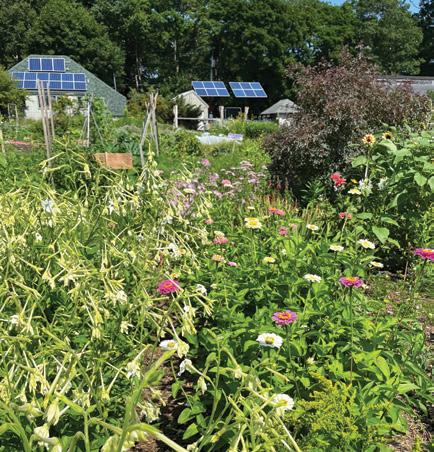
Physical Plant Funds
ETHEL H. BLUM GALLERY
The Ethel H. Blum Gallery was dedicated in 1993 to Ethel H. Blum (1900–1991), an accomplished watercolorist who studied at the Art Students League and the Brooklyn Museum Art School, and exhibited widely in her lifetime. A longtime summer resident of MDI, she took special pleasure in painting Maine coast views.
This fund supports campus grounds improvements and was created by founding trustees Les Brewer and Father James Gower, as well as local businessmen Charles Sawyer and Michael J. Garber.
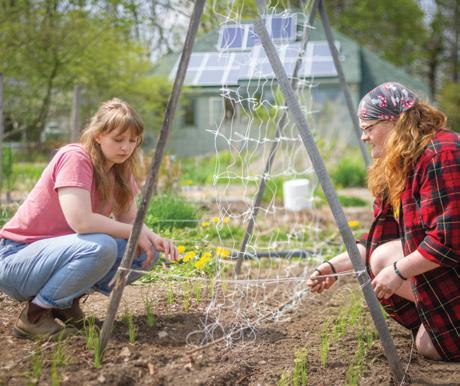
KATHRYN W. DAVIS CENTER BUILDING AND GROUNDS FUND
Created by gifts from the Shelby Cullom Davis Foundation in support of the maintenance and upkeep of the Davis Center and grounds.
The Kathryn W. Davis Center for International & Regional Studies is currently used for faculty and staff offices, classes, and a meeting place for COA’s international population. The Davis Carriage House is a rustic addition to student housing. The Kathryn W. Davis Residence Village is the newest and greenest housing complex.

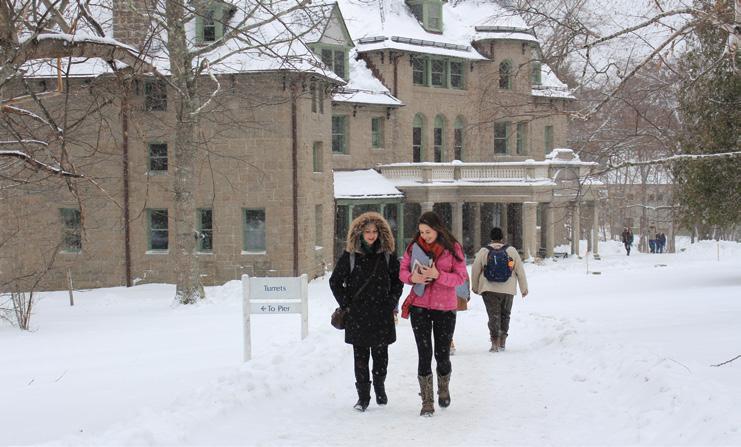
THOMAS S. GATES, JR. COMMUNITY CENTER
Gates is regularly used for lectures, theatrical productions, music and dance performances, and large meetings or workshops. The hall has a stage with optional podium, seating on the main floor and balcony, a lighting and sound booth, and digital projector with screen.
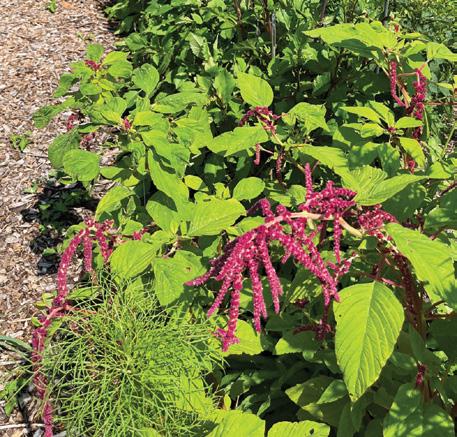
THORNDIKE LIBRARY/KAELBER HALL
Thorndike Library was named in honor of Robert Amory Thorndike (1900–1972) and his wife Elizabeth (1908–1992) in recognition of their support and contributions to COA. Kaelber Hall, named for founding president Ed Kaelber, is the large natural-shingled building located in the center of campus. It overlooks the water, and houses the Thorndike Library, the Blair Dining Hall (Take-A-Break) and kitchen, and the Admission Office.
THE TURRETS
The Turrets was designed for John J. Emery of New York in 1893 by Bruce Price, designer of Québec’s famous Château Frontenac. In 1975, it was placed on the National Register of Historic Places, and is still one of the most important examples of cottage-era architecture in Maine. The Turrets currently houses classrooms and administrative and faculty offices.
FY23 SUPPORTERS
PRESIDENT’S CIRCLE
$25,000+
Anonymous (6)
Nancy & Edgar Aronson
Estate of Donald Russell Bailey
Anne T. & Robert M. Bass
Antoinette & Benjamin Brewster
Gale & Shelby Davis
Kate & Andrew Davis
Heather Richards Evans
Rena Zurn & Spencer Fulweiler, Jr.
Beth & Will Gardiner
Amy & Phil Geier
Anne & Jim Green
Sam Hamill, Jr.
Sarah & Jason Ingle
Meredith & Dane Jensen
Tabitha & Stephen King
Arlene & Bob Kogod
Gardiner & Nicholas Lapham
Scott MacKenzie & Jerry Cruz
Jacomien Mars
Jay McNally ’84
David G. Milliken
Rebecca & Steve Milliken
Abby Moffat
Louisa & Bill Newlin
Judith S. Perkins
Daniel Pierce, Jr. Family
Hope Putnam
Family of Kate Davis Quesada
Lalage & Steve Rales
Emily & Mitch Rales
Diana & Roland Reynolds
Walter M. Robinson III
Lucy Bell Sellers
Robert Shannon*/ The Fourth Corner Foundation
Peggy Sharpe
Diana Davis Spencer
Maureen & Bill Stewart
Anne & Charles Target
Genie & Will Thorndike, Jr.
Claudia & Carey Turnbull
Carol Weg
FOUNDER
$10,000-24,999
Becky Bartovics
Mia & Timothy Bass
Joanie & Jamie Blaine
Elisabeth & John Cochran
Mary K. Eliot
Wendy & Bill Foulke, Jr.
Rena Zurn & Spencer Fulweiler, Jr.
Wendy C. Gamble
Christina M. Gillis
Steffi & Bob Harris
Sonja Johanson ’95 & Richard Gordet
Casey Mallinckrodt
Rachel & Tom Maniatis
Anne & Tony Mazlish
Nell Newman ’87
Bill O’Donnell
Cathy Orme
Susie & Bob Peck
Bruce Phillips ’78 & Susan Erickson
Catherine Baker-Pitts & Will Pitts III
Kathy & George Putnam III
YEAR AFTER YEAR
40+ YEARS
Bar Harbor Bank & Trust
Barbara B. & Charles P. Burton II
Lucy Bell Sellers
35–39 YEARS
Helen Caivano ’80
Sarah Corson & Dick Atlee
First National Bank
Nina ’78 & Jonathan ’78 Gormley
Katherine Hazard ’76
Kass Hogan ’81
Betsey Holtzmann & Abe Noyes
Cathy Johnson ’74
Laura & Michael Kaiser ’85
Betsy & John Kelly
Arlene & Bob Kogod
Margaret & Philip B. Kunhardt III ’77
Phyllis Anina Moriarty
Meta & Benjie Neilson
Louisa & Bill Newlin
Linda & Eliot Paine
Bambi Putnam
Roxana & Tony Robinson, Jr.
Martie & Ed Samek
Cynthia E. Livingston & Hank L.P. Schmelzer
Jamie S. Somes
Maureen & Bill Stewart
Allison & Steve Sullens
Nonie & John Sullivan, Jr.
Anne & Charles Target
Christiaan van Heerden’09 & Family
Suzanne & David Wakefield
Kim & Finn Wentworth, Jr.
PATHFINDER
$5,000-9,999
Anonymous (1)
Cynthia Baker & Jonathan Zeitler
Sandi Read & Ron Beard
Jeannie & Henry Becton, Jr.
Elizabeth Hodder Corbus & Clay Corbus
Sydney Davis
Peggy Dulany
Laura Ellis
Deb Evans ’82 & Ron Schaaf
Chandler & Oliver Evans
Carolyn & Chris Groobey
Charlotte Hanson
Lissa & Mel* Hodder
Lynn & Jeff Horowitz
Ali & Steve Kassels
Linda & Philip Lader
Sydie Lansing
Pamy Manice
Cathy L. Ramsdell ’78
John Reeves*
Ellen Seh (’75)
John Viele (’81)
Ben Walters ’81
Katherine Weinstock ’81
30–34 YEARS
Anonymous (3)
Anne T. & Robert M. Bass
John Biderman ’77
Donna Gold & Bill Carpenter
Liz & Arthur Martinez
Anna Maynard
Linda & Clem McGillicuddy
Betsy & Nelson Mead, Jr.
Heather & George Mitchell
Carol ’93 & Jacob ’93 Null
Chaz O’Brien ’93 & Harrison Bains
Linda & Eliot Paine
Frances Pollitt ’77 & Frank E. Briber III
Anne & Bruce Pomeroy
Susan & David Rockefeller, Jr.
Amy Falls & Hartley Rogers
Ellen Seh (’75)
Jeri Presser & Charlie Seitz III
Margie & John Grace Shethar
Joss Tennille
Christopher Toomey
John Wilmerding
Alice Blum Yoakum
DISCOVERER
$2,500-4,999
Mary Dohna ’80 & Wells Bacon ’80
Margaret Vettese & Edward Benz, Jr.
Deirdre Swords & Michael Boland ’94
Allison & Avery Bourke III
Jean & Ordway Burden
Susanna Porter & Jamie Clark, Jr.
Ruth M. Colket
Karen & Darron Collins ’92
Sally Crock
Verena & Rod* Cushman
Adam Dau ’01
Beth Rendeiro & Steven DePaul
Sally Crock
Verena & Rod* Cushman
Lisa Damtoft ’79
Norah Davis
Cynthia Jordan Fisher ’80
Wendy & Bill Foulke, Jr.
Barbara & Dick Fox
Susan Freed ’80
Jackson Gillman ’78
Neva Goodwin
Diana & George Hambleton
Kate Russell Henry & Eric Henry (’74)
Lissa & Mel* Hodder
Sue Inches ’79
Susan Lerner & Steven Katona S. Lee Kohrman
Anne Kozak
Bill McDowell ’80
Suzanne Durrell & Scott McIsaac (’78)
Jay McNally ’84
Bruce Phillips ’78 & Susan Erickson
Susan & David Rockefeller, Jr.
Hilda K. Roderick
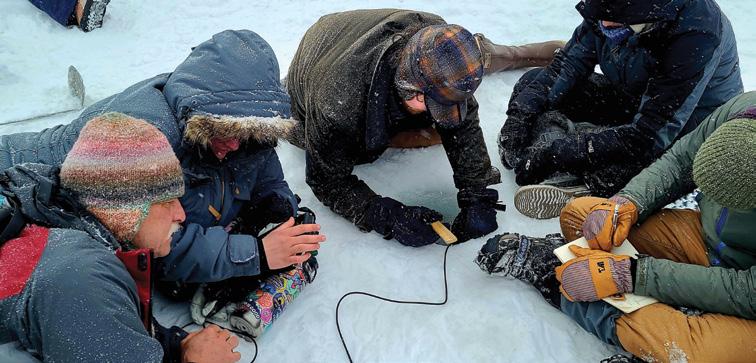
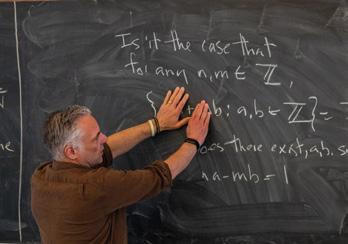
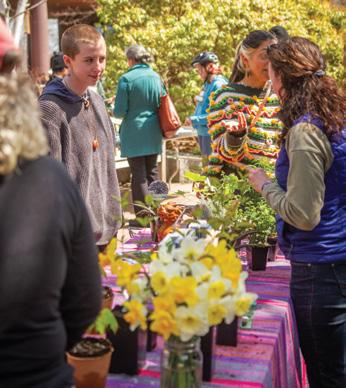
The Champlain Society was established in 1988 to honor College of the Atlantic’s most generous annual donors. The support of Champlain Society members is critical to advancing the college’s mission, ensuring academic excellence, providing financial aid, and enhancing COA’s campus, island research stations, farms, and other learning environments.
For more information on becoming a member of the Champlain Society, please contact Shawn Keeley at 207-801-5620, or visit coa.edu/tcs.
Ellen & Bill Dohmen
Donna & Bill Eacho III
John Goodman
Neva Goodwin
Carol & Dick Habermann
Cookie & Bill Horner
Peter Hunt & Family
Leslie Jones ’91
Arthur Keller & Mark Gauthier
Maggie & Jack Kelley III
Karen & Howard Lapsley
Linzee Weld & Peter Milliken (’76)
Nancy Milliken
Irene Driscoll & Lincoln Millstein
Phyllis Anina Moriarty
Meta & Benjie Neilson
Julia & Brooke Parish
Tina Rathborne
John Reeves*
Jared I. Roberts
Allison Fundis ’03 & Stein Servick ’05
Carol Dean Silverman & Family
Sandy Stone
Mary Kay Long & Dennis Unites
Kathy Vignos
Paddy Wade
Katherine Weinstock ’81
Lisa & Paul Welch
J. Michael Williamson
Christine Witham
Erin ’04 & Mike ’01 Zwirko
EXPLORER
$1,500-2,499
Anonymous (9)
Julie Banzhaf-Stone & Steve Stone
Barbara Tennent & Steven Barkan
Emily Beck & Geof Young
Ann & Fred Benson
Lynn Boulger & Tim Garrity
Sharon & Bruce Bradley
Patricia & Ronnie Rogers
Beverly & Max Rothal
Barbara Sassaman ’78
Peggy Sharpe
Dorie Stolley ’88
Elena Tuhy-Walters ’90 & Carl Walters II
Paddy Wade
John Wilmerding
Janey Winchell ’82 & Timothy Mangini
Sue Woehrlin ’80
Alice Blum Yoakum
25–29 YEARS
Anonymous (4)
Murray Abramsky
Mary Dohna ’80 & Wells Bacon ’80
Bruce Bender ’76
Edith Blomberg
Katherine Kaufel Christoffel
Ruth M. Colket
Marcia L. Dworak
David Emerson ’81
Julie Erb ’83
Carroll & Tom Fernald
Garden Club of Mount Desert
Katie & Steve George
June LaCombe (’75) & Bill Ginn ’74
Abigail Goodyear ’81 & John Allgood
Peggy & Mike Gumpert
Sam Hamill, Jr. Loie Hayes ’79
Mary J. Heffernon
Barbara Hilli
Lisa ’80 & Bob ’79 Holley
Cookie & Bill Horner
Lyn Hurwich ’80
Anna Hurwitz ’84
Maggie & Jack Kelley III
Craig Kesselheim ’76
Steve King ’80
Joan & Ted Koffman
Rosalind Rolland & Scott Kraus ’77
Jennifer Starr & Eugene Lesser ’78
Maine Coast Sea Vegetables
Casey Mallinckrodt
Carol Manahan ’77
Sarah McDaniel ’93
Donna McFarland & Alan Richins
Linda & Clem McGillicuddy
Clifton McPherson III ’84
Jane & Bob Meade
Jeffrey Miller ’92
Linzee Weld & Peter Milliken (’76)
Karla Tegzes & Peter Moon ’90
Hope Olmstead
Brenda Brodie
Bing & Nat Brown
Amanda (Walker) Bunker ’98
Jane & Charles Burger
Thomas D. Cahill III
Sheila Cusack & Gerard Caron
Mary Ann & Harry Charlston
Gail & Ham Clark III
Pancho Cole ’81
Tracy & Gifford Combs/ Combs Family Fund
Stefan Cushman
Kerri & Rodger Dowdell III
Cindy & Phil Eichenholz
Deborah Ellwood
Ben Emory
Peg Emple
Jean & David Evans
Dolly & John Fisher
Susan Getze
June LaCombe (’75) & Bill Ginn ’74
Diana & George Hambleton
Louise Hartwell
Caitlyn Harvey ’02
Ayn & Steve Hunt
Sue Inches ’79
Yardly & Scott Jenkins
Peggy Schultz & Fred Jones
Susan Lerner & Steven Katona
Betsy & John Kelly
Susan & John Klein
Denise Garone & Stuart Kogod
Margaret & Philip B. Kunhardt III ’77
Nancy Erikson Ladd & Sam Ladd III
Burks B. Lapham
Courtney Lederer & Mark Thierfelder
Babette & Peter Loring
Carol & Rick Malone
Judy McGeorge
Suzanne Durrell & Scott McIsaac (’78)
Anne & John Milliken
Daphne Milliken
Deb & Bob Milotte, Jr.
Meredith & Phil Moriarty
Rob Whitman & Jeff Munger
Kathryn & Tom Nelson
Alice Shin & Mark Norris
Carey Pickard III & Christopher Howard
Laura & Vassar Pierce, Jr.
Barbara & Charles Pierce, Jr.
Lisa & Jay Pierrepont
Marguerite Pitts
Sheila Sonne Pulling
Celian Putnam
Susie Rodriguez & Charles Lowrey
Nadia Rosenthal & Alan Sawyer
Harrison Royce Architecture Corp
Sandy Wilcox & Jack Russell
Katie Adams Schaeffer & Anthony Schaeffer
Frances Stead Seller & Tim Sellers
Jane & Dennis Shubert
Julie Spahr
Caren Sturges
Ingrid Sunzenauer
Virginia Sweatt
Laura Stanton & Kim Tomlinson
Daphne & Andrew Trotter
Luciana Pandolfi ’98 & Luke Wagner ’99
Helen & Paul Weaver
Sydney & Jonathan Winthrop
Margaret Woolley & Gerard Vasisko
$100-1,499
Anonymous (36)
Jane & Abass Alavi
Sharon Knopp & Enoch Albert
Eben Albert ’03
Heather Albert-Knopp ’99
Bernie Alie ’84
Susan & Robert Pennington
Judith S. Perkins
Daniel Pierce, Jr. Family
Frances Pollitt ’77 & Frank E. Briber III
Dan Sangeap ’90
Dorothy & Roland Seymour
Jane & Dennis Shubert
Lynne & Mike Staggs ’96
Alisa Nye ’15 & Davis Taylor
Jo Todrank ’76 & Giora Heth
Karen Waldron & Richard Hilliard
Betsy Wisch ’83
Loretta & Tom Witt
20–24 YEARS Anonymous (3)
Heather Albert-Knopp ’99
Bernie Alie ’84
Irene S. Alie
Judy Allen
Lelania Prior Avila ’92 & Family
Elizabeth Rousek Ayers ’95
Jeffrey Baker ’77
Judy Allen
Diane & Alan Amendt
Heather & Richard Ames
Elizabeth Anderson
Elly & Sandy Andrews III
Sally & Bill Arata
Emily Argo ’10
Shlomit Auciello ’17
Elizabeth Rousek Ayers ’95
Cathy Bacon
Aminda & John Baird
Judy Baker
Jeffrey Baker ’77
Natalie Barnett ’11
Cheryl Bartholomew ’80
Jean Beckley
Bruce Becque ’81
Felicia Bellows
Robin’80 & Paul ’79 Beltramini
Sara Bender & Evan Bender ’04
Bruce Bender ’76
Ann Berenfield
Glen Berkowitz ’82
Marie & Gerald Berlin
Robert Hunt Berry
Sara Faull ’98 & Eugenio Bertin ’97
Deodonne’06 & Ranjan ’04 Bhattarai
Anne Oldach & William Bickley
John Biderman ’77
Janet Biondi ’81
Lisa Bjerke ’13, MPhil ’16
Michael Blair ’95
Debi & Art Blank
Edith Blomberg
Luke and Sophie Willis
Paul Boothby ’88
Patricia Honea-Fleming & Richard Borden
Laurent Bouveret
Kristin & Bryan Bradley
Barbara Tennent & Steven Barkan
Sandi Read & Ron Beard
Bruce Becque ’81
Glen Berkowitz ’82
Deirdre Swords & Michael Boland ’94
Paul Boothby ’88
Teisha A.W. Broetzman ’88
Cynthia Chisholm ’86
Katherine Clark ’91
Jen Hughes & Ken Cline
Pancho Cole ’81
Alyce & John Brady
Ellen Brandt
Laurie Brewer ’96
Jill K. Briggs
Ellen & Hank Brokaw
Lydia ’05 & Foy Brown
Alice & David Bullwinkle
Judith Burger-Gossart
Lisa Burton ’83 & Christopher Vincenty (’83)
Barbara B. & Charles P. Burton II
Helen Caivano ’80
William Luther ’06 & Seth Carbonneau ’05
JoAnne Carpenter & Jan Hofstra
Donna Gold & Bill Carpenter
Liza F. Carter (’78)
Melinda ’00 & Ellen Casey-Magleby
Erin Chalmers ’00
Lucy Hull & E. Barton Chapin III
Diana Choksey ’05 & Jordan Mandel-Iaia
Katherine Kaufel Christoffel
Alyne & Joseph Cistone
Sheila W. Clark
Caren Clark
Jen Hughes & Ken Cline
Lillian & Arthur Clinger, Jr.
Janis Coates
Pamela Cobb Heuberger ’83
Millard Coffin
Eddie & Clarke* Coggeshall
Laura Cohn ’88
Diana Cohn ’85 & Craig Merrilees
Sarah Colletti ’10 & Kyle McMillan
Leza & Jim Colquhoun
Heidi Conner
Harriet Corbett
Margaret & Jay Costan
Kelly McEwen & Quentin Cote
Edith Rodrigue & Mel Cote Jr.
Adam Cote
Karen & Darron Collins ’92
John Dandy (’84)
Lucinda & Fred (’75) Davis
Rose (’88) & Steve ’80 Demers
Holly Devaul ’84
Kelly MPhil ’97 & George Dickson
Millard Dority
Donna & Bill Eacho III
Mary K. Eliot
Carol Emmons
Ben Emory
Joan Feely ’79
Thomas Fisher ’77 & Tonya Ridings
Glenon ’86 & Gary Friedmann
Galyn’s Galley
Beth & Will Gardiner
Megan Godfrey ’77
Marie & John* Gower
Bo Greene
Linda Gregory ’89
Mary (Nelson) Griffin ’97
Matt Hare ’84
Roberta Coulter
Jill ’83 & Ben ’84 Cowie-Haskell
Brett Cramp
Marily Crews
Tom Crikelair
Elizabeth Cunningham ’82
Anne Czechanski Kneeland ’06
Lisa Damtoft ’79
John Dandy (’84)
Kara ’96 & Matt ’98 Daul, and Family
Norah Davis
Nancy Davis
Lucinda & Fred (’75) Davis
Caleb Fuller Davis ’02
Nicole d’Avis ’02 & Mark Anderson
Nisha & John Dawson
Bob DeForrest ’94
Rose (’88) & Steve ’80 Demers
Megan Smith ’90 & Daniel DenDanto ’91
Robert DeSimone
Danyelle Desjardins
Cerissa Desrosiers ’00 & Jessica Hannon
Holly Devaul ’84
Catherine Devlin ’93
Kelly MPhil ’97 & George Dickson
Judith Dickson
Pat & Bill Dommermuth
Millard Dority
Yvonne Leicht & Cameron Douglas
Cameron Hale Douglass ’02
Wendy & Michael Downey
Margaret & Stephen Downing
Priscilla du Pont
Jennifer Dussault ’02
Marcia L. Dworak
Mary Eaton Fairfield
Martha & Ned Edmonds
David Emerson ’81
Peter W. Emmet ’92
Carol Emmons
Kathleen & Maximillian Ernst
Diana Escobedo Lastiri ’09
Nickilynn Estologa ’07
Casey Jones & Bill Faller
Dan Falt
Joan Feely ’79
Sugar & Nat Fenton
Carroll & Tom Fernald
Adrian Fernandez ’15
Robert Finn ’92
Grahme Fischer
Thomas Fisher ’77 & Tonya Ridings
Helen Dickey Fitz & David G. Fitz /
Helen Dickey and David G. Fitz
Charitable Fund
Elsie Flemings ’06 & Richard Cleary
Judi & Howard Fogt
Joanne Rodgers Foster ’85
Barbara & Dick Fox
Susan Freed ’80
Bruce Friedman ’82
Glenon ’86 & Gary Friedmann
Mindi Friedwald ’99
Nina Frusztajer
Joanne & Richard Fuerst
Linda Fuller & Jeffrey Seeley
Bernard Fuller
Helen Geils
Katie & Steve George
Carley & Michael Gillott
Annika Maia Ginsberg ’99
Maroulla Gleaton
Emily & Evan Gnam
Erin ’92 & Graham ’91 Goff
Karen & Mark Goldberg
Nina Goldman & Douglas Legg
Jaki Erdoes ’80 & Terry Good ’80
Paul Goodof
Nina ’78 & Jonathan ’78 Gormley
Marie & John* Gower
YEAR AFTER YEAR
Atsuko Watabe ’93 & Bruce Hazam ’92
Peter Heller ’85
Margaret Hoffman ’97
Jane Hultberg
Peter Hunt & Family
Missy & Bill Janes (‘71)
Peter ’84 & Margaret Jeffery
Leslie Jones ’91
Burks B. Lapham
Marjorie Lau ’81
Jessie Greenbaum ’89 & Phil Lichtenstein ’92
Abigail Littlefield ’83
Amy Young & David Malakoff ’86
Donald K. McNeil
Rebecca & Steve Milliken
Olin Eugene Myers Jr. (’80)
Lynn & William Osborn
Suzanne & Jim Owen
Holly & Ken Paul Shoshana Perry ’83 &
Hale Powell
Helen Hess & Chris Petersen
Susan Pierce ’77
Sandra Graham
Jane Gray
Bo Greene
Gina Greer
Linda Gregory ’89
Mary (Nelson) Griffin ’97
Marie Griffith & Leigh Schmidt
Susan Dowling & Andrew Griffiths
Peggy & Mike Gumpert
Kath & Kirk Hachigian
David Hahn (’83)
Heather Hallett-Thurston & Mark Hallett
Irene Haisma & Jaap Ham
Mary Harney ’96
Jason Harrington ’96
Kelly Harris ’12
Patricia & John* Hatton
Jocelyn Hayes
Ed Haynsworth III ’98
Katherine Hazard ’76
Matthew Hecht & Mary Olson
Mary J. Heffernon
Peter Heller ’85
Kate Russell Henry & Eric Henry (’74)
Ingrid & Ken Hill
Barbara Hilli
Juliet Hodge ’95
Deborah & Roger Hodge
Anne Wright Hodge & Byron Hodge
Noah Hodgetts ’10
Juan Hoffmaister ’07
Margaret Hoffman ’97
Kass Hogan ’81
Eduarta ’05 & Matt Holl
Nancy Holler
Lisa ’80 & Bob ’79 Holley
Betsey Holtzmann & Abe Noyes
Lothar Holzke ’16
Donna & David Hreniuk
Nora Gibson & William Hudson
Michael Hueter ’14
Jane Hultberg
Lyn Hurwich ’80
Anna Hurwitz ’84
Tomoko & Masanobu Ikemiya
William Jackson
Toini Jaffe
Shelley Latham & Kenton Jakub
Nishad Jayasundara ’05
Peter ’84 & Margaret Jeffery
Jasmine Smith ’09 & Nick Jenei ’09
Patricia A. Jennings (‘71)
Cathy Johnson ’74
Louise Johnston
Christopher Jonas
Brianne ’02 & Brian Jordan
Jennifer Judd-McGee (’92)
Laura & Michael Kaiser ’85
Susan Kales & Scott Lawliss
Nancy & Bucky Kales
Sarah ’05 & Shawn ’00 Keeley
Joan & Jeff Kellam
Nan & Stephen Kennedy
Craig Kesselheim ’76
Barbara & Steven Kiel
Joan & Allan Kleinman
Greg Koehlert ’96
Joan and Ted Koffman
S. Lee Kohrman
Anne Kozak
Paula & Alexander Koziol
Rosalind Rolland & Scott Kraus ’77
Natasha Krell ’16
Susan & Keith Kroeger
Anna Krstevski ’05 & Alexander Krstevski ’07
Sandy & Mark Kryder
Philip Bradish Kunhardt IV ’11 & Maria Laura Torre Gomez
Maude Kusserow ’15
Jude Lamb ’00
Shiva Polefka ’01
Nishi Rajakaruna ’94
Tina Rathborne
Roxana & Tony Robinson, Jr.
CedarBough T. Saeji ’93
Cynthia E. Livingston & Hank L.P. Schmelzer
Sam Shaw
Maureen & Bill Stewart
Marie Stivers
Ellen Thurman
J. Louise Tremblay ’91
Frank Twohill ’79
Wendy Van Dyke (’80)
Christiaan van Heerden ’09 & Family
Peter Wayne ’83
Joplin Wistar ’84
15–19 YEARS
Anonymous (4)
Elly & Sandy Andrews III
Genevieve Soloway Angle ’00
Susan George Lyons Applegate ’76
D. Gay Atkinson II
Bar Harbor Whale Watch Co.
Robin ’80 & Paul ’79 Beltramini
Janet Biondi ’81
Patricia Honea-Fleming & Richard Borden
Lynn Boulger & Tim Garrity
Amanda (Walker) Bunker ’98
Judith Burger-Gossart
Lisa Burton ’83 & Christopher Vincenty (’83)
Barbara Carter
Rebecca & Michael Lambert
Virginie Lavallee-Picard ’07 & Alexander Fletcher ’07
David Lebwohl
Jacquelyn & Dawn Lemoine
Jennifer Starr & Eugene Lesser ’78
Otti & Jeffrey Levine
Monty Lewis
Linda & Jonathan Lewis
Jessie Greenbaum ’89 & Phil Lichtenstein ’92
Bobbi & Werner Liepolt
Axel Lischke
Abigail Littlefield ’83
Nancy Sullivan-Lord & Dan Lord
Caroline Pryor & David MacDonald
Kate & Ben Macko ’01
Christina Maguire
Amy Young & David Malakoff ’86
Carol Manahan ’77
Christine Manzey
Maude & John March, Jr. ’76
Chloe Marr-Fuller ’00
Angela Hondros-McCarthy & Dennis McCarthy
Bill McDowell ’80
Donna McFarland & Alan Richins
Kathleen McGraw
Nina & Archie McIntyre
Lauren McKean ’83
Linda Parker & Jamie McKown
Donald K. McNeil
Megan McOsker ’90
Clifton McPherson III ’84
Jane & Bob Meade
Rebecca Melius ’01
James ’07 & Lara ’04 Meloan
Lee Dunham & James Merrill
Mary Lynn & David Meyer
Sheri Millbury
Nick & Andrea Miller
Kendra ’01 & Jake Miller
ALUMNX LEADERSHIP CIRCLE
Alumnx gifts are critical to College of the Atlantic. The Alumnx Leadership Circle honors the generosity and philanthropic leadership of alumnx who give $500 or more to COA.
Anonymous (5)
Heather Albert-Knopp ’99
Elizabeth Rousek Ayers ’95
Mary Dohna ’80 & Wells Bacon ’80
John Biderman ’77
Lisa Bjerke ’13 MPhil ’16
Deirdre Swords & Michael Boland ’94
Paul Boothby ’88
Amanda (Walker) Bunker ’98
Lisa Burton ’83 & Christopher Vincenty (’83)
Helen Caivano ’80
Diana Cohn ’85 & Craig Merrilees
Pancho Cole ’81
Karen & Darron Collins ’92
Adam Dau ’01
Kara ’96 & Matt ’98 Daul, and Family
Kelly MPhil ’97 & George Dickson
Jennifer Dussault ’02
David Emerson ’81
Deb Evans ’82 & Ron Schaaf
Joanne Rodgers Foster ’85
Glenon ’86 & Gary Friedmann
Liza F. Carter (’78)
Melinda ’00 & Ellen Casey-Magleby
Michele and Agnese Cestone Foundation
Erin Chalmers ’00
Taj Chibnik ’95
Susanna Porter & Jamie Clark, Jr.
Dianne Clendaniel & Steve Redgate
Janis Coates
Pamela Cobb Heuberger ’83
Diana Cohn ’85 & Craig Merrilees
J. Gray Cox (’71)
Stefan Cushman
Gale & Shelby Davis
Nicole d’Avis ’02 & Mark Anderson
Robert DeSimone
Cerissa Desrosiers ’00 & Jessica Hannon
Catherine Devlin ’93
Ellen & Bill Dohmen
Cameron Hale Douglass ’02
June LaCombe (’75) & Bill Ginn ’74
Caitlyn Harvey ’02
Peter Heller ’85
Lisa ’80 & Bob ’79 Holley
Sue Inches ’79
Sonja Johanson ’95 & Richard Gordet
Leslie Jones ’91
Brianne ’02 & Brian Jordan
Jennifer Judd-McGee (’92)
Sarah ’05 & Shawn ’00 Keeley
Rosalind Rolland & Scott Kraus ’77
Margaret & Philip B. Kunhardt III ’77
Suzanne Durrell & Scott McIsaac (’78)
Jay McNally ’84
Clifton McPherson III ’84
Linzee Weld & Peter Milliken (’76)
Karla Tegzes & Peter Moon ’90
Sarah ’02 & Chase ’00 Morrill
Nell Newman ’87
Carol ’93 & Jacob ’93 Null
Chaz O’Brien ’93 & Harrison Bains
Wendy & Michael Downey
Diane Dworkin ’89
Samuel Edmonds ’05
Deb Evans ’82 & Ron Schaaf
Marie & John Fitzgerald
Joanne Rodgers Foster ’85
Bruce Friedman ’82
Bernard Fuller
Carla Ganiel
Amy & Phil Geier
Susan Getze
Nina Goldman & Douglas Legg
Bruce Phillips ’78 & Susan Erickson
Frances Pollitt ’77 & Frank E. Briber III
Benjamin J. T. Polloni ’05
Andrea Roberto ’92
Ryan Robison ’18
Harrison Royce
Architecture Corp
Mitsuko & Steven Savage ’77
Taj Schottland ’10
Ellen Seh (’75)
Allison Fundis ’03 & Stein Servick ’05
Allison & Kyle Scot Shank ’14
Pamela Stone ’87
Cecily Swinburne ’09
Tracey Teuber ’98
Elena Tuhy-Walters ’90 & Carl Walters II
Christiaan van Heerden ’09 & Family
Luciana Pandolfi ’98 & Luke Wagner ’99
Katherine Weinstock ’81
David Winship ’77
Erin ’04 & Mike ’01 Zwirko
Diane Gordon Tree Goulet ’78
Susan Dowling & Andrew Griffiths
Carol & Dick Habermann
Ingrid & Ken Hill
Sonja Johanson ’95 & Richard Gordet
Brianne ’02 & Brian Jordan
Nancy & Bucky Kales
Sarah ’05 & Shawn ’00 Keeley
Arthur Keller & Mark Gauthier
Barbara & Steven Kiel
Lilian Alvarado & Zack Klyver ’17
Jude Lamb ’00
David Lebwohl
Randy Lessard ’92 & Melissa Lessard-York ’90
Maria Vanegas Long ’84
Danielle & Gordon Longsworth
Babette & Peter Loring
BLACK FLY SOCIETY
The Black Fly Society is the swarm of sustaining donors who set up a monthly online gift. It’s the paperless way to give to COA.
Anonymous (2)
Eben Albert ’03
Samuel Allen ’16
Elizabeth Anne ’11
Emily Argo ’10
Jessica Arseneau ’18 & Roman Bina ’16
Shlomit Auciello ’17
Natalie Barnett ’11
Cheryl Bartholomew ’80
Sandi Read & Ron Beard
Alyson Bell ’10
Ellen Brandt
Lydia ’05 & Foy Brown
Melinda ’00 & Ellen
Casey-Magleby
Cynthia Chisholm ’86
Pancho Cole ’81
Sarah Colletti ’10 & Kyle McMillan
Heidi Conner
Matthew Corum ’03
Jill ’83 & Ben ’84
Cowie-Haskell
Lynn & James Crawford
Marily Crews
Gideon Bezalel
Culman ’02
Kara ’96 & Matt ’98
Daul, and Family
Jessie Davis ’00 & Dan Bookham
Cerissa Desrosiers ’00 & Jessica Hannon
Holly Devaul ’84
Jennifer Dussault ’02
Samuel Edmonds ’05
Adrian Fernandez ’15
Robert Finn ’92
Helen Geils
June LaCombe (’75) & Bill Ginn ’74
Annika Maia Ginsberg ’99
Nina ’78 & Jonathan ’78 Gormley
Tree Goulet ’78
Carla Seddio & Michael Hamilton
Rebecca Hamilton ’13
Kelly Harris ’12
Juliet Hodge ’95
Noah Hodgetts ’10
Margaret Hoffman ’97
Kathryn Hunninen ’03 & Jose Luis Sagastegui
Anna Hurwitz ’84
Jane & David James
Jennifer Judd-McGee (’92)
Sarah ’05 & Shawn ’00 Keeley
Greg Koehlert ’96
Natasha Krell ’16
Jude Lamb ’00
Virginie Lavallee-Picard ’07 & Alexander Fletcher ’07
Monty Lewis
Jessie Greenbaum ’89 & Phil Lichtenstein ’92
Bobbi & Werner Liepolt
Neith Little ’09
Blaise Maccarrone ’01
Kate & Ben Macko ’01
Chloe Marr-Fuller ’00
Lauren McKean ’83
Sarah Neilson ’09
Jackie Nielson
Shirley Oskamp & Gary Lindorff
Melissa ’91 & Peter Ossanna
Rain Perez ’12
Drake ’03 & Finn ’02 Pillsbury
Shiva Polefka ’01
Beth & Benet Pols
Michele Riccio ’88
Jason Rich ’96
Andrea Roberto ’92
Gerald Robinson ’89
Mary Ropp ’09
Derren Rosbach ’95
Lisa Kay Rosenthal ’09
Eliza Ruel ’13 & Ian Yaffe
CedarBough T. Saeji ’93
Jodi Sargent MPhil ’06 & Family
Mitsuko & Steven Savage ’77
Eloise Schultz ’16
Janet Schuman
Kirsten Schwarz ’00
Amy & Ryder Scott ’97
Kate Sheely ’07
Zachary ’05 & Paige ’06 Steele
Henry Steinberg ’06
Andrea Perry ’95 & Toby
Stephenson ’98
Michael Stevens ’94
Julianne Taylor ’06
Mari Huang Li Thiersch ’17
Ellen Thurman
Meg Trau-Serrano ’12
J. Louise Tremblay ’91
Elena Tuhy-Walters ’90 & Carl Walters II
John Twiss
Caitlin Unites ’03
Ben Walters ’81
Marcia & Tom Wessels
Peter Williams ’93
David Winship ’77
Anna Wlodarczyk ’04
Cathleen Wyman
Amanda Zych ’06
Kathy & Jerry Miller
Jeffrey Miller ’92
Eileen & Ethan Miller
Margot & Roger Milliken, Jr.
Gail & Gerrish Milliken
Chandreyee Mitra ’01 & Eric Shuman
Paul Mogensen
Amanda & Alan Mogridge
Karen & John Moniz
Karla Tegzes & Peter Moon ’90
Leland Moore ’10
Marilyn Morgan Westner
Suzanne Morse & Noreen Hogan ’91
Lucinda Nalle
Susan & Bob Nathane, Jr.
Sarah Neilson ’09
Jackie Nielson
Emilie Murphy & Byron Nimocks
Thupten Norbu ’06
Sigrid Coffin & Wesley Norton
Lauren Nutter ’10
Laura O’Brien ’93
John Oliver ’89
Lynn & William Osborn
Melissa ’91 & Peter Ossanna
Suzanne & Jim Owen
Andrea & Jon Pactor
Laura Paine Beebe
Eleanor & Michael Pancoe
Cassady Pappas
Pam Parvin ’93
Holly & Ken Paul
Valerie Lambert Peacock (’98) & Tobin Peacock ’95
Susan & Robert Pennington
Kim & Keating Pepper
Rain Perez ’12
Shoshana Perry ’83 & Hale Powell
Helen Hess & Chris Petersen
Susan Pierce ’77
Sara W. Pierce
Caroline Pryor & David MacDonald
Machias Savings Bank
David Mahoney ’86
Pamy Manice
Lauren McKean ’83
Kendra ’01 & Jake Miller
David G. Milliken
The Gerrish H. Milliken Foundation
Abby Moffat
Meredith & Phil Moriarty
Suzanne Morse & Noreen Hogan ’91
Susan & Bob Nathane, Jr.
Carol ’93 & Jacob ’93 Null
Andrea & Jon Pactor
Valerie Lambert Peacock (’98) & Tobin Peacock ’95
Kim & Keating Pepper
Dick Pierson
Sheila Sonne Pulling
Jason Rich ’96
Walter M. Robinson III
Harrison Royce Architecture Corp
Jessica Glynn ’06 & Santiago Salinas ’05
Kerri Sands ’02 & Edward Muennich ’01
Mitsuko & Steven Savage ’77
Amy & Ryder Scott ’97
Frances Stead Seller & Tim Sellers
Kate Sheely ’07
Margie & John Grace Shethar
Carol Dean Silverman & Family
J.W. Sims
Diana Davis Spencer
Laura Starr ’84
Andrea Perry ’95 & Toby Stephenson ’98
Cathy Straka ’82
Caren Sturges
Ann & Dick Sullivan
Sally Swisher ’78
Tracey Teuber ’98
Diane & Charles Tucker
Pamela Wellner ’84 & Eugene Dickey (’86)
Karen Wennlund ’85
Peter Williams ’93
Nellie Wilson ’04
David Winship ’77
Judy & Lou Zawislak
10–14 YEARS Anonymous (13)
Barbara Dole Acosta (’77)
Sharon Knopp & Enoch Albert
Dick Pierson
Drake ’03 & Finn ’02 Pillsbury
Shiva Polefka ’01
Benjamin J. T. Polloni ’05
Bonnie Porter
Laura Bolz & Lawrence Powelson
Esther & Christopher Pullman/ The Pullman Charitable Fund
Kenneth Punnett ’84
Nishi Rajakaruna ’94
Cathy L. Ramsdell ’78
Robin & David Ray (’81)
Lisa & Keith Reed
Helene Reeves
Lisa Mechaley & Andy Revkin
Elisabeth Reynolds & Max Senter
Michele Riccio ’88
Jason Rich ’96
Louise Riemer & William Locke
Andrea Roberto ’92
Ryan Robison ’18
Patricia & Ronnie Rogers
Patricia & James Rogers
Derren Rosbach ’95
Eileen & Richard Rosenthal
Beverly & Max Rothal
Gordon Rowe
Eliza Ruel ’13 & Ian Yaffe
Dana & Andrew Ruel
CedarBough T. Saeji ’93
Jessica Glynn ’06 & Santiago Salinas ’05
Barbara Sample
Dan Sangeap ’90
Jessica & Benjamin Sapp
Sardo Sardinsky ’84
Jodi Sargent MPhil ’06 & Family
Rolanda Sarkis ’00
Philip Sasse
Mitsuko & Steven Savage ’77
Noah Sawyer ’14
Eben Albert ’03
Robin Glaser & Howard Altmann
Heather & Richard Ames
Elizabeth Anne ’11
Nancy & Edgar Aronson
Ryan Arsenault ’00
Lucy Atkins ’12
Rosemarie Avenia ’86
Cynthia Baker & Jonathan Zeitler
Natalie Barnett ’11
Mia & Timothy Bass
Anais Tomezsko ’04 & Noah Scher ’04
Taj Schottland ’10
Candace Schuller
Janet Schuman
Kirsten Schwarz ’00
Karen Scott
Lyta & Robert Seddig
Elizabeth & Tarek Selim
Dorothy & Roland Seymour
Rachael (’05) & Sanjeev ’05 Shah and Family
Julia & Chris Shaida
Allison & Kyle Scot Shank ’14
Sam Shaw
Kate Sheely ’07
Christina Fallon & Sam Sifton
Katy Homans & Patterson Sims
J.W. Sims
Amy Sims ’84
Heather Sisk ’93 & Craig Gordon
Laura McGiffert Slover & Bill Slover
J.J. & Brian Smith
Iona Smith ’92
John D. Speckmann ’87
Amy & David Spurr
Lynne & Mike Staggs ’96
Charles Stanhope
Laura Starr ’84
Katherine Moloney & David Steinberg
Henry Steinberg ’06
Andrea Perry ’95 & Toby Stephenson ’98
Michael Stevens ’94
Dorie Stolley ’88
Pamela Stone ’87
Susan Shaw & Cynthia Stroud
Ann & Dick Sullivan
Douglas Sward ’96
Cecily Swinburne ’09
Sally Swisher ’78
Emily Beck & Geof Young
Jeannie & Henry Becton, Jr.
Alyson Bell ’10
Sara Bender & Evan Bender ’04
Ann & Fred Benson
Jaime (Duval) Beranek ’00
Heather ’08 & Sean ’08 Berg
Geena Berry ’10
Deodonne ’06 & Ranjan ’04 Bhattarai
Lisa Bjerke ’13, MPhil ’16
Twila Tardif
Julianne Taylor ’06
Alisa Nye ’15 & Davis Taylor
Tracey Teuber ’98
Ander Thebaud
Nina Therkildsen ’05
Mari Huang Li Thiersch ’17
Stanley Thomas
Lois & Ken Thomsen
Deanie Thorsell
Ellen Thurman
Jo Todrank ’76 & Giora Heth
Winifred Hentschel & Philip Trackman
Meg Trau-Serrano ’12
J. Louise Tremblay ’91
Elena Tuhy-Walters ’90 & Carl Walters II
Sue Turner & Karl Karnaky
Caitlin Unites ’03
Julia & Hans Utsch
Bonnie & Jim Van Alen II
Wendy Van Dyke (’80)
Richard Van Kampen (’13)
Linda & Richard Van Kampen
Donna & Craig VanMetre
Shamsher Virk ’07
Ali Wagner
Karen Waldron & Richard Hilliard
James W. Walker
Geoffrey Walsh
Ben Walters ’81
Peter Wayne ’83
Nancy Weaver
Owen Wells
Karen Wennlund ’85
Marcia & Tom Wessels
Debby & Alexander Wheeler
Amos Tappan Wilder
David Williamson
Sarah Wilson
Linda Mejia Black ’09
Jacqueline Bort, MPhil ’11
Justin Bowers ’02
Janey Winchell ’82 & Timothy Mangini
David Winship ’77
Betsy Wisch ’83
Loretta & Tom Witt
Sue Woehrlin ’80
Cathleen Wyman
Josh Yarbrough
Edie Yentis
Atsuhiko & Yukie Yoshida
Annie Guppy & David Zachow
Judy & Lou Zawislak
Libby & Aaron Zweig
Amanda Zych ’06
UP TO $100
Anonymous (43)
Murray Abramsky
Barbara Dole Acosta (’77)
Virginia P. Agar
Irene S. Alie
Samuel Allen ’16
Robin Glaser & Howard Altmann
Genevieve Soloway Angle ’00
Elizabeth Anne ’11
Susan George Lyons Applegate ’76
Valerie Armstrong
Ryan Arsenault ’00
Jessica Arseneau ’18 & Roman Bina ’16
Yoi Ashida ’20
Lucy Atkins ’12
D. Gay Atkinson II
Rosemarie Avenia ’86
Lelania Prior Avila ’92 & Family
Ursa Beckford ’17
Katherine Beitko
Alyson Bell ’10
Jane Benson
Michael Benz MPHIL ’22
Jaime (Duval) Beranek ’00
Heather ’08 & Sean ’08 Berg
YEAR AFTER YEAR
JoAnne Carpenter & Jan Hofstra
Lucy Hull & E. Barton Chapin III
Lauren Breault Sinclair ’01
Antoinette & Benjamin Brewster
Jill K. Briggs
Brenda Brodie
Lydia ’05 & Foy Brown
Jean & Ordway Burden
William Luther ’06 & Seth Carbonneau ’05
Mary Ann & Harry Charlston
Diana Choksey ’05 & Jordan Mandel-Iaia
Andrew Coate-Rosehill ’10
Laura Cohn ’88
Sarah Colletti ’10 & Kyle McMillan
Tracy & Gifford Combs/ Combs Family Fund
Elizabeth Hodder Corbus & Clay Corbus
Jill ’83 & Ben ’84 Cowie-Haskell
Tom Crikelair
Gideon Bezalel Culman ’02
Kate Darling ’76
Adam Dau ’01
Jessie Davis ’00 & Dan Bookham
Davis Family Foundation
Davis Projects for Peace
Geena Berry ’10
Annick Bickson (’12)
Linda Mejia Black ’09
Jarly Bobadilla
Jacqueline Bort MPhil ’11
Unn & Thomas Boucher
Justin Bowers ’02
Lauren Breault Sinclair ’01
Milja & Tony Brecher-DeMuro
Roxie & Earl Brechlin
Kerry & Joseph Bresee
Mary Broad & Rob Yeo
Teisha A.W. Broetzman ’88
Deborah Brown
Deborah Bruns-Thomas
Norvie Bullock
Cherie & Jason Burke
Gabriella Bzezinski ’23
Jocelyn & John Capen
Barbara Carter
Taylor Cathcart ’23
Jordan Chalfant ’12
Chloe Chen-Kraus ’14
Taj Chibnik ’95
Cynthia Chisholm ’86
Katherine Clark ’91
Katie Clark ’19
Lisa Clarke
Joan Claybrook
Dianne Clendaniel & Steve Redgate
Andrew Coate-Rosehill ’10
Timothy Cole ’88
Kourtney Collum & Patrick Lyons
Sean Conlon
Meg Cooksey & Darren Eicken
Sarah Corson & Dick Atlee
Matthew Corum ’03
J. Gray Cox (’71)
Lynn & James Crawford
Gideon Bezalel Culman ’02
Samantha Haskell ’10 & Rob Cushman
Keaton Daniel ’18
Kate Darling ’76
Jessie Davis ’00 & Dan Bookham
DJ & George Deans
Carol & Gary DeBarba
Misti DeGroot & Todd DeGroot ’97
Anne Dickinson
Sbonga Dlamini ’17
Karen Donnelly
Mariah Dutton
Diane Dworkin ’89
Samuel Edmonds ’05
Hailey Edwards
Christoph Eigenmann
Nathan Emley
Katherine Emmons
Ivy Enoch ’18
Julie Erb ’83
Guy Felixbrodt
Michelle Ferris
Helen Ferrulli
Cynthia Jordan Fisher ’80
Marie & John Fitzgerald
Richard Galena ’98
Carla Ganiel
Isabella Gardiner
Randi Gardner
Marina Garland ’12
Matt Giesting
Jackson Gillman ’78
Connie Gillum
Matthew Glazer
Eleanor Gnam ’23
Megan Godfrey ’77
Paula Goldberg
Gerda Paumgarten & Lawrence Goldfarb
Marie Malin ’01 & Wing Goodale MPhil ’01
Abigail Goodyear ’81 & John Allgood
Diane Gordon
Tree Goulet ’78
YEAR AFTER YEAR
Davis United World College Scholars Program
Megan Smith ’90 & Daniel DenDanto ’91
Beth Rendeiro & Steven DePaul
Peggy Dulany
E.L. Shea, Inc.
Peter W. Emmet ’92
Casey Jones & Bill Faller
Sugar & Nat Fenton
Elsie Flemings ’06 & Richard Cleary
Mindi Friedwald ’99
Joanne & Richard Fuerst
Linda Fuller & Jeffrey Seeley
Marina Garland ’12
Helen Geils
Annika Maia Ginsberg ’99
Erin ’92 & Graham ’91 Goff
Gerda Paumgarten & Lawrence Goldfarb
Jaki Erdoes ’80 & Terry Good ’80
Marie Malin ’01 & Wing Goodale, MPhil ’01
Laura & David Grabow
Mary Jo & Darrel Grabow
Carrie Graham
Terri & George Graham
Andrew Greene
Nelle Gretzinger
Molly Guilfoyle
Bridget Hall
Carla Seddio & Michael Hamilton
Rebecca Hamilton ’13
Matt Hare ’84
Anne Harris ’05
Nicholas Harris ’12
Helene Harton
Loie Hayes ’79
Atsuko Watabe ’93 & Bruce Hazam ’92
Rayanna Higley
Ivar Hill
Russ Holway
Charles J. Houston III
Laura Howes Noonan ’09
Emily Peterson Huggins ’15 & Connor Huggins ’16
Jen Hughes & Ken Cline
Kathryn Hunninen ’03 & Jose Luis Sagastegui
Sarah Huntington (’86)
Ryuta Ishimura
Mary Jo Jakab
Jane & David James
Missy & Bill Janes (’71)
Cheryl A. Johnson (’80)
Ronan Johnston-McWilliams ’22
Bruce Jones ’81
Patricia D’Angelo Juachon ’92
Cynthia Kaiser
Sarah Morgan Kearsley, MPhil ’16
Patricia & James Keeley
Shir Kehila ’18
Ashlesha Khadse ’08
Steve King ’80
Bori Kiss ’02
Carrie Graham
Heather Hallett-Thurston & Mark Hallett
Mary Harney ’96
Nicholas Harris ’12
Anne Harris ’05
Louise Hartwell
Patricia & John* Hatton
Jocelyn Hayes
Ed Haynsworth III ’98
Juliet Hodge ’95
Noah Hodgetts ’10
Eduarta ’05 & Matt Holl
Lilian Alvarado & Zack Klyver ’17
Joan & Ted Koffman
Jonathan Kohrman ’84
Daniel Kojo Schrade
Paul Kozak ’86
Robin Kuehn ’10
Carolyn Kurek
Carrol Lange ’99
Marjorie Lau ’81
Melissa LeDonne
Caroline Leonard ’01
Lizzie Leone ’93
Randy Lessard ’92 & Melissa Lessard-York ’90
Donald Levesque
Daniel Levy
Sophia Levy ’23
Kristi Lewark
Lonna Lewis
Julianna Lichatz ’90
Daniel Lindner, Jr. ’11
Maryalice & Brian Little
Neith Little ’09
Maria Vanegas Long ’84
Danielle & Gordon Longsworth
Laura Casey ’01 & Benjamin Lord ’99
Heather & Aaron Loudon
Claudia Lowd
Hélène Lowe Dupas
Haley Harwood Lowell ’11
Andrea Lynn ’90
Blaise Maccarrone ’01
Betsy MacDermid
David Mahoney ’86
Jane Mandelbaum
Bianca Massacci ’20
Maria Asoni & Guido Massacci
Michael Mattison
Thomas Maxin
Sarah McDaniel ’93
Lily McGrath
Russ Holway
Lynn & Jeff Horowitz
Laura Howes Noonan ’09
Emily Peterson Huggins ’15 & Connor Huggins ’16
Kathryn Hunninen ’03 & Jose Luis Sagastegui
Jane & David James
Nishad Jayasundara ’05
Patricia A. Jennings (‘71)
Cheryl A. Johnson (’80)
Bruce Jones ’81
Jennifer Judd-McGee (’92)
Ali & Steve Kassels
Bori Kiss ’02
Joan & Allan Kleinman
Greg Koehlert ’96
Jonathan Kohrman ’84
Paul Kozak ’86
Natasha Krell ’16
Susan & Keith Kroeger
Robin Kuehn ’10
Philip Bradish Kunhardt IV ’11 & Maria Laura Torre Gomez
Carrol Lange ’99
Amy McIntire
Nancy McKenzie & Ned Landis
Owen Mendelaar ’23
Tree & Scott Mercer
Caitlin Meredith
Sandra & Hubert Merrick
Nils Midtun ’24
Audrey Miglino
Lizabeth Mitchell
Kevin Monahan
Alejandra Morales Torres ’23
Elaine Mostoller
Brenda Mulrooney
Bethany Murray ’03
Olin Eugene Myers Jr. (’80)
Angela Nelson
Quint Nigro ’23
Hope Olmstead
Uri Orozco Brenes ’26
Shirley Oskamp & Gary Lindorff
Susanna O’Sullivan
Giorgia Paliaga Mills ’23
Taylor Palmer ’23
Haleigh J. Paquette ’17
Susanne & Bear Paul
Sharyn Peterson
Mycena Phillips ’23
Elena Piekut ’09
Beth & Benet Pols
Isabella Pols ’23
Shanley & Marc Poole
Jane & Keith ’80 Prairie
Mauro Ramirez Azofeifa ’23
Steven Rapacki
Bridget Rathsack
Lori & John Ricci
Gerald Robinson ’89
Hilda K. Roderick
Mary Ropp ’09
Karen Rose
Alice Bissell & Stephen Rosen


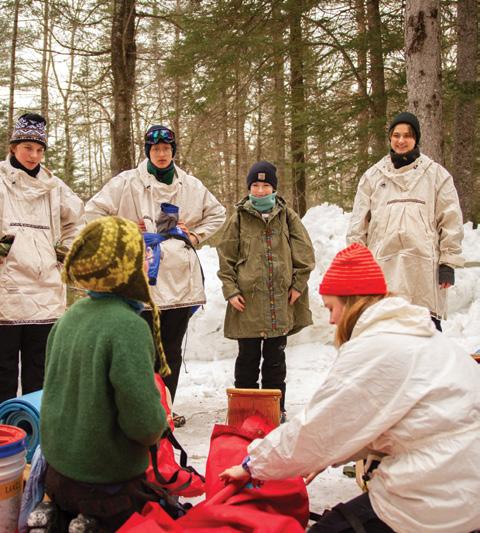

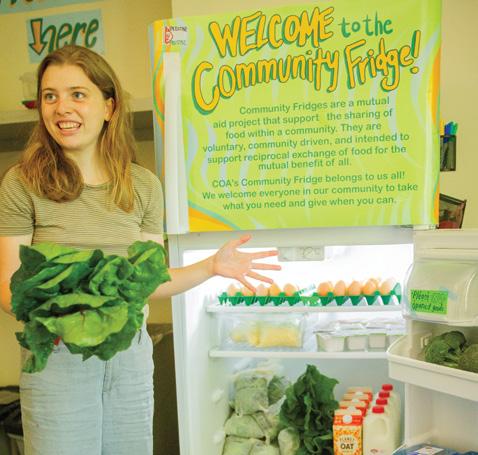
Virginie Lavallee-Picard ’07 & Alexander Fletcher ’07
Caroline Leonard ’01
Lizzie Leone ’93
Otti & Jeffrey Levine
Linda & Jonathan Lewis
Julianna Lichatz ’90
Daniel Lindner, Jr. ’11
Neith Little ’09
Laura Casey ’01 & Benjamin Lord ’99
Haley Harwood Lowell ’11
Andrea Lynn ’90
Blaise Maccarrone ’01
Kate & Ben Macko ’01
Maine Beer Co LLC
Carol & Rick Malone
Chloe Marr-Fuller ’00
Lily McGrath
Linda Parker & Jamie McKown
Megan McOsker ’90
Rebecca Melius ’01
Tree & Scott Mercer
Deb & Bob Milotte, Jr.
Heather & George Mitchell
Chandreyee Mitra ’01 & Eric Shuman
Amanda & Alan Mogridge
Kevin Monahan
Karen & John Moniz
Bethany Murray ’03
Sarah Neilson ’09
Thupten Norbu ’06
Lauren Nutter ’10
Melissa ’91 & Peter Ossanna
Pam Parvin ’93
Susie & Bob Peck
Laura & Vassar Pierce, Jr.
Barbara & Charles Pierce, Jr.
Lisa & Jay Pierrepont
Drake ’03 & Finn ’02 Pillsbury
Jane & Keith ’80 Prairie
Kenneth Punnett ’84
Emily & Mitch Rales
Robin & David Ray (’81)
Lori & John Ricci
Andrea Roberto ’92
Jared I. Roberts
Amy Falls & Hartley Rogers
Mary Ropp ’09
Bissell & Stephen Rosen
Lisa Kay Rosenthal ’09
Eliza Ruel ’13 & Ian Yaffe
Martie & Ed Samek
Jodi Sargent, MPhil ’06 & Family
Rolanda Sarkis ’00
Taj Schottland ’10
Eloise Schultz ’16
Kirsten Schwarz ’00
Lyta & Robert Seddig
Alice
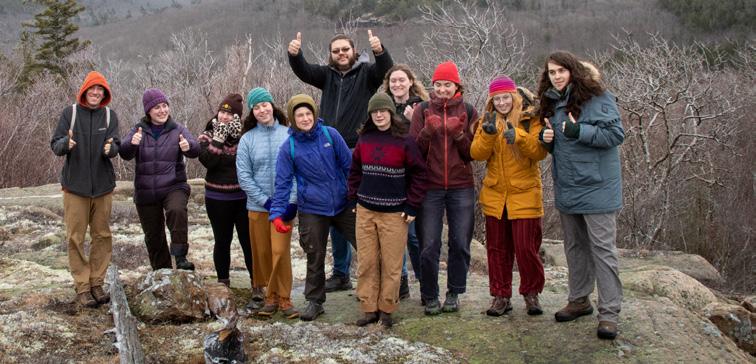
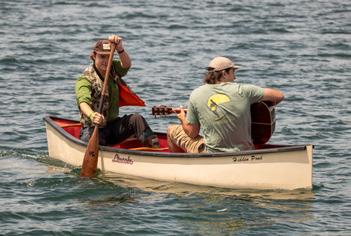


Diane Rosenberg
Lisa Kay Rosenthal ’09
Karla Rusch
Anne Ryan
Addams Samuel ’11
Kerri Sands ’02 & Edward Muennich ’01
Claire & Mike Sasner
Barbara Sassaman ’78
Eloise Schultz ’16
Amy & Ryder Scott ’97
Rosemary Seton
Donna Seymour
Sarah Sharpe
Sonnie Shepherd
Helena Shilomboleni ’09
Erickson Smith ’15
Molly Lanzarotta & Tim Smith
Shoshona Smith ’08
Zachary ’05 & Paige ’06 Steele
Jenifer Stevens
Maddy Stevens ’23
Marie Stivers
Cathy Straka ’82
Silvija Strikis
Anchun Jean Su
Timothea Sutton-Antonucci ’94 & Neal Antonucci ’95
Anne Swann ’86
Scott Swann ’86, MPhil ’93
Courtney Swazey V. Yvonne Tabb
Jasmine Tanguay ’98
Aimee & Jeff Terosky
Ann Walker & Richard Thomas
Julia Walker Thomas ’08
Riley Thompson ’13
Krista Thorsell ’10
Deborah Tiner
Maria Tohn ’17
Magdalena Toran
Carrie Tropasso
Rachael (’05) & Sanjeev ’05 Shah and Family
Allison & Kyle Scot Shank ’14
Helena Shilomboleni ’09
Katy Homans & Patterson Sims
Molly Lanzarotta & Tim Smith
Erickson Smith ’15
Jamie S. Somes
Henry Steinberg ’06
Sidney Stern Memorial Trust
Allison & Steve Sullens
Nonie & John Sullivan, Jr.
Timothea Sutton-Antonucci ’94 & Neal Antonucci ’95
Anne Swann ’86
Douglas Sward ’96
Jasmine Tanguay ’98
Julianne Taylor ’06
Ander Thebaud
Nina Therkildsen ’05
Julia Walker Thomas ’08
Krista Thorsell ’10
Laura Stanton & Kim Tomlinson
Meg Trau-Serrano ’12
Kristen Tubman ’03
Mary Kay Long & Dennis Unites
Caitlin Unites ’03
Kate Unkel ’14
Julia & Hans Utsch
Kathy Vignos
Jennifer Vinck ’93
Shamsher Virk ’07
Luciana Pandolfi ’98 & Luke Wagner ’99
Gail Wartell
HannahMathilde Waschezyn ’13
Carol Weg
Rosalie J. Coe Weir Foundation
Anna Wlodarczyk ’04
Cathleen Wyman
Trudi Zundel ’13
Erin ’04 & Mike ’01 Zwirko
Kristen Tubman ’03
Diane & Charles Tucker
John Twiss
Frank Twohill ’79
Kate Unkel ’14
Alison J. Valley ’81
John Viele (’81)
Jennifer Vinck ’93
Shreya Vinodh ’23
Gail Wartell
HannahMathilde Waschezyn ’13
Wendy Weinrich
Jacob Weisberg ’10
Paul Weisser
Pamela Wellner ’84 & Eugene Dickey (’86)
Jeffrey Wells ’92
Isabel Whiston
Mikayla White
Whit Whitman ’87
Cory Whitney ’03
Joshua Williams
Peter Williams ’93
Nellie Wilson ’04
Joplin Wistar ’84
Laura Fitch & William Witten
Anna Wlodarczyk ’04
Trudi Zundel ’13
GIFTS IN KIND
Anonymous (2)
Bars by the Bay
Elizabeth Chen
Frost Farms LLC
John Grace
National Geographic Society
Ian Nisbet
ORGANIZATIONS AND FOUNDATIONS
Anonymous (4)
Acadia Goldendoodles
Artemis Gallery
Bains Family Foundation
Bar Harbor Bank & Trust
Barnsley Foundation Inc.
The Timothy R. Bass Family Foundation
Paul Bechtner Foundation
Becton Family Foundation
Bell & Anderson, LLC
Bessemer Trust
Blue Hill Co-op
BNY Mellon Charitable Gift Fund
Boston Family Office
Builders Initiative Foundation
The Florence V. Burden Foundation at the recommendation of Foundation Directors Ordway & Jean Burden
The Casco Foundation at Spinnaker Trust
Michele and Agnese Cestone Foundation
Colby College
Community Foundation of Jackson Hole
Community Foundation of New Jersey
Community Foundation of South GA., Inc.
Shelby Cullom Davis Charitable Fund Inc.
Dabones Studios Limited
Dandy Solar Electric
James Deering Danielson Foundation
Davis Family Foundation
Davis Projects for Peace
Davis United World College Scholars Program
E.L. Shea, Inc.
The Eacho Family Foundation
Empower Retirement LLC
The Chandler B. and Oliver A. Evans Foundation
Exelon Foundation
First National Bank
The FJC Fdn of Philanthropic Funds
Fore River Foundation
The Fourth Corner Foundation
Friends of Acadia
Galyn’s Galley
Garden Club of Mount Desert
Good Hope Family Foundation
Google LLC
Harris Family Fund of Princeton Area Community Foundation
John W. and Clara C. Higgins Foundation
Institute of Museum and Library Services
J.P. Morgan Charitable Giving Fund
Raymond James Charitable
The Howard Johnson Foundation
The Janet Stone Jones Foundation
Stephen and Tabitha King Foundation
Machias Savings Bank
Maine Beer Co LLC
Maine Coast Sea Vegetables
Maine Community Foundation
The Nelson Mead Fund
MELMAC Education Foundation
William A. Meyer Jewish Community Foundation
The Gerrish H. Milliken Foundation
The Susan and Robert Nathane, Jr. Charitable Fund at East Bay Community Foundation
National Geographic Society
National Philanthropic Trust (NPT-UK)
Nautilus Foundation Incorporated
Newman’s Own Foundation
Newtmont Foundation
Northern Trust
Carl and Lily Pforzheimer Foundation, Incorporated
GIFTS OF TIME AND TALENT
Elwood R. Quesada Educational Foundation
Renaissance Charitable Foundation, Inc.
Rockefeller Family Fund
Cornelia Cogswell Rossi Foundation
The Sims/Maes Foundation, Inc
Diana Davis Spencer Foundation
Sidney Stern Memorial Trust
Marion Boulton “Kippy”/ Stroud Foundation
The Swan Agency - Sotheby’s International Realty
Charles B. Sweatt Foundation
The Synergy Foundation
Lisa Stewart Target Foundation
The Elm Grove Foundation
Tonamora Foundation
Truist (SunTrust)
Turnbull Family Foundation Inc.
Uplands Family Foundation
Valley Charitable Trust
Versant Power
WaterStone
Rosalie J. Coe Weir Foundation
The WELWE Foundation
Whales and Nails
Yaverland Foundation
Total number of donors = 1,197
While many current students, staff, faculty, and trustees go above and beyond, contributing their time and talent in many ways, those individuals are not included in this list.
Abdullahi Ahmed
Naomi Albert
Becky Anderson
Edwin Barkdoll
Abby Barrows MPhil ’18
Jeff Beedy
Christy and Rob Benson
Deborah E. Bicknell
John Brammer
Kelli Clark
Eric Columber
Brian Cote
Meggie Curtis ’19
Jane Disney
Heather Dority ’96
Brianne Dunn
Amanda Dyer
Rebecca Edmondson
Joanna Fogg ’07
Dave Folger ’81
Rhonda Fortin
Caroline Fournier
Jacquelyn Gill ’05
Elizabeth Giman
Jessie Greenbaum ’89 & Phil Lichtenstein ’92
Julie Hagle
Nicholas Harris ’12
Alisa Hearn
Kim Heist
Carla Hunt
Jim Kadin
Susan Kales & Scott Lawliss
Edith Schriever & Ron Korstanje
Gayle Kraus
Dayana Krawchuk
Katrina Linscott
Yesenia Lipski
Enrique Valencia Lopez ’11
Zeya Lorio ’22
Hannah Lust
Laura Lyell
Carol Shutt & Rocky Mann
Bryan Maurais
Kreg McCune
Chris McGuire
Tara & Mike
McKernan
Danielle Meier ’08
Julie Meltzer & Jonathan Bender
Michelle Merica
Carissa Bielamowicz Miller
Jon Moore
Jordan Motzkin ’11
Laura Muller
Kate Petrie
Abby Plummer MPhil ’16
Cicy Po
Suzen Polk-Hoffses
Destiny Powell ’20
Tonya Prentice
Chandra Raymond
Lewis Redding
Allison Reid
Megan Rilkoff
Dani Robbins
Carol Rosinski
Snow Ross
Siobhan Ran
Jodi Sargent MPhil ’06 & Family
Kate Schlepr ’13
Kim Schroeder
Eloise Schultz ’16
Rachel Singh & Michael Prisco
Brittany Slabach ’09
Jasmine Smith ’09
Jesse Snider ’21
Autumn Soares ’01
Ashley Stanley
Steve Thomas
Thérèse Toohey
Matt Umphrey
Todd West ’00
Bik Wheeler ’09
Rebecca Woods
Ron Wrobel
The Northern Lights Society is an association for individuals who have made planned gifts to benefit COA. These gifts include bequests, charitable gift annuities, and gifts of life insurance, to name a few.
Anonymous (4)
Elizabeth Rousek Ayers ’95
Sandi Read & Ron Beard
Emily Beck & Geof Young
Ann & Fred Benson
John Biderman ’77
Lynn Boulger & Tim Garrity
Norah Davis
Fran Day
Mary K. Eliot
Donna & Gordon Erikson, Jr.
Judith & David Hackett Fischer
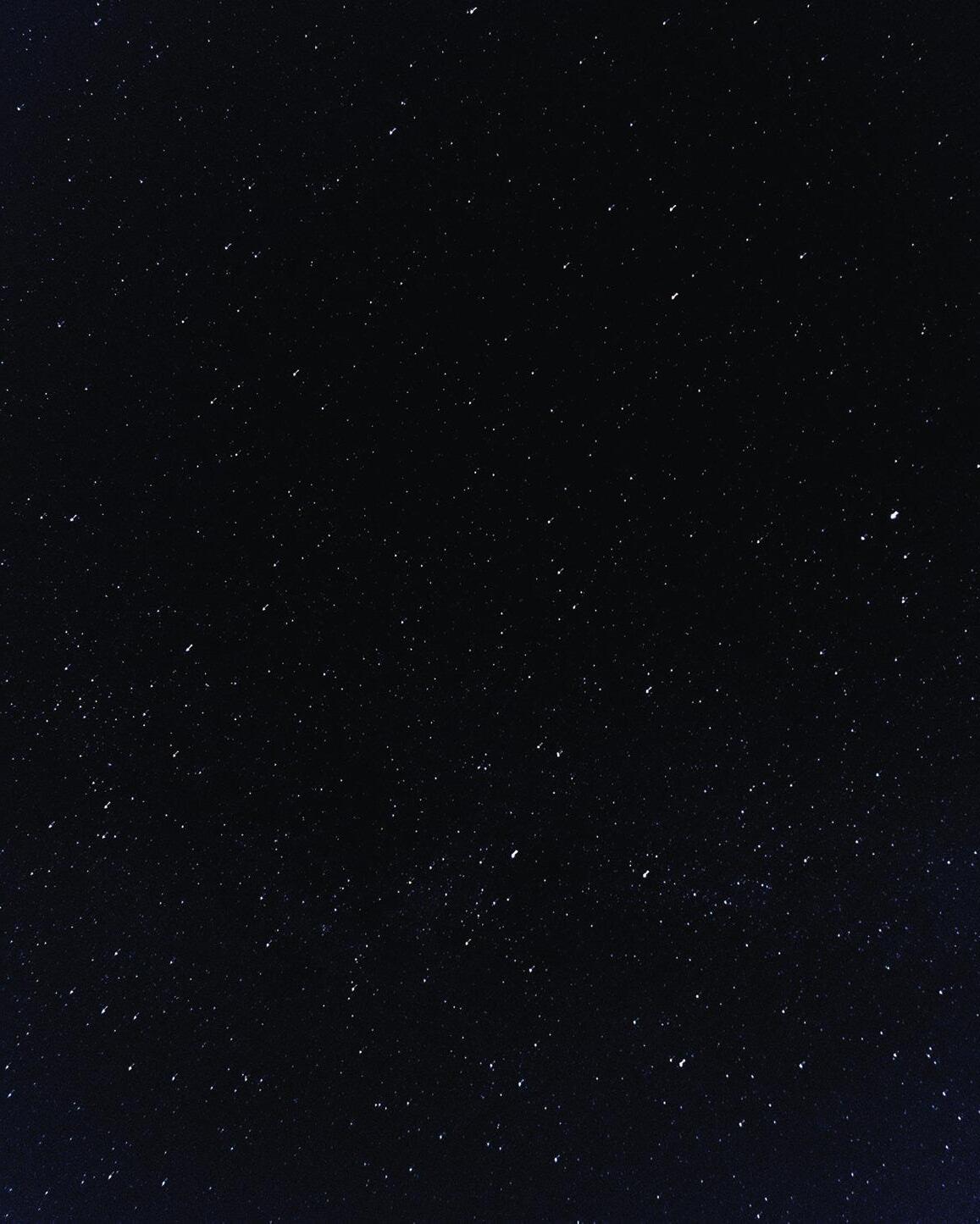
Wendy & Bill Foulke, Jr.
Barbara McLeod & David Hales
Diana & George Hambleton
Sam Hamill, Jr.
Jan & George E. Hartman
Tomoko & Masanobu Ikemiya
Sue Inches ’79
Betsy & John Kelly
Margaret & Philip B. Kunhardt III ’77
Sarah McDaniel ’93
Meredith & Phil Moriarty
Rick Moss ’79
Susan Tieger & Ralph Nurnberger
Linda & Eliot Paine
Debra & John Piot
Roxana & Tony Robinson, Jr.
Karen Rose Steve Ross
Cynthia E. Livingston & Hank L.P. Schmelzer
Ellen Seh (’75)
Stu Summer ’82
Ingrid Sunzenauer
If you have already included COA in your estate plans but do not see your name listed, please contact the Advancement Office to inform us of your gift intentions.
OUR MISSION
College of the Atlantic enriches the liberal arts tradition through a distinctive educational philosophy—human ecology. A human ecological perspective integrates knowledge from all academic disciplines and from personal experience to investigate—and ultimately improve—the relationships between human beings and our social and natural communities. The human ecological perspective guides all aspects of education, research, activism, and interactions among the college’s students, faculty, staff, and trustees.
The College of the Atlantic community encourages, prepares, and expects students to gain expertise, breadth, values, and practical experience necessary to achieve individual fulfillment and to help solve problems that challenge communities everywhere.
OUR VISION
The faculty, students, trustees, staff, and alumnx of College of the Atlantic envision a world where people value creativity, intellectual achievement, and the diversity of nature and human cultures. With respect and compassion, individuals will construct meaningful lives for themselves, gain appreciation for the relationships among all forms of life, and safeguard the heritage of future generations.

If this book has inspired you to learn more about possible investment opportunities, please let us know. Contact College of the Atlantic’s Advancement Office at 207.801.5620.
You can also learn more about College of the Atlantic’s endowment needs or make a gift online: coa.edu/giving.
ADVANCEMENT COMMITTEE
Cynthia Baker, chair
Michael Boland ’94
Beth Gardiner
Amy Geier
George Hambleton
Lissa Hodder
Cookie Horner
Casey Mallinckrodt
Tony Mazlish
Jay McNally ’84
Martie Samek
Laura Stone
Shawn Keeley ’00, dean of institutional advancement (staff)
INVESTMENT COMMITTEE
Steve Sullens, chair
Clay Corbus
Roland Reynolds
Hank Schmelzer
Gifford Combs (advisory member)
Brooke Parish (advisory member)
Bear Paul, administrative dean and CFO (staff)
Missy Cook, controller (staff)
105 Eden Street
Bar Harbor, ME 04609

